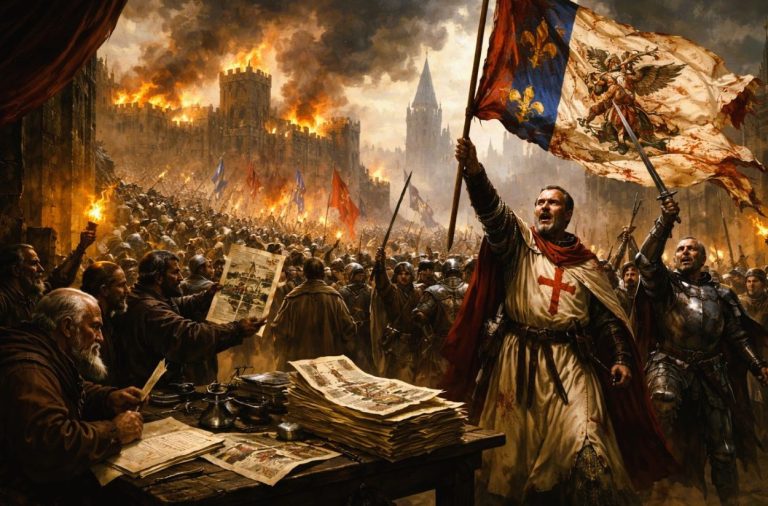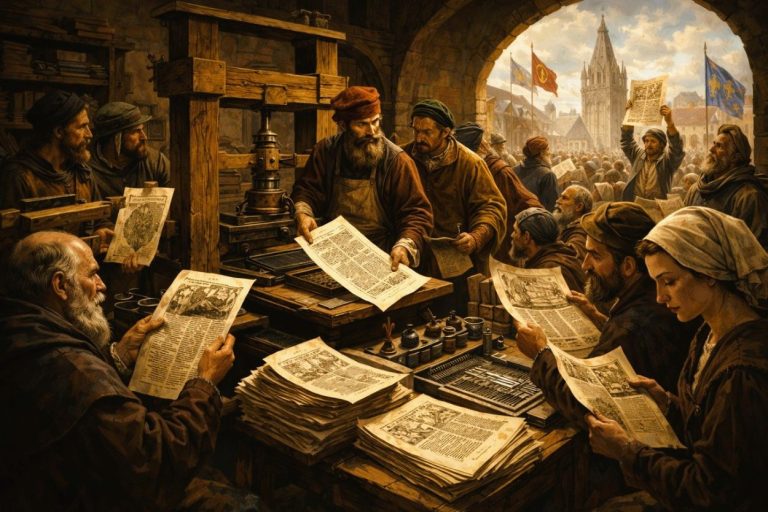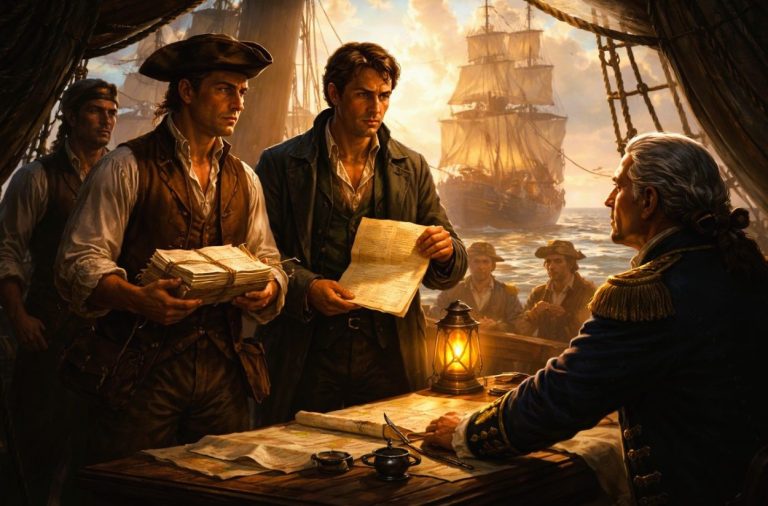
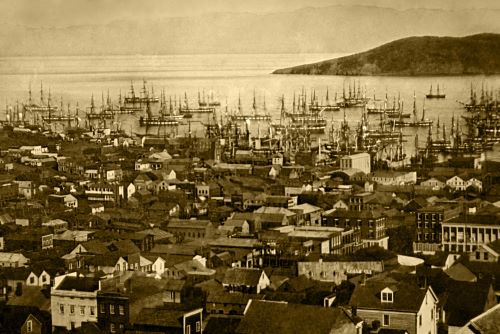
From the Gold rush to the tech boom, people have gone to San Francisco from all directions in search of fortune.
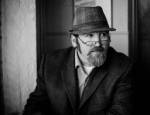
Curated/Reviewed by Matthew A. McIntosh
Public Historian
Brewminate
A Built Environment
Eyewitness Accounts of the 1906 San Francisco Earthquake
Rich and poor, Chinese and white, were suddenly sleeping and eating side by side, to mutual bewilderment.
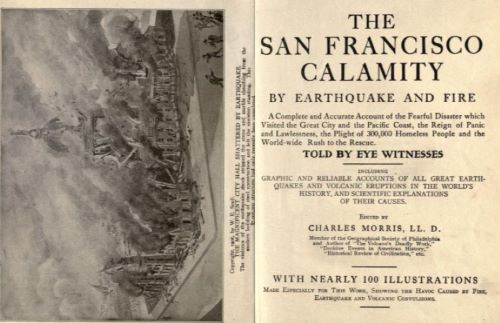
The San Francisco Calamity by Earthquake and Fire (1906) was known in the publishing industry as an “instant disaster book”. This genre coalesced partly because there were so many disasters at the turn of the last century: the 1889 Johnstown Flood; the 1900 Galveston Hurricane; the 1902 eruption of Mount Pelée; the 1903 Iroquois Theatre Fire; the Great Baltimore Fire of 1904; the 1904 burning of the steamboat General Slocum; and finally, the San Francisco Earthquake of 1906, which killed over 3,000 people and destroyed 80% of the city. All of these became topics of books that followed a certain pattern. A journalist was hastily dispatched to the scene, he furiously filed copy, the page count was fattened up with previously published odds and ends, and images were cut in, the more the better. Get the book to market before interest flits away.
The author of The San Francisco Calamity was Charles Morris, though he’s actually credited as editor, an elision that allowed publishers a freer rein on the book’s final components. Morris was a professional writer who published a great number of popular histories, as well as pseudonymous dime store novels. It’s not clear when he arrived in San Francisco from Philadelphia, nor when he finished his manuscript, but his publisher claimed it was a matter of weeks. If the book wasn’t the first account of the earthquake, it was certainly among the first.
The San Francisco Calamity justifies its length with a comparative survey of many other earthquakes, as well as a history of San Francisco, but the heart of the book is a small section that begins about fifty pages in, when Morris directly quotes his stunned interviewees. Their eyewitness accounts are sharp and disjointed, their experience not yet shorn of its surprise. Nothing has been smoothed or strategically forgotten. They describe a pageant of wretchedness, still unfolding.
The billboard advertising beer that was converted into a public message board, and crowded with death notices. Thieves cutting off fingers and biting off earlobes to seize the jewelry of the dead. Shelters made of fine lace curtains and table cloths. Injuries seeping blood, and thousands of people with nothing to wear aside from their pajamas. Some survivors never stopped shrieking and others went comatose. Some refused to be parted with their piano, or their sewing machine, or their canary, or their lover’s body. Garbage wagons toted corpses. The air was thick with the smell of gas and smoke, and dangling electrical wires shot off blue sparks.
READ ENTIRE ARTICLE AT THE PUBLIC DOMAIN REVIEW
Untimely Futures
In Oakland, California, when it comes to Black homelessness and dispossession, dystopia is already here.
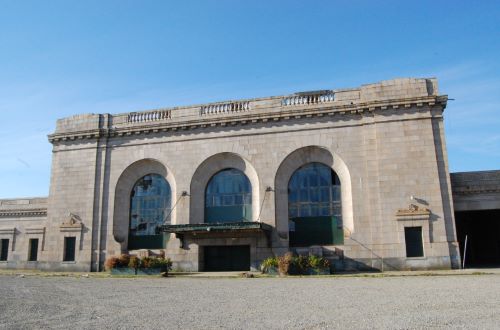
He says calmly, “Look,” gesturing with his languid hand, “Look, I come from one of the oldest cities in the world. The oldest civilization. They build a parking lot and they think that it is a civilization.” Stunned, I burst out laughing. And he joins me. We laugh and laugh and I reply, “True, true.” “The oldest civilization,” he says again. “True,” I repeat.
Dionne Brand, 2001
Imagine, if you will, The Ark, a degraded cruise ship propped on blocks and languishing in an empty parking lot in West Oakland, California, against the backdrop of the I-880 freeway. In the shadow of the ship, the weedy lot is populated by a “tent city” or homeless encampment, an agglomeration of Teslas, tents, and campers. (Yes, Teslas.) Charcoal grills, glass-encased seating pods, and charging stations huddle in the ship’s lee. Wires strung with cheerful pennants stretch down from reactors attached to the ship’s hull to vehicular generators primed for the electric cars scattered throughout the camp. Above, on the sundeck, you can see more generators and a further colorful assortment of tarp-covered tents and patio umbrellas, all framed by strands of pennants. The ship’s hull, like the façade of the adjoining Beaux-Arts train station — built in 1912 as one of three transportation hubs then serving the East Bay, and decommissioned in 1989 — is adorned with graffiti. One of the more prominent tags proclaims in red the anti-capitalist Rousseauian phrase EAT THE RICH, with an accompanying sickle-and-fork emblem.
The Ark (2020) is a photomontage by the artist Olalekan Jeyifous, part of the series “The Apocryphal Gospel of Oakland,” which visually constructs the improbable ongoing story of Oakland’s unhousing crisis through speculative digital collages. The scene depicted in The Ark seems improbable, an allegorical fantasy. Recall, however, that in December 2019, several months before COVID-19 took hold, Oakland’s then-city council president Rebecca Kaplan introduced a plan to dock a decommissioned cruise ship at the Port of Oakland, adjacent to the West Oakland neighborhood. The idea was to provide emergency shelter for nearly 1,000 unhoused individuals.
Oakland’s Port remains one of the busiest in the nation, engineered with a federally regulated infrastructure designed explicitly for cargo ships, making it structurally untenable for docking cruise liners. Even so, Kaplan and her colleagues argued that a “floating hotel” could temporarily address the 86 percent spike in homelessness that Oakland had witnessed between 2015 and 2019. Kaplan noted that cruise ships had been used as emergency housing in the aftermath of natural disasters, for instance following Hurricane Katrina. Homelessness, of course, is an unnatural disaster. But Kaplan’s plan was just one in a long line of attempts to ameliorate the crisis; Oakland and other Bay Area cities have been experimenting since 2015 with other “emergency” proposals, including legalizing tent encampments in specific parking lots and on certain vacant lots.
READ ENTIRE ARTICLE AT PLACES JOURNAL
Demolishing the California Dream: How San Francisco Planned Its Own Housing Crisis
Today’s housing crisis in San Francisco originates from zoning laws that segregated racial groups and income levels.
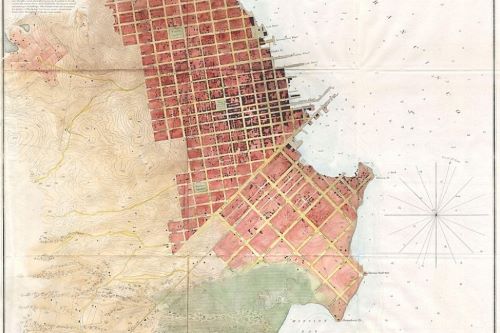
If you want to understand San Francisco’s self-inflicted housing crisis, look no further than the city’s very first zoning law, commonly known as the Cubic Air Ordinance, which set a disturbing standard for the city’s eventual missteps. Proposed in 1870, during a time of rampant real-estate speculation in a boomtown renowned for its lawlessness, the new law required boarding houses to offer a minimum amount of space per tenant. Officials claimed this would promote safer housing and improve residents’ quality of life, a noble cause for government intervention.
But the law’s true purpose—to criminalize Chinese renters and landlords so their jobs and living space could be reclaimed for San Francisco’s white residents—set an ominous precedent. With the Cubic Air Ordinance, city leaders laid the groundwork for 150 years of exclusionary zoning or land-use policy designed to protect the status quo, rather than responsibly manage growth. Often fueled by racism and greed, the dark history of San Francisco urban planning is a story that’s still being told, its latest chapter being the city’s current housing crisis.
For visitors and locals alike, part of San Francisco’s allure is its seeming incongruity: Victorian houses perch on hills near glass skyscrapers, antique cable cars clank up the same streets where new technologies debut. Few realize how profoundly the city’s physical form has been shaped by its planning department, whose best intentions have been overshadowed by efforts to appease the city’s wealthy, well-connected homeowners.
“It is no accident that land is called real estate,” Kenneth T. Jackson wrote in his influential 1985 book Crabgrass Frontier: The Suburbanziation of the United States. “For many centuries, ownership of land has been not just the main but often the only basis of power.” This power was on full display earlier this year, during the debate over California Senate Bill 827, which would have “upzoned” or raised height limits near frequent transit stops. Many neighborhood groups, city councils, and politicians decried the loss of “local control”— “local” being a positive, vaguely artisanal-sounding buzzword used by city progressives who derided the bill as a “one-size-fits-all” solution that would hurt low-income residents.
However, American cities have consistently asserted so-called “local control” to increase inequality, establishing exclusionary zoning laws to prevent the construction of denser multifamily housing, redevelop low-income neighborhoods, and push poorer residents from their communities. In San Francisco, residents have exploited “local control” to make development as difficult as possible by lowering building-height limits, expanding zoning regulation, and increasing the veto power of homeowners. These privileged neighbors have often appropriated low-income residents’ fears of gentrification and eviction to block any new housing, despite the fact that studies have repeatedly shown that in markets with high demand, adding housing of any kind typically helps decrease displacement.
READ ENTIRE ARTICLE AT COLLECTORS WEEKLY
Imagining a Past Future: Photographs from the Oakland Redevelopment Agency
City planner John B. Williams — and the photographic archive he commissioned — give us the opportunity to complicate received stories of failed urban renewal.
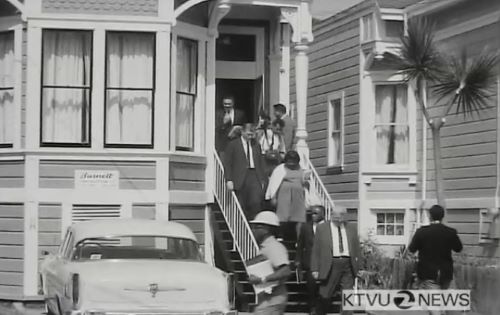
On any given workday in downtown Oakland, thousands of commuters enter and exit the 12th Street City Center station of the Bay Area Rapid Transit, or BART, rushing past a large bronze bust of John B. Williams. The statue, like many memorials, fails to meet its mission: to remind Oakland’s residents who John B. Williams was and what role he played in the city that named its downtown plaza and part of its intercity highway for him. The charismatic director of the Oakland Redevelopment Agency from 1964 to 1976, Williams was once called the most “powerful and effective Black man in city government.” Lionel Wilson, Oakland’s first Black mayor, has noted that before his own election in 1977, Williams had been considered a potential mayoral candidate. He is now difficult to locate in the public record and in the public imagination. But like the bust at City Center Plaza, his legacies hide in plain sight. Williams’s story is central to the history not only of this particular place but also of many communities upended by the urban renewal programs of the mid-20th century.
In 1949, the federal government passed the Housing Act, making funds for urban renewal projects available to many American city governments. Oakland undertook a program of aggressive redevelopment, redlining vulnerable working-class communities to make way for new infrastructure and industry. The city’s African-American community, which had tripled in population in the decades before and after World War II, was disproportionately affected. Racialized housing restrictions confined the majority of this growing community to overcrowded West Oakland — just west of downtown — where the housing stock was increasingly becoming derelict.
A postwar housing crisis brought on by the influx of migrants and loss of wartime jobs resulted in deeply segregated residential neighborhoods across the East Bay. Traditionally multi-ethnic communities (including Mexican, Asian, Portuguese, and Irish families) were transformed as white Oaklanders took advantage of federal loan and mortgage programs — subsidized by the Federal Housing Administration and the Veteran’s Administration — to purchase new homes in the suburbs. Meanwhile, due to discriminatory lending practices, racist zoning laws that restricted African Americans to neighborhoods west of Oakland’s Adeline Street, and low owner-occupancy rates, homes in and around downtown fell into disrepair. This devaluation of property — specifically in West Oakland — coupled with the decline of the city’s commercial district, created anxiety for local officials, who felt especially threatened by the commercial pull of San Francisco following the completion of the Bay Bridge in 1936. In 1959, a sweeping redevelopment plan for West Oakland was unanimously approved by the city council.
READ ENTIRE ARTICLE AT PLACES JOURNAL
As Evictions Loom, Cities Revisit a Housing Solution From the 70s
Proposals giving tenants the right to purchase their building were revived when Covid-19 put renters at risk.
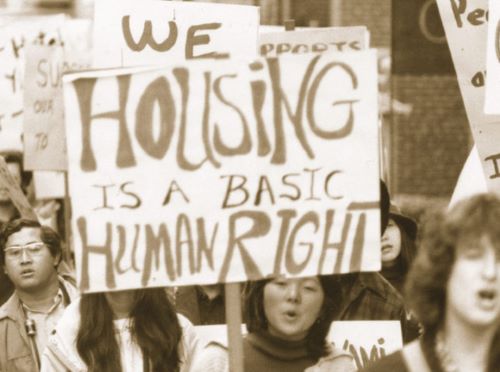
Even before the pandemic rang down the curtain on much of the U.S. economy, times could be tough for the roughly 110 million Americans living in rental housing. For many of them, paying the landlord was a tattered hope and staving off the sheriff’s deputies an endless worry. Nearly 4 million eviction petitions were filed each year. On any given night as many as 200,000 people were without a home.
In the pandemic, losing shelter is an ever-present threat on a far bigger scale, by some estimates potentially affecting upward of 30 million cash-strapped tenants. A calamity of that magnitude has been averted, for now, under a moratorium on evictions imposed through 2020 by the Centers for Disease Control and Prevention. But equitable and compassionate solutions to America’s chronic housing problems will clearly remain an elusive goal long after the coronavirus is conquered.
One method with promise is explored in this video from Retro Report, whose mission is to examine major events of the past for their continuing impact and enduring lessons. The underlying premise is a familiar one: giving people a genuine stake in their apartments and houses by turning renters into owners. The video focuses on two situations separated by half a century: in San Francisco, where the idea was not able to get off the ground, and in Minneapolis, where it has taken flight, albeit with an uncertain future.
The San Francisco story dates to the late 1960s on Kearny Street, in a neighborhood known as Manilatown because of its many immigrants from the Philippines. There, the three-story International Hotel was home to 150 people, principally Filipino laborers who rented rooms for about $50 a month, about $380 in today’s dollars. In 1968 the hotel’s owners handed tenants eviction notices. Developers had begun to reconfigure the city in the name of urban renewal. The I-Hotel, as many called it, was to be razed to make way for a parking lot.
The tenants resisted. They were supported by neighbors, church leaders and community activists like Emil A. De Guzman Jr., then a college student who had lived in the hotel for a while. “The whole struggle came down to just one thing,” he told Retro Report recently. “It became people’s rights over property rights.”
READ ENTIRE ARTICLE AT RETRO REPORT
Privatizing the Public City
Oakland’s lopsided boom.
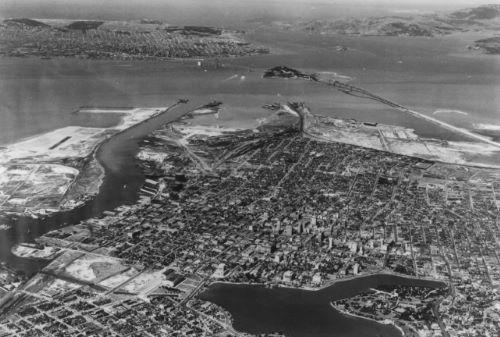
In a recent article in Harper’s Magazine, Kevin Baker looks at a familiar story, the disconcerting transformation of a coastal American city into an enclave built by and for the wealthy. At issue is not simply “the astounding rise in housing prices, disruptive as that is. It is also the wholesale destruction of the public city.” The public city, as he describes it, should be made up of more than residential mega-developments and office towers. It should encompass investment in parks and libraries, subway lines and recreation centers, amenities for all socioeconomic classes. Baker is writing about New York. But he could as easily be discussing the San Francisco Bay Area — certainly San Francisco and, more recently, Oakland, the city where I live and whose urban planning and development I have studied for many years.
It’s not only my own experience that makes Oakland apt as a case study of the public city in jeopardy. In this era of what Baker calls “the urban crisis of affluence,” we need to acknowledge the particular importance of mid-sized cities in the orbit of larger ones, moving past the relentless focus on global megalopolises and attending to the second-tier municipalities where most working people live. Oakland has long been the poor relation across the bay from San Francisco, making it particularly vulnerable to overspill from gentrifying San Francisco, much as it was earlier neglected in the postwar suburban migration. It is, moreover, a fascinating place in its own right, the home of Jack London, Julia Morgan, Gertrude Stein, and Earl Warren, the Black Panthers and Ishmael Reed; where recent mayors have included Jerry Brown (1997-2007) — four-time governor of California. Spared the devastation of the 1906 earthquake, Oakland boasts the Bay Area’s greatest array of building types — from warehouses to office high rises to movie theaters to single-family homes — and vintages — including Victorian, Beaux Arts, Art Deco, and modernist exemplars. In a few years, its densely built, mixed-use downtown may be one of the most active and pleasant in the western United States.
In earlier boom cycles here, market-driven development was accompanied by public investment. Oakland in the 1910s saw the construction of civic buildings like City Hall (1914) and the Municipal Auditorium (1915), spearheaded by Mayor Frank Mott. In the Depression years, a local bond issue augmented by support from the federal Public Works Administration funded the rebuilding of the Alameda County Superior Courthouse (1936), complete with murals and sculpture by Works Progress Administration artists. In the 1950s and ’60s, the Bay Area Rapid Transit District brought together counties on both sides of the bay to plan and build the Bay Area Rapid Transit System, or BART.
READ ENTIRE ARTICLE AT PLACES JOURNAL
Can Reparations Bring Black Residents Back to San Francisco?
San Francisco has proposed the nation’s most ambitious reparations plan, including $5 million cash payments and housing aid that aims to bring people back.
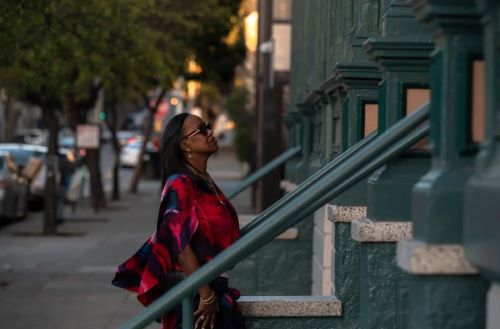
Standing at the stoop of her childhood home — a slim but stately Victorian shaded by an evergreen pear tree — Lynette Mackey pulled up a photo of a family gathering from nearly 50 years ago. The men were all in suits, the women in skirts. Ms. Mackey, a teenager in red bell bottoms, stretched her arms wide and had a beaming smile.
Soon after that time, in the 1960s and 1970s, Ms. Mackey watched the slow erasure of Black culture from the Fillmore District, once celebrated as “the Harlem of the West.” The jazz clubs that drew the likes of Billie Holiday and Duke Ellington disappeared, and so, too, did the soul food restaurants.
By the mid-1970s, many of her friends were gone as well, pushed out by city officials who seized homes in the name of what they called “urban renewal.” Then, finally, her family lost the house they had purchased in the 1940s after migrating from Texas. In many cases, the old Victorian homes were torn down and replaced with housing projects, but the city kept Ms. Mackey’s home standing, and it has since been renovated into government-subsidized apartments.
READ ENTIRE ARTICLE AT THE NEW YORK TIMES
Redlining and Gentrification
Exploring the deep connections between redlining, gentrification, and exclusion in San Francisco.
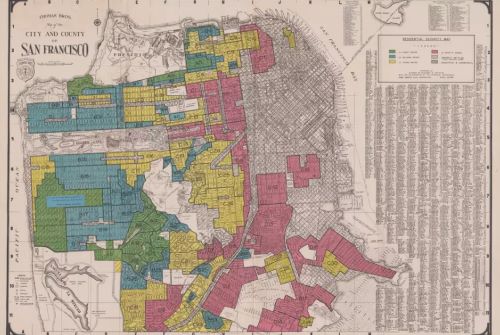
How is a policy that began in the 1930s still felt in American cities? Check out our new video on the long and damaging history of redlining, and its connection to gentrification today.
Redlining was a process in which the Home Owners’ Loan Corporation (HOLC), a federal agency, gave neighborhoods ratings to guide investment. This policy is so named for the red or “hazardous” neighborhoods that were deemed riskiest. These neighborhoods were predominantly home to communities of color, and this is no accident; the “hazardous” rating was in large part based on racial demographics. In other words, redlining was an explicitly discriminatory policy. Redlining made it hard for residents to get loans for homeownership or maintenance, and led to cycles of disinvestment.
This history is not behind us: 87% of San Francisco’s redlined neighborhoods are low-income neighborhoods undergoing gentrification today.
Watch the video to see this connection for yourself, and learn more about the lasting impacts of this discriminatory policy. The past is embedded in the present-day experience of our neighborhoods and cities; it is important to the future of cities that we confront this history.
While this video explores the overlap between redlining, gentrification, and exclusion in San Francisco, these trends are common across the Bay Area. Stay tuned for videos on other Bay Area cities coming soon.
Learn more about redlining, in your community and beyond:
Want to know how your neighborhood was rated by HOLC? Check out the University of Richmond’s “Mapping Inequality” Project for interactive redlining maps.
Want to understand the connection between redlining maps and other data in your community?
- The dataset from University of Richmond’s digitized maps is now on PolicyMap so that users can overlay this polygon data with a number of other layers to explore trends in residential and economic segregation, along with a host of other areas.
- Recent research from NCRC, “HOLC ‘Redlining’ Maps: The persistent structure of segregation and economic inequality,” looks at persistent impacts of redlining in cities across the US — on economic and racial segregation, inequality, and gentrification, as well as exploring regional differences.
NPR’s recent explainer video, “Why Are Cities Still So Segregated?” teases out the connections between redlining and the landscapes of opportunity in our cities — in schools, health, wealth, policing, and more.
SEE MORE AT THE URBAN DISPLACEMENT PROJECT
A Trip Down Market Street before the Fire
This film is a rare record of San Francisco’s downtown area before its destruction in the 1906 earthquake and fire.
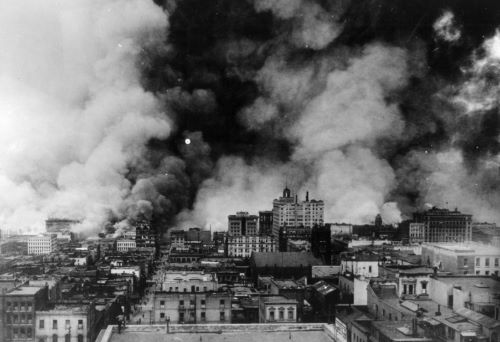
This film, shot from the front window of a moving Market Street cable car, is a rare record of San Francisco’s principal thoroughfare and downtown area before their destruction in the 1906 earthquake and fire. The filmed ride covers 1.55 miles at an average speed of nearly 10 miles per hour. Market Street, graded through sand dunes in the 1850’s, is 120 feet wide, and nearly 3.5 miles long. The street runs northeast from the foot of Twin Peaks to the Ferry Building. According to an April 30, 2010 article in the San Francisco chronicle and in a 60 minutes television segment broadcast on October 17, 2010, silent film historian David Kiehn determined from the depiction in the film of the puddles in the cavities by the rails on the street–and especially autos driving through puddles splashing water–that the film could not have been shot in September 1905 as that month was “bone dry.”
After searching weather reports in a number of San Francisco newspapers, Kiehn learned that no heavy rain was reported until late March and into early April of 1906. Further research uncovered an April 28, 1906 advertisement for the film in the theatrical magazine, the New York Clipper, suggesting that the film was shot on or around April 12, 1906 due to the long lead time for print ads for magazines of the day and the amount of time required to ship the film to New York by train. Kiehn also confirmed that one of cars in the film with license plate number 4867 had been registered in early 1906. An interesting feature of the film is the apparent abundance of automobiles. However, a careful tracking of automobile traffic shows that almost all of the autos seen circle around the camera/cable car many times (one ten times). This traffic was apparently staged by the producer to give Market Street the appearance of a prosperous modern boulevard with many automobiles. In fact, in 1905 the automobile was still something of a novelty in San Francisco, with horse-drawn buggies, carts, vans, and wagons being the common private and business vehicles.
“Produced as part of the popular Hale’s Tours of the World film series, the film begins at the location of the Miles Brothers film studio, 1139 Market Street, between 8th and 9th Streets; it was filmed 14 April 1906, four days before the devastating earthquake and fire of 18 April 1906, which …
SEE MORE AT THE LIBRARY OF CONGRESS
Found Footage Offers a New Glimpse at 1906 San Francisco Earthquake
Nine minutes of newly found footage shows the aftermath of the earthquake that devastated San Francisco in 1906.
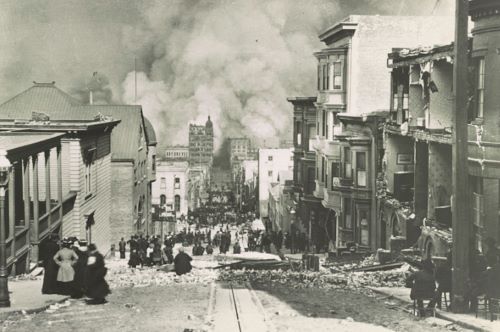
On Saturday night, a small crowd filled a 120-seat theater in Fremont, Calif., to watch a movie unlike any other on the big screen, one that offers a fresh look at a tragic chapter in American history.
The nine-minute silent film, much of it previously thought to be lost, shows the ruins left by the earthquake that ravaged San Francisco 112 years ago, according to David Kiehn, a film historian who helped to identify and restore the footage, which he said was originally shot by the pioneering Miles Brothers film studio in San Francisco.
The rediscovered work is a fitting follow-up to the famous Miles Brothers production “A trip down Market Street before the fire,” which shows the bustling city just days before the earthquake, its inhabitants unaware of the disaster to come on April 18, 1906.
READ ENTIRE ARTICLE AT THE NEW YORK TIMES
Roads to Nowhere: How Infrastructure Built on American Inequality
From highways carved through thriving ‘ghettoes’ to walls segregating areas by race, city development has a divisive history.
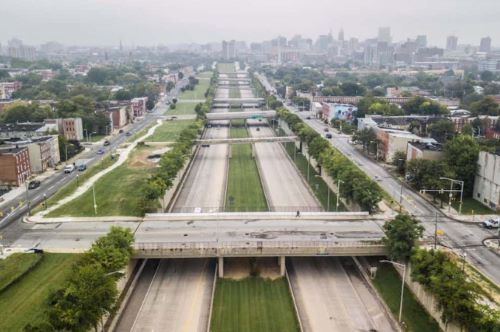
It’s a little after 3pm in Detroit’s 8 Mile neighbourhood, and the cicadas are buzzing loudly in the trees. Children weave down the pavements on bicycles, while a pickup basketball game gets under way in a nearby park. The sky is a deep blue with only a hint of an approaching thunderstorm – in other words, a muggy, typical summer Sunday in Michigan’s largest city.
“8 Mile”, as the locals call it, is far from the much-touted economic “renaissance” taking place in Detroit’s centre. Tax delinquency and debt are still major issues, as they are in most places in the city. Crime and blight exist side by side with carefully trimmed hedgerows and mowed lawns, a patchwork that changes from block to block. In many ways it resembles every other blighted neighbourhood in the city – but with one significant difference. Hidden behind the oak-lined streets is an insidious piece of history that most Detroiters, let alone Americans, don’t even know exists: a half mile-long, 5ft tall concrete barrier that locals simply call “the wall”.
“Growing up, we didn’t know what that wall was for,” says Teresa Moon, president of the 8 Mile Community Organization. “It used to be a rite of passage to walk on top of the wall, like a balancing beam. You know, just kids having fun, that kind of thing. It was only later when I found out what it was for, and when I realised the audacity that they had to build it.”
READ ENTIRE ARTICLE AT THE GUARDIAN
Mobility and Mutability: Lessons from Two Infrastructural Icons
The Embarcadero Freeway and the Berlin Wall exemplified how the politics of mobility reflected the arrangements of power in each society.
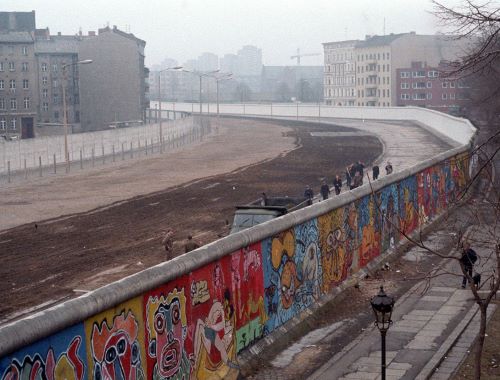
An imposing monument to ideology and power, it stood as a marker of urban division from its construction during the height of the Cold War until its fate was sealed in 1989. Featured in films from noir to arthouse, its austere aesthetics absorbed observers on the scene and around the world. With its grey, alienating appearance, it also attracted no shortage of denunciators. “Oppressive,” one urban design expert opined in retrospect, “does not begin to describe it.” It’s still remembered by history, even if most people now enjoy inhabiting or traversing the public space its absence affords with little thought to this once formidable fabrication.
I refer, of course, to San Francisco’s Embarcadero Freeway.
But this reference also recalls that structure’s infrastructural doppelgänger; Berlin’s infamous edifice was also built to control mobility and to shore up a system of unequally distributed power.
Standing as they did across the same temporal span, the Freeway and the Wall, despite their differences, invite comparison for the lessons they hold. Two of those lessons – that mobility is power, and that nothing lasts forever – might issue from the twentieth century, but they are particularly salient for thinking about the city of the twenty-first.
In Berlin back in the early Cold War days of Conrad Adenauer and Walter Ulbricht, the East German state faced the problem of an unmanageably mobile citizenry. Farmers, artists, academics, and doctors were prominent among those departing across the open border. Between the fall of the Nazis and the rise of the Wall, three and a half million people fled the German Democratic Republic. 1 in 6, in other words, went west.
From 1961 to 1989, the GDR’s solution brought a brutal stability to the situation, with comings and goings strictly controlled. The greatest symbol of the Cold War caught the attention of the world. And as was true of the Embarcadero Freeway, the Berlin Wall also drew the eye of the camera., perhaps most memorably in the moody reverie of Wings of Desire (1987). Though difficult to see at the time, when the angels of that film looked upon the Wall, their faces were turned toward a past that would be radically altered by the political storms of the near future.
READ ENTIRE ARTICLE AT IMPERIAL & GLOBAL FORUM
The Abandoned Houses of Instagram
People lived in these places once. What mysteries did they leave behind?
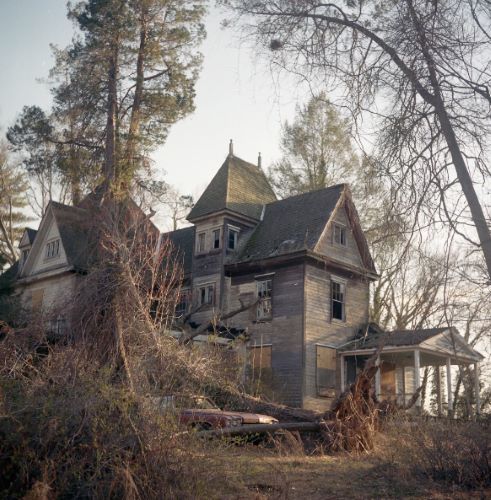
Vines crept up the house. It looked like it was about to cave in. The Colonial in Roscoe, N.Y., a hamlet of the Catskills, was decrepit — which made it all the more appealing to Bryan Sansivero, 36, and a friend, who had arrived before dawn. They entered the musty, empty dwelling, which was not really a dwelling because no one dwells there, and sat in the dark for about half an hour until sunrise.
Soon, the living room was aglow and its contents revealed: antique furnishings, a fireplace with a knickknack-lined mantel, and, most shockingly, a tiger skin rug (the creature’s mouth agape) and a hunting rifle. “We were like, this house is insane. How is this just sitting here and completely abandoned like this?” Mr. Sansivero said.
Despite the dilapidated condition, including peeling walls and an unpleasant kitchen, the house was in pretty good shape. He snapped photos and later shared them in a Facebook group dedicated to old houses, where his posts stir emotions ranging from nostalgia to sadness to skepticism that the house was actually found in that condition (Mr. Sansivero said that the houses’ belongings have typically been staged by previous visitors but that he only makes minor adjustments).
Mr. Sansivero is a professional portrait photographer by trade, but taking pictures of abandoned houses has been a passion of his since college, when he majored in filmmaking and shot a documentary short film about an abandoned hospital on Long Island. His eyes were opened to the mysterious world of such properties.
His attention shifted to houses when he visited family in Pennsylvania and took stock of how many abandoned ones there were in the rural areas. “I became fascinated,” Mr. Sansivero said. “Just going to time-capsule homes where it’s like the family just disappeared.”
He’s been to hundreds of abandoned houses, but only a few make it onto his Instagram feed. “It has to have a moody kind of light,” Mr. Sansivero said. “It has to be colorful, which I think draws in the viewer. It’s eye-catching.” And, he said, “I tend to really like unusual items that are left behind.”
Online, people are attracted to a broad range of abandoned houses. Sometimes it’s a country house standing forlornly in a field, or a mansion in Ontario where the focal point is the architectural details, or a house in Nantes, France with an Old World vibe. In the Facebook group “I Love Old Houses and Gardens,” posts dedicated to abandoned houses can draw thousands of reactions. People have long loved creepy things and even sad things, and these houses hit those notes and more.
READ ENTIRE ARTICLE AT THE NEW YORK TIMES
Economy and Labor
How Could ‘The Most Successful Place on Earth’ Get So Much Wrong?
A new book conjures the complexity of the Bay Area and the perils of its immense, uneven wealth.
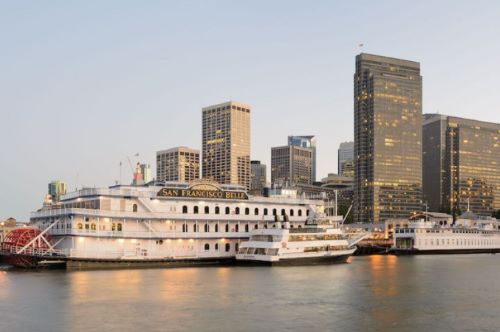
Pictures of a Gone City is the culmination of the life’s work of Richard A. Walker, a professor emeritus of geography at the University of California, Berkeley. A student of the great Marxist geographer David Harvey, Walker brings a profoundly historical approach to his scholarship. His lens spans economics, urban design, politics, and the environment, to name just a few of his interests.
Walker’s new book is urban geography for our times. It illuminates the basic crisis and contradiction of the San Francisco Bay Area, which is an example of capitalism at its most innovative and dynamic, and simultaneously the site of severe inequality and failing public policies and infrastructure. Walker has lived and worked in the Bay Area for most of his life. I was delighted to speak with him about topics ranging from the real geographic definition of the Bay Area, to its history of innovation (stretching back to the Gold Rush days), to the contemporary movements that might help the Bay Area reclaim its radical roots.
In the 1950s postwar era, when the Beats were going strong, and right through the 1960s, San Francisco was remarkably cheap, actually, because it wasn’t as in demand as New York. So people could find places to rent in North Beach, which now is regarded as very luxurious. What [happened] is, around 1970, there’s an inflection point where prices in California in general take off and start to outrun most of the rest the country. And then there’s another inflection point around the 1990s.
READ ENTIRE ARTICLE AT BLOOMBERG CITYLAB
Docking Stations
A conversation with historian Peter Cole about his recent book, Dockworker Power.
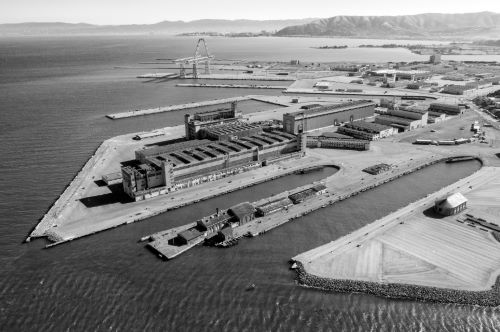
For hundreds of years, and through today, overseas shipping has been the primary method of global trade. During most of that time, the loading and unloading of cargo involved hundreds of workers manually hauling crates — that is, until containerization revolutionized the industry. Beginning in the 1960s, shipping companies adopted standardized containers, which could seamlessly be lifted from trucks onto ships with enormous cranes and unloaded the same way. Suddenly, the number of workers necessary for a dock’s efficient operation dropped exponentially.
Historian Peter Cole’s recent book, Dockworker Power, tells the story of how two different groups of workers — the International Longshore and Warehouse Union’s Local 10 in the San Francisco Bay Area, and formally unorganized, but radically minded dockworkers in Durban, South Africa — dealt with the automation of their industry. Being formally organized and relatively powerful, ILWU’s Local 10 was able to negotiate what amounted to substantial retirement packages for its redundant members; being unorganized and clenched in the fist of apartheid, Durban dockworkers were not able to win such concessions.
These histories provide two paths for workers everywhere who are threatened by automation — the organized winning compromises, the unorganized swept aside — but the most interesting route is the road not taken. Even after Local 10’s supposedly successful negotiations, some union members questioned if further radical conflict, rather than compromise, would not have served them better by preserving their power, rather than selling it.
READ ENTIRE ARTICLE AT THE SMART SET
Martin Luther King Jr., Union Man
Most people think of Martin Luther King Jr. as a civil rights leader. What many don’t know is that he also championed labor unionism.
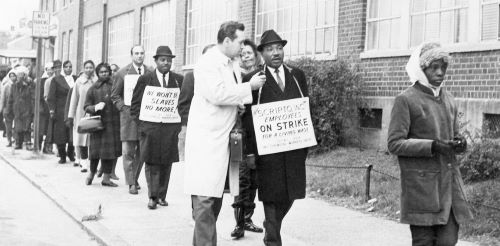
If Martin Luther King Jr. still lived, he’d probably tell people to join unions.
King understood racial equality was inextricably linked to economics. He asked, “What good does it do to be able to eat at a lunch counter if you can’t buy a hamburger?”
Those disadvantages have persisted. Today, for instance, the wealth of the average white family is more than 20 times that of a black one.
King’s solution was unionism.
In 1961, King spoke before the AFL-CIO, the nation’s largest and most powerful labor organization, to explain why he felt unions were essential to civil rights progress.
“Negroes are almost entirely a working people,” he said. “Our needs are identical with labor’s needs – decent wages, fair working conditions, livable housing, old age security, health and welfare measures, conditions in which families can grow, have education for their children and respect in the community.”
My new book, “Dockworker Power: Race and Activism in Durban and the San Francisco Bay Area,” chronicles King’s relationship with a labor union that was, perhaps, the most racially progressive in the country. That was Local 10 of the International Longshoremen’s and Warehousemen’s Union, or ILWU.
READ ENTIRE ARTICLE AT THE CONVERSATION
A Brief History of the Gig
The gig economy wasn’t built in a day.
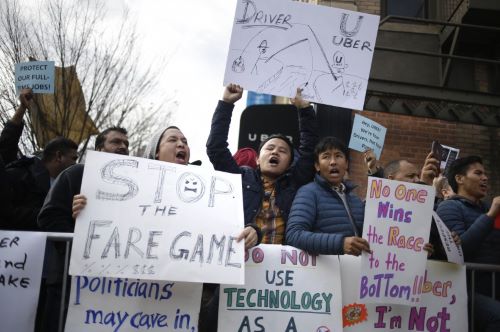
In early 2012, San Francisco taxi drivers began to raise the alarm at organizing meetings and city hearings about “bandit tech cabs” pilfering their fares. “I’ll sit at a hotel line, and I see one of these guys in their own car come up, hailed by some guy’s app, and they’ll turn down my fare,” Dave, who had been driving a taxi for fourteen years, said at a meeting that April. “They steal it. It’s insulting.” Other cabbies said they were seeing the same thing, and that their income was suffering as a result. “I think I made 20 percent less last week than normal,” one driver lamented. He wanted city officials to know; surely, they would put an end to it.
These taxi workers were experiencing the very earliest stage of a global re-organization of private and public transportation, fueled by billions of dollars of financing from venture capitalists. Under the shadow of the Great Recession, in a period of high unemployment and slow job growth, Uber, Lyft, and their erstwhile competitor Sidecar used this technocapital to begin offering almost anyone with access to a car a way to make money by driving people around San Francisco. The companies aggressively marketed themselves as disruptors of the transportation industry; consumers and commentators, seduced by on-demand, technology-fueled mobility and the prosocial promise of what the companies called “collaborative consumption,” enthusiastically adopted their narrative.
Cabbies, however, saw Uber and Lyft as well-financed corporate continuations of the taxi companies that had long subjugated them. “This isn’t about technology,” Mark, a long-time taxi worker and advocate told me in 2013. He explained that, for the previous few years, San Francisco taxi drivers had already been using an app called Cabulous, which essentially did what Uber and Lyft were doing. “They claim they’re innovative and new, but we already have this technology,” he went on. What was different, Mark described, was that Uber and Lyft had “a new exploitative business model,” though it was just “one step removed from the leasing model that the taxi companies have been using for years.”
Since 2012, much of the positive discourse around Uber and Lyft has continued to regurgitate the notion that these are companies built on technological innovations that brought new forms of transportation to people and places who needed them. Meanwhile, critiques of these companies, and of the gig economy as a whole, have typically seen Uber and Lyft as breaking sharply from earlier modes of employment to create new forms of precarity for workers. In both cases, the public discussion tends to see these companies as creating major discontinuities, whether of technology or of labor models. What Mark pointed out, however, is that Uber and Lyft are in many ways not as different as we tend to think from the taxi companies that prevailed until 2012.
In 2020, almost a decade after the advent of Uber and Lyft, we seem to be at another turning point. The ride-hailing industry is facing a wave of militant self-organizing and claims to employment status by drivers. So far, the most significant mobilization has been the fight over AB5, a California assembly bill that was signed into law in September 2019, and which makes it much clearer that drivers should be treated as employees of Uber and Lyft. The companies have fought this reclassification in myriad ways, and some drivers fear that it may cause them to lose their flexibility. But those who have welcomed the passage of AB5 hope it will deliver them many of the benefits—from healthcare to a guaranteed minimum wage—that Uber and Lyft have so far denied them. On all sides of the issue, no one doubts that we are at a critical juncture in the history of labor and urban transportation.
But in order to sort through the arguments surrounding AB5 and grasp the significance of this moment, we must do something that the discourse around ride-hailing has failed to do: situate ourselves historically, tracing both the continuities and the discontinuities that the cabbie Mark pointed to. Our present moment is largely the product of two neoliberal shifts in the taxicab industry—and, in a certain sense, in US society as a whole—that occurred in the late 1970s and the 2010s. Understanding the reasons for these shifts can help us get beyond the easy assumptions made on different sides of the debate: that employee status is an unalloyed good or ill, that innovation made the rise of Uber and Lyft inevitable, or that the issues raised by the sector are matters of technology rather than politics.
Few people understand those reasons better than the drivers themselves—though, like other workers, they rarely have their voices centered in public discourse. By listening to drivers’ accounts of how their industry operates and has changed, we can come to understand how and why, despite some fears and ambivalence, they are using employee status to create a much-needed friction in the wheels of technocapital.
READ ENTIRE ARTICLE AT LOGIC(S)
How a War Over Eggs Marked the Early History of San Francisco
Competition over eggs on the Farallon Islands in the midst of the California Gold Rush in San Francisco led to an all out war between eggers.

Egg dishes are a flavor of home. We want them the way our fathers or mothers or grandparents made them. An egg conjures memories of learning to cook for many of us, since making eggs is perfect for teaching a kid. Even if one disdains a straight scramble, the egg is a key ingredient in many comfort foods, including pancakes and birthday cake.
For all these reasons, eggs carry a certain nostalgia. They remind us of paradise lost—the childhood that is done, the beloved elder chef who is buried, the metabolism that once tolerated syrupy breakfast carbs. And nostalgia has power. Would you kill to return to a yolk-kissed moment when a caregiver served up love on a plate? Some men would. And, indirectly at least, some men did during the Egg War of the Farallon Islands.
The Egg War began unofficially in 1848 with the Gold Rush. San Francisco started the year with a mere thousand souls, but over the next twelve months the population rose to twenty-five thousand. The city experienced scarcities of women and of food, particularly protein. Scaling up farms to provide for the local population proved harder than it seemed. Nobody could get large groups of chickens to survive there, and the technical solutions to this problem were decades off. Without chickens, of course, there could be no eggs. And without eggs, there could be no cakes, morning scrambles, pancakes, puddings, or muffins. As Napoleon once put it, “An army marches on its stomach,” and a rootin’-tootin’ army of miners in the Wild West doubly so.
As gold poured into the city, the prices for fresh eggs skyrocketed. Out in the field, a single chicken egg might sell for $3, while in the city that same egg fetched the still exorbitant price of $1. Even without accounting for inflation, $12 to $36 per dozen eggs is ridiculously expensive. If we account for inflation, the miners paid something astounding—more like $427 to $1,282 per dozen. This explains the origins of Hangtown Fry rather well. According to legend, a guy who had struck gold wandered into the El Dorado Hotel in the mining supply camp of Hangtown (so nicknamed for its penchant for stringing up criminals). He threw down a bag of gold and demanded the most expensive meal the chef could make—which turned out to be oysters and eggs. If someone could bring good fresh eggs to San Francisco Bay, he would more than make his fortune.
READ ENTIRE ARTICLE AT LITERARY HUB
What California Cuisine’s Past Tells Us About Its Future
Into the 1980s, the heart of the California food revolution was also a hub of French fine dining. Why did the goat cheese and sundried tomatoes win?

California, if you’re going to spend over $100 for two on a night out — maybe more like $200 these days — the experience must meet certain expectations. The produce should be fresh and seasonal, sourced from your city’s flagship farmers market. The flavors of a dish should come from light sauces, unexpected herbs or chiles, the smoke of a grill, and most importantly, the key ingredients themselves. The presentation should be unfussy and stylish, matching the rumpled linens, rare sneakers, and vintage jeans you and everyone else in the restaurant are wearing for the occasion.
It feels wrong to call this cooking all the same type of cuisine. The restaurants that practice it could call themselves Italian, French, Mediterranean, Turkish, Mexican, Vietnamese, or American. But there’s a term that encompasses this approach, even if it’s old-fashioned and outmoded, weighed down by goat cheese and sundried tomatoes and Napa cabs: California cuisine.
Pioneered by Alice Waters and her collaborators, notably Jeremiah Tower, at Chez Panisse in the 1970s, this style of cooking emphasized first and foremost respecting the beautiful ingredients produced by farmers in the Golden State. Today, cooking with local ingredients doesn’t sound particularly innovative, let alone era-defining, but that’s merely a sign of this philosophy’s success.
In fact, it’s difficult to understand how specific this style of cooking is, and how this approach transformed dining out in California and the rest of the country, without looking into the past. The show Great Chefs, which ran on PBS and the Discovery Channel in the ’80s and ’90s, is a surprising find of culinary archaeology. For the uninitiated, every episode of Great Chefs is simply constructed, almost refreshingly so. Each 30-minute segment consists of chefs cooking their own recipes, in their own kitchens, over the course of what appears to be a single shoot. There’s little biographical storytelling, minimal drama, and not a single close-up of tweezers. What the camera captures first and foremost is process. It’s closer to YouTube than Chef’s Table.
The second season of Great Chefs, which aired in 1983, focused on San Francisco, an era and region that calls to mind rustic grilled pizzas, little mesclun salads dotted with goat cheese, and fruits on plates. Instead, the season is a paean to pate. Of the 13 episodes, seven feature chefs who are French or trained in traditional French kitchens. They don’t all cook true haute cuisine, but their food is much closer to the refined, rich, technique-heavy cooking of traditional French restaurant kitchens than the rustic peasant-style French cooking that inspired Waters and others. The chefs featured in these episodes make salmon mousseline and duck liver mousse; they craft marzipan roses and bread baskets made of literal bread; they wield multiple wine-reduced sauces and stuff chicken legs with veal. There is so much straining. None of the food could be described as simple.
New Map Reveals Ships Buried below San Francisco
Dozens of vessels that brought gold-crazed prospectors to the city in the 19th century still lie beneath the streets.
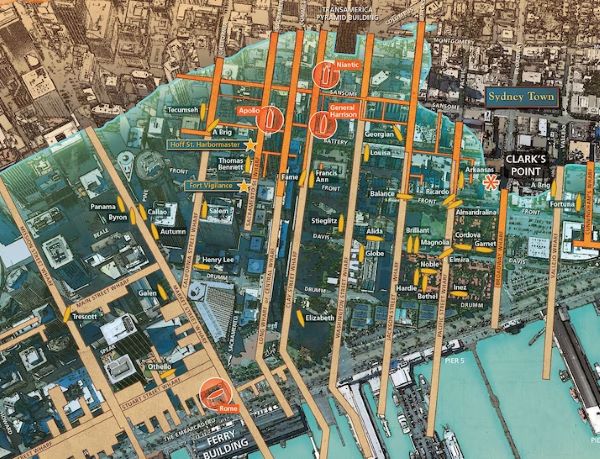
Every day thousands of passengers on underground streetcars in San Francisco pass through the hull of a 19th-century ship without knowing it. Likewise, thousands of pedestrians walk unawares over dozens of old ships buried beneath the streets of the city’s financial district. The vessels brought eager prospectors to San Francisco during the California Gold Rush, only to be mostly abandoned and later covered up by landfill as the city grew like crazy in the late 1800s.
Now, the San Francisco Maritime National Historical Park has created a new map of these buried ships, adding several fascinating discoveries made by archaeologists since the first buried-ships map was issued, in 1963.
It’s hard to imagine now, but the area at the foot of Market Street, on the city’s eastern flank, was once a shallow body of water called Yerba Buena Cove, says Richard Everett, the park’s curator of exhibits. The shoreline extended inland to where the iconic Transamerica Pyramid now rises skyward.
In 1848, when news of the Gold Rush began spreading, people were so desperate to get to California that all sorts of dubious vessels were pressed into service, Everett says. On arrival, ship captains found no waiting cargo or passengers to justify a return journey—and besides, they and their crew were eager to try their own luck in the gold fields. The ships weren’t necessarily abandoned—often a keeper was hired to keep an eye on them, Everett says—but they languished and began to deteriorate. The daguerreotype above, part of a remarkable panorama taken in 1852, shows what historians have described as a “forest of masts” in Yerba Buena Cove.
Sometimes the ships were put to other uses. The most famous example is the whaling ship Niantic, which was intentionally run aground in 1849 and used as a warehouse, saloon, and hotel before it burned down in a huge fire in 1851 that claimed many other ships in the cove. A hotel was later built atop the remnants of the Niantic at the corner of Clay and Sansome streets, about six blocks from the current shoreline (see map at top of post).
A few ships were sunk intentionally. Then as now, real estate was a hot commodity in San Francisco, but the laws at the time had a few more loopholes. “You could sink a ship and claim the land under it,” Everett says. You could even pay someone to tow your ship into position and sink it for you. Then, as landfill covered the cove, you’d eventually end up with a piece of prime real estate. All this maneuvering and the competition for space led to a few skirmishes and gunfights.
READ ENTIRE ARTICLE AT NATIONAL GEOGRAPHIC
Oyster Pirates in the San Francisco Bay
Once a key element in Native economies of the region, clams and oysters became a reliable source of free protein for working-class and poor urban dwellers.
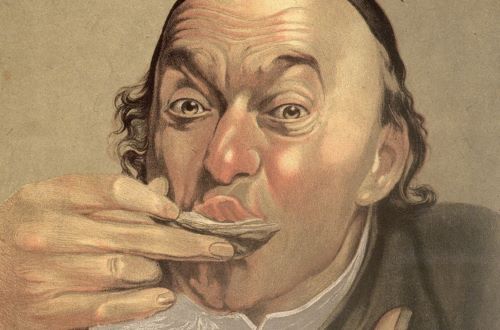
At the start of the twentieth century, there were pirates operating in the San Francisco Bay: oyster pirates. Shellfish had been part of the Indigenous economy before the arrival of European settlers, but commercial oyster farming had become a big industry by the late 1800s. Commercial oyster beds were valuable, and pirates visited by night to steal the oysters in them.
Meanwhile the oyster bed owners had paid for the land and to seed the beds (with East Coast oysters), so they were losing expensive property. It was a challenge for law enforcement, because a purloined oyster looked the same one that had grown on an abandoned bed and was free for anyone to take.
As historian Matthew Morse Booker asks in the Pacific Historical Review, “At stake were persistent questions in American history: Who should have access to natural resources? To whom did the bay belong?”
Once a key element in Native economies of the region, clams and oysters were a reliable source of free protein for working-class and poor urban dwellers. But the arrival of commercial industry blocked private use of theoretically communal resources. And the oysters illustrated a bigger historical issue, beyond the San Francisco Bay. As Booker explains, “Everywhere in the industrializing nineteenth-century world, poor people lost access to traditional common lands and the products they had gathered there. This loss was contested.”
READ ENTIRE ARTICLE AT JSTOR DAILY
The Monkeys and Parrots Caught Up in the California Gold Rush
Researchers combed through 19th-century records and found evidence of the species, which joined a menagerie that included Galapagos tortoises and kangaroos.
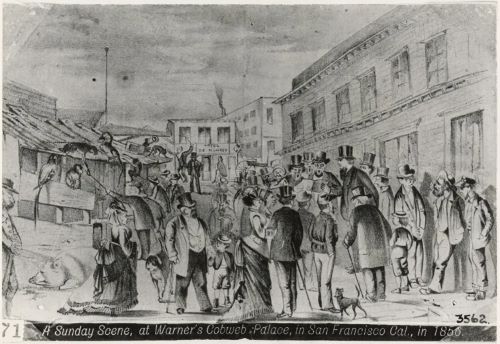
In March 1853, after sailing seven weeks straight from Nicaragua, 5 monkeys and 50 parrots reached San Francisco. Caged on the wharf, chattering and squawking, the animals likely drew a crowd. Perhaps some onlookers gathered to admire the parrots’ plumage, which added flashes of scarlet and lime-green to this spring day. Other folks may have expected the monkeys to put on a show, like the primates they knew from childhood circuses and stories.
The captive creatures wound up as pets and street attractions, meant to entertain San Francisco’s flood of newcomers, who came hoping to profit from the Gold Rush. Some monkeys sported blazers, cranked hand organs and—as one 19th-century newspaper put it—did “all the usual antics performed by monkeys.” Parrots mainly served as pets, so prized that lost birds were reported in classified ads—like a listing from one Mrs. Ross offering a $50 reward (about $1,900 today) for her missing parrot, Pretty Joey Ross.
New research has uncovered evidence of these animals, which were stolen from their wild habitats and hauled to San Francisco in the 1850s. Details on the importers are sparse, but some probably nabbed the creatures, opportunistically, as their ships ferried U.S. East Coasters around the southern landmasses, en route to San Francisco. Other enterprising merchants made trips especially for marketable goods—including live fauna—from Central and South America. To shed light on the animal trade, Cyler Conrad, an archaeologist at Los Alamos National Laboratory and the University of New Mexico, dug through archives of historical documents and archaeological finds. His findings, published in March in Ethnobiology Letters, detailed how city-dwellers used imported monkeys and parrots for amusement.
These unwitting pets now join a growing list of animals affected by the Gold Rush. The list includes Tule elk, a species only found in California that miners hunted from abundance to near extinction. Fewer than 30 elk remained in 1895, and thanks to later laws the population has climbed back to around 5,700 individuals today. Also among the animal causalities, giant tortoises captured live in the Galapagos Islands were shipped to San Francisco and cooked into steaks, stews and pies. At the time, the tortoise numbers were already dangerously low due to whalers’ appetites earlier that century. The Gold Rush demand for tortoise meat pushed the creatures closer to the brink; today they remain on the IUCN Red List of Threatened Species. By adding these animals to Gold Rush history, Conrad and others are rendering a fuller—and grimmer—picture of both the period’s ethos and its ecological toll.
READ ENTIRE ARTICLE AT SMITHSONIAN MAGAZINE
I Retraced the Gold Rush Trail to Find the American Dream
A disenchanted San Franciscan rides west with a motley crew of pioneers.
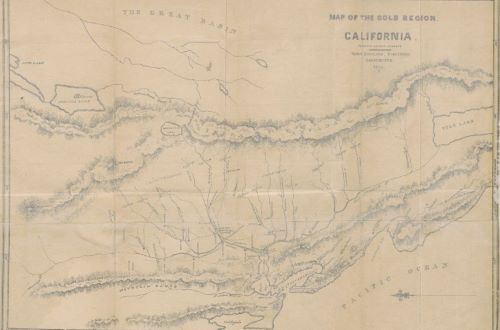
Day 1: Zephyr Cove, Nevada, to Meyers, California
Distance: 13 miles. 22 minutes by car; 6 hours by wagon
The road I traveled was lined with the bodies of dead pioneers. Among the 300,000 mostly luckless treasure seekers, they were the most unlucky, casualties of their own dreams. In 1849 they’d lit out for California, the great prize of the Mexican-American war, after President James K. Polk confirmed that gold was plentiful. His State of the Union speech launched thousands of wagons, the greatest mass migration in American history, and for one week in early summer, I followed their path—at three miles per hour.
The assignment was as exceptional, fanciful, and unsound as my final destination: San Francisco. My beloved city has always attracted risk takers, misfits, dreamers, and entrepreneurs, but the gears in Northern California’s boom-and-bust culture have stalled. Diversity-minded countercultures working toward meaningful change have literally lost ground to a capital-driven tech industry and its outrageous claims about saving the world.
I don’t know what it’s like to see San Francisco as a city making good on the promise of the New World, but I was desperate to find out. Playing at this, like William Faulkner and Shelby Foote’s rumored battlefield visits at Shiloh (fueled by “walking whiskey”), wouldn’t be enough. I could not proceed as a detached or bemused observer. I had to shed my thoroughly cultivated adult cynicism and throw myself into this masquerade with the sincerity of a child. I needed to believe in the dream.
I’m not the only one. This was the sixty-sixth time the Highway 50 Association had led a train of Conestoga wagons, stagecoaches, and horseback riders down “Roaring Road,” one of the major land routes to Gold Country—from Zephyr Cove, Nevada, to Placerville, California—retracing the treasure seekers’ route.
READ ENTIRE ARTICLE AT THE NEW REPUBLIC
The Robber Baroness of Northern California
Authorities who investigated Jane Stanford’s mysterious death said the wealthy widow had no enemies. A new book finds that she had many.
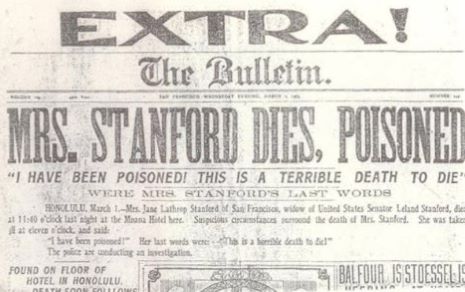
The life of Leland Stanford is the stuff of legend: the journalist Matthew Josephson popularized the term “robber baron” in his 1934 book about Gilded Age capitalists to describe Leland and his peers. “It was said of him that ‘no she-lion defending her whelps or a bear her cubs will make a more savage fight than will Mr. Stanford in defense of his material interests,’ ” Josephson wrote. Others heralded Leland as a talented entrepreneur, his railroads as the engines of American economic progress. Jane Stanford never received such extravagant praise nor such harsh censure. When she died suddenly in a Hawaii hotel room, in 1905, an obituary reported that her greatest happiness was caring for her home. Leland was a mother bear; Jane was just a mother.
That view shaped the investigation that followed her death. When a violent spasm threw her from her bed, Stanford had told the doctor who rushed to her care, “I have been poisoned.” Newspapers widely reported those words, as well as the results of an autopsy that found traces of strychnine in her blood. In the end, though, authorities insisted that Stanford could not have been murdered, for the kindly widow had no enemies. But, as the historian Richard White finds in his engaging new book “Who Killed Jane Stanford?,” she had many.
Jane Stanford’s first biographer was her live-in personal secretary, Bertha Berner. The Berners, a German immigrant family, had moved to Northern California when Bertha was nineteen, for her mother Maria’s health. Shortly after they arrived, in 1884, the Berner family learned of the death of the Stanfords’ only child, Leland, Jr. Attending the funeral, the Berners were moved by the Stanfords’ grief and by the size of the crowd. Bertha Berner wrote to Stanford afterward to offer her dictation services; her mother had observed that the Governor’s wife’s eyes looked “wept blind.”
In “Mrs. Leland Stanford: An Intimate Account” (1935), Berner described her “prominent and much loved” employer as someone who shied away from public attention. The daughter of a wealthy merchant from Albany, New York, Jane Stanford had followed her entrepreneurial husband west to Port Washington, Wisconsin, where he sought to make his way as a lawyer. When a fire destroyed Leland, Sr.,’s legal library, she stood by his side while he re-invented himself in California, first in the railroad business, and then in politics. She also served as a muse for her husband’s innovations—it was supposedly her seasickness on a long trip from Albany to San Francisco via the Isthmus of Panama that inspired Leland to build the transcontinental railroad.
READ ENTIRE ARTICLE AT THE NEW YORKER
When California Went to War Over Eggs
As the Gold Rush brought more settlers to San Francisco, battles erupted over the egg yolks of a remote seabird colony
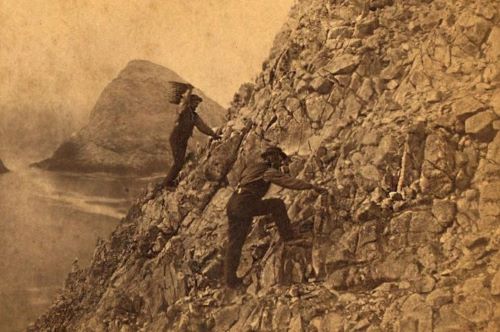
It was the aftermath of the California Gold Rush that instigated the whole hard-boiled affair.
The discovery of gold at Sutter’s Mill in 1848 triggered one of the largest mass migrations in American history. Between 1848 and 1855, some 300,000 fortune-hunters flocked to California from all over the world in hopes of finding gold. Ships began pouring into the San Francisco Bay, depositing an endless wave of gold-seekers, entrepreneurs, and troublemakers. As the gateway to the goldmines, San Francisco became the fastest growing city in the world. Within two years of the 1848 discovery, San Francisco’s population mushroomed from around 800 to over 20,000, with hundreds of thousands of miners passing through the city each year on their way to the gold fields.
The feverish growth strained the area’s modest agriculture industry. Farmers struggled to keep up with the influx of hungry forty-niners and food prices skyrocketed. “It was a protein hungry town, but there was nothing to eat,” says Eva Chrysanthe, author of Garibaldi and the Farallon Egg War. “They didn’t have the infrastructure to feed all the hungry male workers.”
Chicken eggs were particularly scarce and cost up to $1.00 apiece, the equivalent of $30 today. “When San Francisco first became a city, its constant cry was for eggs,” a journalist recalled in 1881. The situation became so dire that grocery stores started placing “egg wanted” advertisements in newspapers. An 1857 advertisement in The Sonoma County Journal read: “Wanted. Butter and Eggs for which the highest price will be paid.”
The scramble for eggs drew entrepreneurs to an unusual source: a 211-acre archipelago 26 miles west of the Golden Gate Bridge known as the Farallon Islands. The skeletal string of islets are outcroppings of the continental shelf, made up of ancient, weather-worn granite. “They are a very dramatic place,” says Mary Jane Schramm of the Gulf of the Farallones National Marine Sanctuary. “They look…like a piece of the moon that fell into the sea.”
Though the islands are inhospitable to humans—the Coast Miwok tribe called them ‘the Islands of the Dead’—they have long been a sanctuary for seabirds and marine mammals. “I can’t overstate the dangers of that place and how hostile it is to human life,” says Susan Casey, author of The Devil’s Teeth: A True Story of Obsession and Survival Among America’s Great White Sharks. “It’s a place where every animal thrives because it’s the wildest of the wild, but it’s a tough place for humans.”
READ ENTIRE ARTICLE AT SMITHSONIAN MAGAZINE
How Private Capital Strangled Our Cities
By following the money, a new history of urban inequality turns our attention away from federal malfeasance and toward capital markets and financial instruments.
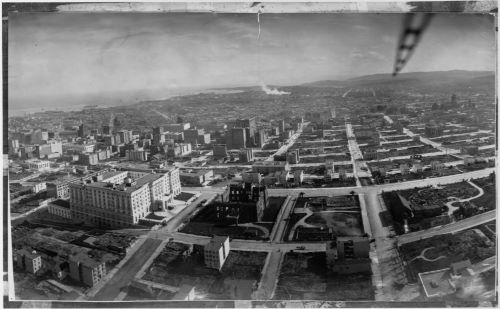
Credit and debt, two sides of the same proverbial coin, place a bet on time. Credit makes money mobile and funds the future. Soon enough, however, it becomes debt, with the lender demanding from the borrower returns with interest that threaten to constrict the possibility of further credit. Personal debt masquerades as moral obligation, a contract freely chosen, yet at the heart of the promise debt creates is not social reciprocity, as the late David Graeber wrote in Debt: The First 5000 Years, but a “simple, cold, and impersonal” market transaction. As nothing more than a “matter of impersonal arithmetic,” debt requires shame and ultimately the threat of force to fulfill its terms and realize the returns for creditors it promises. It lodges coercion at the heart of the supposedly “free” market.
The squeeze is only intensified in the seemingly impersonal world of institutional finance. If debt ensures stability and solvency for some, the economic growth it propels fuels dependency and inequality for others, not only between creditor and debtor but also further down the line, as the borrower passes on the costs of debt to those with less power to control the terms of the deal. This devil’s bargain is particularly true when it comes to municipal debt, argues the Stanford University historian Destin Jenkins in The Bonds of Inequality, his new book on the power the bond market has leveraged over San Francisco and other US cities. The debt-financed spending that cities have long used to spur growth, Jenkins contends, has also underwritten the racial and income inequality of the post–World War II metropolis, while funneling profits to bankers and reinforcing city dependency on finance capitalism. This unequal compact hid in plain sight until the 1970s, when the urban fiscal crises of the era revealed that cities were deeply in hock to financial institutions. But debt was just the way business was done, and banks and other lenders saw no reason to ease the terms of this deal, preferring instead to underwrite the continued hollowing-out of the American metropolitan landscape.
The Bonds of Inequality jumps off from 40 years or so of work by urban historians exposing the platitudes conservatives and liberals used to explain the “urban crisis” that began in the 1960s. Not long ago, the conventional wisdom about urban life in the years after World War II unfurled in a series of overdetermined catchphrases. Cities, peaceful and prosperous through the 1950s and early ’60s, “went downhill” after the riotous “long hot summers” and “white flight” of the late ’60s. The cause of this urban collapse, conservative and liberal piety of the ’80s and ’90s assured us, was not a lack of money in cities but too much: Overeager liberals, looking to usher in Lyndon Johnson’s Great Society with War on Poverty programs, welfare payments, and other instruments of social engineering, supposedly created a permanent “underclass” living in a “culture of poverty.” The only way to end these so-called cycles of “dependency” was, as Bill Clinton did in the ’90s, to “end welfare as we know it” and “get tough on crime.”
Urban historians have long shown these easy judgments to be disconnected from life on the ground. Taking their cues from neighborhood and labor organizers, civil rights lawyers and fair housing campaigners, as well as many in the Black and Latinx community who have resisted the ill effects of this consensus all along, these historians have unearthed the fact that white Americans, working- and middle-class alike, were the primary recipients of postwar government dollars. They followed federal subsidies to the suburbs, while government policy neglected Black and Latinx neighborhoods. Far more important than government welfare was government support for urban deindustrialization, urban renewal and “slum” clearance, highway building, and segregated and underfunded public housing. Less the beneficiaries of federal largesse, Black and Latinx urban dwellers were simply left behind by a postwar welfare state that systematically overdeveloped suburbs and underdeveloped cities, leaving behind the racialized and bifurcated metropolitan landscape of George Floyd’s America.
READ ENTIRE ARTICLE AT THE NATION
What Was It Like to Ride the Transcontinental Railroad?
The swift, often comfortable ride on the Transcontinental Railroad opened up the American West to new settlement.
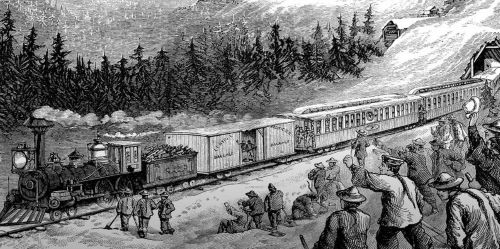
Velvet cushions and gilt-framed mirrors. Feasts of antelope, trout, berries and Champagne. In 1869, a New York Times reporter experienced the ultimate in luxury—and he did so not in the parlor of a Gilded Age magnate, but on a train headed from Omaha, Nebraska to San Francisco, California.
Just a few years before, the author would have had to rely on a bumpy stagecoach or a covered wagon to tackle a journey that took months. Now, he was gliding along the rails, passing by the varied scenery of the American West while dining, sleeping and relaxing.
The ride was “not only tolerable but comfortable, and not only comfortable but a perpetual delight,” he wrote. “At the end of our journey [we] found ourselves not only wholly free from fatigue, but completely rehabilitated in body and spirits. Were we very far from wrong if we voted the Pacific Railroad a success?”
The author was just one of the thousands of people who flocked to the Transcontinental Railroad beginning in 1869. The railroad, which stretched nearly 2,000 miles between Iowa, Nebraska and California, reduced travel time across the West from about six months by wagon or 25 days by stagecoach to just four days. And for the travelers who tried out the new transportation route, the Transcontinental Railroad represented both the height of modern technology and the tempting possibility of unrestricted travel.
READ ENTIRE ARTICLE AT HISTORY
On Upward Mobility
Research shows the neighborhood you grow up in has profound impact on your future economic success. How did my family’s journey across the country impact me?
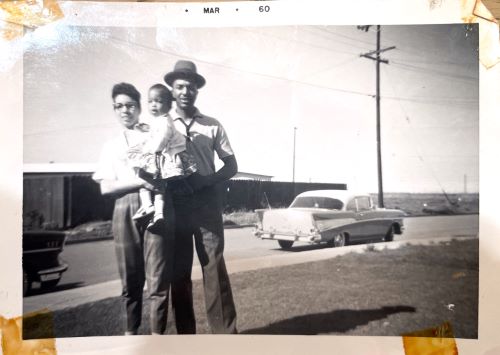
“I don’t think you’d be the same person had we stayed in L.A.,” my mom told me recently. “I wanted you to have better opportunities.”
About a year ago, I moved back to my birthplace, Los Angeles. The move came after six years on the east coast and a desire to be closer to my family.
It’s weird coming back to a place so familiar yet foreign. Despite being born in L.A., and raised just south of the city, I moved to the San Francisco Bay Area when I was 7, rendering Los Angeles a relic of my childhood, a menagerie of foggy memories.
It’s unclear what my mom meant by “better opportunities.” Still, I got the gist that it was about the socioeconomic measures think tanks, policymakers and researchers use to measure progress: education, housing and income.
I thought, “can I actually measure if moving made a difference?” Indeed, your environment impacts your future outcomes, but to what extent?
In March of 2018, Raj Chetty, an economist at Harvard, and a team of researchers sought to estimate upward mobility across socioeconomic lines. Using anonymized Census data and tax records of roughly 20 million Americans, he and his team predicted outcomes for children born between 1978 and 1983 to when they were in their 30s (around 2015).
Among Chetty et al.’s findings was the importance of geographical location.
Research showed that outcomes for children could vary widely even when their neighborhoods were as little as a mile apart. Furthermore, the age at which someone moves profoundly impacts their future earnings but only up until a limit.
I was born in 1989, so I was curious—what were my expected outcomes at birth? And, what would’ve happened had I been born somewhere else?
READ ENTIRE ARTICLE AT THE PUDDING
Nelson Lichtenstein on a Half-Century of American Class Struggle
The esteemed labor historian reflects on his life and career, including Berkeley in the 1960s, Walter Reuther, the early UAW, Walmart, Bill Clinton, and more.
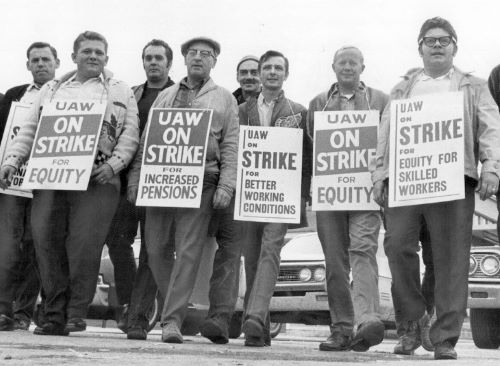
Lichtenstein is among the greatest living American labor historians. In a long conversation with Jacobin editor Micah Uetricht covering his life and career, Lichtenstein discusses his life and education at the University of California (UC), Berkeley, in the midst of that campus’s many eruptions in the 1960s; the intellectual and activist influence of his membership in the International Socialists (IS), a Trotskyist organization; his years studying the early United Auto Workers (UAW) and Congress of Industrial Organizations (CIO); his later turn to studying Walmart and international supply chains; his continued appreciation for radical politics and radical activists organizing, despite leaving Trotskyism behind; his thoughts about the state of labor history; and much more.
Lichtenstein spoke with Uetricht for the Jacobin podcast The Dig in March 2023; you can listen to the episode here. The conversation has been edited for length and clarity.
MICAH UETRICHT
You write in your essay collection, A Contest of Ideas, about being the son of a German Jew who fled the Nazis during World War II and an American mother who fled Mississippi around the same time. You came of age during the civil rights movement era. Is that how you were first politicized?
NELSON LICHTENSTEIN
At the dinner table, my father was sort of a social democrat. My mother was hostile to the Gothic South even before the civil rights movement, but yes, the civil rights movement was a defining moment for everyone in my generation. I didn’t go to Mississippi in ’62 or ’63 but I did end up in Alabama in the summer of ’66. It was extraordinarily important.
My father ran this five-and-dime store in Frederick, Maryland, which is sort of a border state. And you could see the racial dynamics of the clientele and the sales staff. The town was segregated. I came of age just as desegregation was taking place.
READ ENTIRE ARTICLE AT JACOBIN
Immigration
How a California Archive Reconnected a New Mexico Family with its Chinese Roots
Aimee Towi Mae Tang’s Chinese American family never talked about the past. She decided to change that.
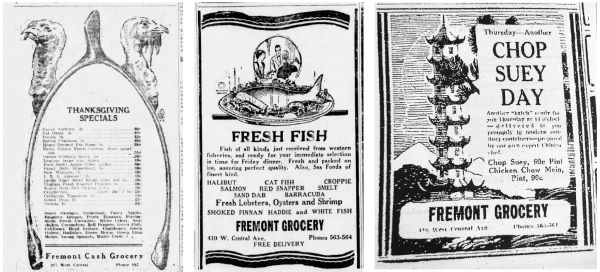
On a bright afternoon in March 2021, Aimee Towi Mae Tang was curled up on her couch in Irvine, California, reading a book she’d chosen for her then-13-year-old daughter Marisol’s homeschool curriculum. Aimee had taken over Marisol’s education, frustrated by the narrow view of the world taught in public school and what she called its “European American bias.” Then a news alert lit up her phone: A gunman had shot and killed eight people at Atlanta-area spas. Six of them were Asian women.
For Aimee, a fourth-generation Chinese New Mexican and a citizen of Jemez Pueblo, the tragedy echoed the discrimination and violence her family has experienced. In the 1930s, state laws barred Edward Gaw, her great-grandfather, from buying land in Albuquerque, New Mexico. During the 1980s, when she was in high school, boys harassed her, shouting a gendered slur common in American films about the Vietnam War. When Aimee saw videos of Asian elders being attacked and beaten in late 2020 during a rise in anti-Asian hate crimes, she thought of her own father, who was then 76.
Three weeks after the Atlanta shootings, I found myself on the phone with Aimee, talking about the nation’s shocked reaction. Aimee’s usually tender voice hardened. “You’ve ignored your cancer for years, and now, at stage 4, you go to the doctors and ask, ‘Oh, how is this happening?’” she said. “Well, come on! If that’s how you’ve treated the Chinese, how is this not happening?”
Aimee’s father and grandparents spoke fluent Cantonese, but her family raised her to fit in with white American society. “We never talk about China. We speak English in our household. We eat Chinese food with a fork and knife,” she said.
READ ENTIRE ARTICLE AT HIGH COUNTRY NEWS
We’ve Been Here Before: Historians Annotate and Analyze Immigration Ban’s Place in History
Six historians unpack the meaning of President Trump’s controversial executive order.
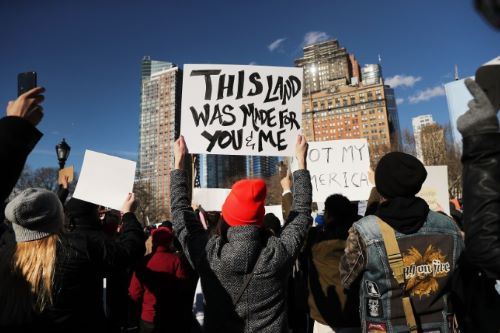
Context matters.
And the context of Trump’s executive orders on immigration are a long history of excluding immigrants on the basis of national origin, political and religious beliefs and in the name of national security.
Enter historians. One week ago, a group affiliated with the Immigration History Research Center at the University of Minnesota and the Immigration and Ethnic History Society created #immigrationsyllabus. It’s an attempt to bring facts and understanding to our current immigration debates. The syllabus is an organized set of readings that brings clarity to a very complex system, but also makes it clear that these debates have been going on since the founding of the United States.
And to be clear, it’s nonpartisan. These are all long-standing, published and peer-reviewed scholars.
These historians have come together again to help us understand Trump’s executive orders on immigration. The order he signed Friday gave federal agencies broad power to detain or deny entry to anyone arriving as a refugee from any country or as an immigrant of any kind from the so-called “countries of concern,” Iraq, Syria, Iran, Sudan, Libya, Somalia and Yemen.
We’ve been covering the effects of the order, perspectives on what it does and what it’s for, as well as the lawsuits that have arisen in result. But here is the order itself, annotated by six historians from universities around the US.
READ ENTIRE ARTICLE PRI THEWORLD
The Photos Left behind From the Chinese Exclusion Era
The California Historical Society contrasts how Chinese people were portrayed in the press with the dignified studio portraits taken in Chinatown.
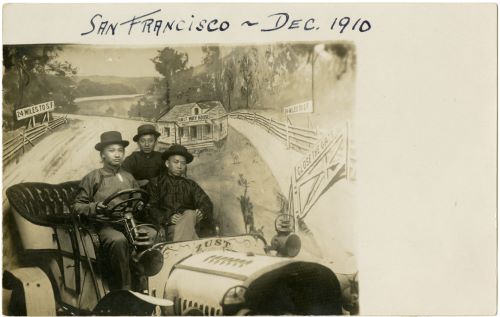
In one room of the exhibition Chinese Pioneers: Power and Politics in Exclusion Era Photographs at the California Historical Society, studio portraits of Chinese people in late-1800s San Francisco share space with candid photos by Arthur Genthe. San Francisco’s Chinatown fascinated Genthe, who would go there, hiding his camera under his coat. Genthe wrote about his subjects as “unsuspecting victims,” and in one of his photos, the subject holds up his hands to shield his face.
Curator Erin Garcia observes how Genthe defined how the subjects were seen, and sometimes went so far as to title them, as in “A Slave Girl in Holiday Attire” on the photo of one woman, and “Young Aristocrats” on a photo of children. In contrast, in the posed studio portraits, the subjects decided how to present themselves.
Garcia wanted to show these sorts of disparities in this visual history of the years around the 1882 Chinese Exclusion Act, a law that banned immigration and prevented people from becoming citizens. In the first gallery of the exhibition, we see editions of the San Francisco Illustrated Wasp, which show racist and grotesque cartoons caricaturizing Chinese people; an issue of the national Harper’s Weekly with a cartoon showing the San Francisco Customs House with a long line of Chinese people; and a lithograph from the Workingmen’s Party of California, with their slogan “The Chinese Must Go!” The party, Garcia says, successfully ran state candidates and spurred anti-Chinese state legislation, which paved the way for the Exclusion Act.
This room also contains another type of studio portrait — cartes de visite, or visiting cards, which were business card-sized and printed on cardstock to be traded with friends and associates.
“I really contrast here these very derogatory images of Chinese people as they were portrayed in the illustrated press especially in the 1870s and in the years leading up to the Exclusion Act,” Garcia said. “I’m contrasting those with these very dignified portraits.”
In the late 1800s, San Francisco’s photo studios were clustered in the downtown area, just blocks from Chinatown, including 16 that were Chinese owned. The small portraits show people with flowers and vases, sitting in chairs, and often wearing fancy dress.
“They’re very conventional in the way they’re seated, and often shown with furniture or a column,” Garcia said. “As time went on, the studios created particular sets for Chinese people with Chinese objects.”
READ ENTIRE ARTICLE AT HYPERALLERGIC
America Was Eager for Chinese Immigrants. What Happened?
In the gold-rush era, ceremonial greetings swiftly gave way to bigotry and violence.
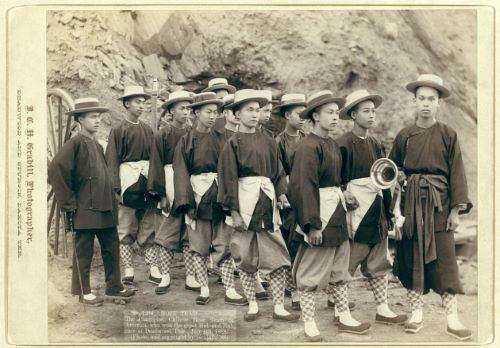
At first, the reception for the Chinese in America was generally positive. In the summer of 1850, city leaders in San Francisco held a ceremony to welcome them. A small group of Chinese immigrants assembled in Portsmouth Square and were presented with Chinese books, Bibles, and religious tracts. The Reverend Albert Williams, of the First Presbyterian Church, who was among the speakers, later wrote that they were united in conveying “the pleasure shared in common by the citizens of San Francisco, at their presence,” and in the hope that more of their brethren would join them in America, where they would enjoy “welcome and protection.” In January, 1852, in an annual message to the state legislature, John McDougal, California’s second governor, called for more Chinese to come. McDougal, a Democrat, had advocated at California’s constitutional convention for excluding from the state certain classes of Black people. But he believed the Chinese could be a source of cheap labor for white Americans. He suggested that the Chinese, “one of the most worthy classes of our new adopted citizens,” could help with the gruelling work of draining swamplands to make them arable. Many California businessmen envisaged a golden age of trade between China and the United States and embraced Chinese immigration as part of that interchange.
As the numbers of Chinese climbed, however, curiosity gave way to hostility in the mining districts. In the spring of 1852, a gathering of miners in the town of Columbia, in the Sierra Nevada foothills, approved resolutions that denounced the flooding of the state with “degraded Asiatics” and barred Chinese from mining in the area. Around the same time, along the banks of the north fork of the American River, several dozen white miners reportedly drove off two hundred Chinese miners, and then, accompanied by a band playing music, headed to another camp to do the same to four hundred more.
Ngai explains that McDougal’s successor as governor, John Bigler, a Democrat facing a difficult reëlection campaign, recognized a political opportunity in the growing anti-Chinese sentiment. In April, 1852, he called on the state legislature to limit Chinese immigration. His speech was filled with racial overtones, alluding to a coming inundation from China and misleadingly depicting Chinese immigrants as coolie laborers, bound by oppressive contracts. Bigler’s tarring of the Chinese as a “coolie race” would prove to be a resilient epithet, becoming a convenient political instrument whenever white Americans on the West Coast needed a racial scapegoat, Ngai writes. The label likened the Chinese to enslaved Black people and, therefore, cast them as a threat to free white labor. Bigler explicitly differentiated the Chinese from white European immigrants, arguing that the Chinese had come to America not to receive the “blessings of a free government” but only to “acquire a certain amount of the precious metals” and then return home. He also doubted that the “yellow or tawny races of the Asiatics” could become citizens under the country’s naturalization laws even if they wanted to. Anti-coolieism, Ngai writes, became a kind of shape-shifting, racist cause.
READ ENTIRE ARTICLE AT THE NEW YORKER
The Forgotten History of the Campaign to Purge Chinese from America
The surge in violence against Asian-Americans is a reminder that America’s present reality reflects its exclusionary past.
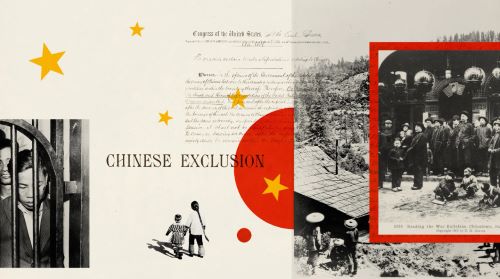
Gum Shan. Gold Mountain. That was what the people in Guangdong Province called the faraway land where the native population had red hair and blue eyes, and it was rumored that gold nuggets could be plucked from the ground. According to an account in the San Francisco Chronicle, a merchant visiting from Canton, the provincial capital—likely soon after the discovery of gold at Sutter Creek, in 1848—wrote to a friend back home about the riches that he had found in the mountains of California. The friend told others and set off across the Pacific Ocean himself. Whether from the merchant’s letter, or from ships arriving in Hong Kong, news of California’s gold rush swept through southern China. Men began scraping together funds, often using their family’s land as collateral for loans, and crowding aboard vessels that took as long as three months to reach America. They eventually arrived in the thousands. Some came in search of gold; others were attracted by the lucrative wages that they could earn working for the railroad companies laying down tracks to join the Eastern and Western halves of the United States; still others worked in factories making cigars, slippers, and woollens, or found other opportunities in the American West. They were mostly peasants, often travelling in large groups from the same village. They wore the traditional male hair style of the Qing dynasty, shaved pate in the front and a braid down to the waist in the back. They were escaping a homeland beset by violent rebellions and economic privation. They came seeking the vast, open spaces of the American frontier—where, they believed, freedom and opportunity awaited.
As the Chinese presence grew, however, it began to stir the anxieties of white Americans. Violence, often shocking in its brutality, followed. America, in the middle of the nineteenth century, was engaged in an epic struggle over race. The Civil War, by the latest estimates, left three-quarters of a million dead. In the turbulent years of Reconstruction that followed, at least two thousand Black people were lynched. Largely forgotten in this defining period of American history, however, is the virulent racism that Chinese immigrants endured on the other side of the country. According to “The Chinese Must Go” (2018), a detailed examination by Beth Lew-Williams, a professor of history at Princeton, in the mid eighteen-eighties, during probably the peak of vigilantism, at least a hundred and sixty-eight communities forced their Chinese residents to leave. In one particularly horrific episode, in 1885, white miners in Rock Springs, in the Wyoming Territory, massacred at least twenty-eight Chinese miners and drove out several hundred others.
Today, there are more than twenty-two million people of Asian descent in the United States, and Asians are projected to be the largest immigrant group in the nation by 2055. Asian-Americans have been stereotyped as the model minority, yet no other ethnic or racial group experiences greater income inequality––or perhaps feels more invisible. Then came the Presidency of Donald Trump, his racist sneers about “kung flu” and the “China virus,” and the wave of anti-Asian attacks that has swept the country.
READ ENTIRE ARTICLE AT THE NEW YORKER
How Chop Suey Saved San Francisco’s Chinatown
For Chinese immigrants, surviving in America has always required intense strategy.
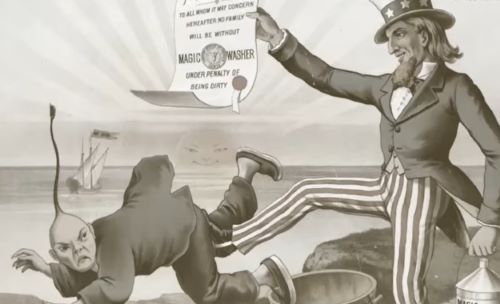
Chinese-Americans have a long history of facing exclusion in the U.S. As a means of survival, many first-wave Chinese immigrants opened restaurants and catered Chinese food to American tastebuds.
Donald Trump Meet Wong Kim Ark
He was the Chinese-American cook who became the father of ‘birthright citizenship.’
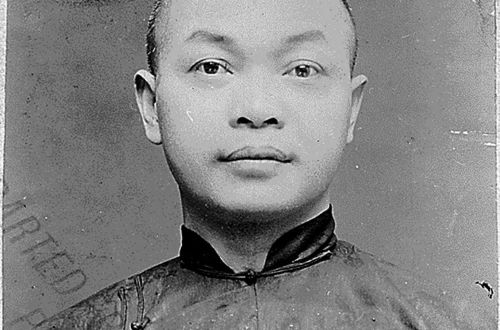
It was the fall of 1895, and Wong Kim Ark was puzzled and alarmed as he bided his time on the steamship Coptic, which floated in the San Francisco Bay after returning him from a visit to China. His papers were in order. He had seen to that. The required statement, certification from white men that he was born in the United States and therefore a citizen, were in order. He had traveled to China for a visit and had little trouble being readmitted.
On this occasion, however, authorities denied him entry, returning him to the ship on which he had arrived, and from there to another ship, the Gaelic, and then to the Peking. For four months, the only certainty to Wong’s life was the tides in San Francisco Bay, where he awaited word of his fate.
What he could not have known was that he was about to become a “test case” brought by the United States government, egged on by a wave of anti-Chinese sentiment, in an effort to undermine the 14th Amendment “birthright” provision, which made Wong a citizen in the first place as the plain and simple language of the amendment said that, “All persons born or naturalized in the United States, and subject to the jurisdiction thereof, are citizens of the United States and of the state wherein they reside.”
For the Chinese in America, this was the “exclusion era,” a radical shift for the United States., which for the most part, since its creation as a republic, had encouraged people to come to its shores. In the beginning, as the country built its railroads, mined its gold and farmed the valleys of Northern California, the Chinese were also welcomed. They streamed in by the thousands.
READ ENTIRE ARTICLE AT THE WASHINGTON POST
How the Bubonic Plague Almost Came to America
A Pompous Doctor, a Racist Bureaucracy, and More. From the book “Black Death at the Golden Gate”.
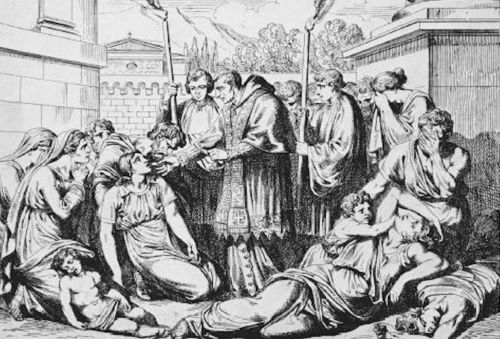
The ship appeared out of the fog at dawn, like a ghost made real.
As it neared Angel Island, sailors hoisted a yellow flag, an international symbol that the ship carried diseased passengers on board. Only when it came closer could Marine Hospital Service personnel make out its name: the Nippon Maru. The ship, which originated in Hong Kong, was already notorious on both sides of the Pacific. It had languished in quarantine at both Yokohama and Honolulu after several of its passengers died of suspected plague on the open seas, but was ultimately cleared to sail on toward the United States. Now weeks behind schedule, it dropped anchor off the main cove of the island, once again tainted by an unexplained death on board.
A doctor from the Marine Hospital Service met the ship and learned that a Japanese woman had died, apparently of plague, two days before the steamer reached San Francisco and had been buried at sea. He then examined the lifeless body of another passenger, a Chinese man who had died the previous day from what appeared to be the same illness. He took tissue samples from the corpse and ordered it cremated, while the remaining 55 passengers were placed under quarantine on Angel Island. A team of Marine Hospital Service men boarded the ship and began washing down its surfaces with boiling hot water, intent on killing any traces of the unidentified disease, while another removed all the luggage and cargo and fumigated it with a mixture of steam and carbolic acid, destroying all clothing in the process.
Kinyoun, who had been the first American to study the newly discovered plague bacillus two years before, raced the tissue samples taken from the dead man to his laboratory, thrilled to once again put his research skills to work after weeks of self-doubt. There, he examined the cells under his microscope and began the slow work of growing them in a culture. Only then would he be able to determine how great a risk the men and women now in quarantine posed to the city. If plague had been on board and was spreading, then any one of the 55 passengers now in his custody would be capable of sparking an epidemic that could kill millions.
READ ENTIRE ARTICLE AT LITERARY HUB
(Counter)Culture
Suddenly That Summer
LSD, ecstasy, and a blast of utopianism: How 1967’s “Summer of Love” all began.
In a 25-square-block area of San Francisco, in the summer of 1967, an ecstatic, Dionysian mini-world sprang up like a mushroom, dividing American culture into a Before and After unparalleled since World War II. If you were between 15 and 30 that year, it was almost impossible to resist the lure of that transcendent, peer-driven season of glamour, ecstasy, and Utopianism. It was billed as the Summer of Love, and its creators did not employ a single publicist or craft a media plan. Yet the phenomenon washed over America like a tidal wave, erasing the last dregs of the martini-sipping Mad Men era and ushering in a series of liberations and awakenings that irreversibly changed our way of life.
The Summer of Love also thrust a new kind of music—acid rock—across the airwaves, nearly put barbers out of business, traded clothes for costumes, turned psychedelic drugs into sacred door keys, and revived the outdoor gatherings of the Messianic Age, making everyone an acolyte and a priest. It turned sex with strangers into a mode of generosity, made “uptight” an epithet on a par with “racist,” refashioned the notion of earnest Peace Corps idealism into a bacchanalian rhapsody, and set that favorite American adjective, “free,” on a fresh altar.
“It was this magical moment … this liberation movement, a time of sharing that was very special,” with “a lot of trust going around,” says Carolyn “Mountain Girl” Garcia, who had a baby with Ken Kesey, the man who helped kick off that season, and who then married Jerry Garcia, the man who epitomized its fruition. “The Summer of Love became the template: the Arab Spring is related to the Summer of Love; Occupy Wall Street is related to the Summer of Love,” says Joe McDonald, the creator and lead singer of Country Joe and the Fish and a boyfriend of one of that summer’s two queens, Janis Joplin. “And it became the new status quo,” he continues. “The Aquarian Age! They all want sex. They all want to have fun. Everyone wants hope. We opened the door, and everybody went through it, and everything changed after that. Sir Edward Cook, the biographer of Florence Nightingale, said that when the success of an idea of past generations is ingrained in the public and taken for granted the source is forgotten.”
Well, here is that source, according to the people who lived it.
READ ENTIRE ARTICLE AT VANITY FAIR
The Long Summer of Love
Historians get hip to the lasting influences of ’60s counterculture.
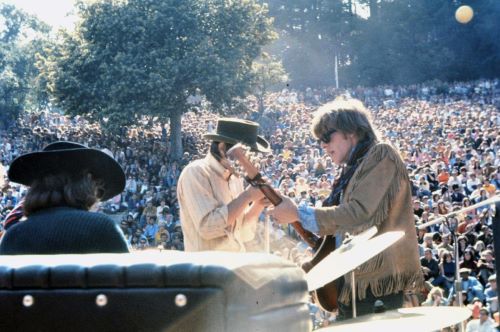
More-nuanced historical scholarship on the counterculture really began in earnest only in the 2000s, following Imagine Nation (Routledge, 2002), a collection of essays by historians including Farber and co-edited by Michael William Doyle, an associate professor of history at Ball State University who was a flower child himself. It remains, to date, the only collection on the counterculture by historians. The scholarship was also influenced by Thomas Frank’s The Conquest of Cool (University of Chicago Press, 1997), which attempted to reframe the counterculture as a movement that right from the beginning sat firmly within the value system of consumer capitalism, and Farber’s The Age of Great Dreams (Hill and Wang, 1994), which argued that the importance and complexity of the counterculture had not been recognized.
The paucity of scholarship stands in contrast to the profusion of works on the civil-rights movement, the women’s movement, and the Vietnam War, over which herds of historians have pored for decades. “The gap is pretty amazing,” said Gretchen Lemke-Santangelo, a historian at St. Mary’s College of California and one of the San Francisco conference’s planners.
One reason for that gap is that the counterculture offers slenderer archival material. As an anti-institutional phenomenon, it never had a defined membership, and many of its products — short-lived underground newspapers, for example — were thrown away. It is also primarily a story about white, middle-class people: It doesn’t really fit in the larger narrative that many American historians have been developing around the making and breaking of equality, said Farber.
Another reason may be that the scholars entering the discipline in the 1970s tended to have backgrounds as activists and focused their scholarship on the political and social movements they had engaged with or admired. A culture of disdain — the New Left had a notoriously antagonistic relationship with the counterculture — then set in. “The idea that the counterculture was fluff, all about sex, drugs and rock ’n’ roll, prevailed until an even younger generation of scholars entered the academy,” said Lemke-Santangelo.
Hippies “seemed (and to many remain) silly and inconsequential,” wrote Alice Echols, a professor of history and gender studies at the University of Southern California, in an email. For a long time, Doyle said in a phone interview, the only people who seemed to accept that the ’60s counterculture had long-lasting, profound effects on American civilization were on the New Right.
Yet what started with a trickle of books in the early 2000s is now a stream. Recent titles include Groovy Science: Knowledge, Innovation, and American Counterculture (Chicago, 2016), edited by David Kaiser and W. Patrick McCray; Judy Kutulas’s After Aquarius Dawned: How the Revolutions of the Sixties Became the Popular Culture of the Seventies (University of North Carolina Press, 2017); and Joshua Clark Davis’s From Head Shops to Whole Foods: The Rise and Fall of Activist Entrepreneurs (Columbia University Press) which was published in August. The Sixties, a cross-disciplinary journal rooted in history and started almost a decade ago, offers a home for scholarly papers.
READ ENTIRE ARTICLE AT THE CHRONICLE OF HIGHER EDUCATION
Where to Score: Classified Ads from Haight-Ashbury
From 1966-1969, the underground newspaper ‘San Francisco Oracle’ became exceedingly popular among counterculture communities.
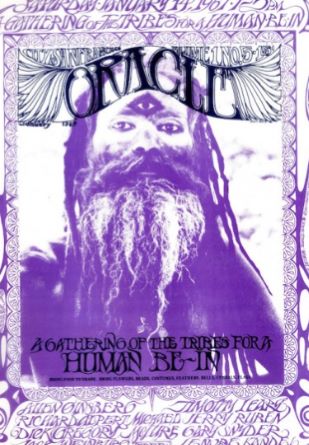
From September 1966 to February 1969, the Oracle of the City San Francisco—better known as the San Francisco Oracle—published twelve issues of poetry, mysticism, and psychedelic art. Produced in Haight-Ashbury, with contributions by Bruce Conner, Rick Griffin, and Allen Ginsberg, among others, the underground newspaper became exceedingly popular among counterculture communities. Its back-of-the-book classified section was full of sexual propositions and pleas. But it was also populated by ads from parents who begged, longingly, that their kids come home, or at least pick up the phone. In Where to Score, a pocket-size paperback coming out later this month, Jason Fulford and Jordan Stein collect the best of these classifieds and present them anew. Here is a selection.
READ ENTIRE ARTICLE AT THE PARIS REVIEW
Dead Kennedys in the West: The Politicized Punks of 1970s San Francisco
The new punk generation made the hippies look past their prime.
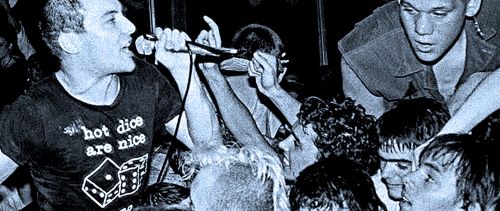
When the Sex Pistols, the signature band of the British punk scene, broke up following their San Francisco concert in January 1978, punk rock entered a new era. The Clash, who went on to become the best of all punk rock bands, had not yet released an album in the United States, so there was no natural successor to the Sex Pistols. It was the moment for US punk, the rumblings of which had become hard to ignore by 1978. Already bands like the Avengers were gaining some fame and followings in the Bay Area, but in early 1978 American punk rock was still primarily based in New York.
Early New York punk bands like Richard Hell and the Voidoids, Television, and the Dictators were reasonably well known in that scene, but the best known of all the American punk rock bands at that time was the Ramones. While the Ramones were a great band that played fast-tempo catchy tunes and helped create the American punk rock gestalt and aesthetic, they were also very much a New York band. The Ramones had their roots in Queens, made their mark at CBGB’s, and had a distinctively New York feel and sound.
This left an opening for San Francisco’s punk rock movement, with its more political feel and West Coast vibe, to become more visible and significant in the broader American context.
The Sex Pistols, who until they broke up were by far the most recognized punk band, had often been as much about marketing as about music, beginning with the name itself. The Sex Pistols always sounded like a name that had come from a Malcolm McLaren-sponsored focus group or company meeting. You can almost picture McLaren throwing names around that combined sex and guns, two ideas that always sell. Other ideas might have been “Whoopie Guns,” “Shag Muskets,” “Shtup Uzis,” or “Screw Rifles.” On balance, “Sex Pistols” was a great name for a punk rock band. It got people’s attention, sounded just intimidating enough, was memorable, and, because of the word “sex,” had some real shock value.
But it did not have the power or shock value of Dead Kennedys, the San Francisco band that was coming together around the time the Pistols played Winterland for the last time. It is difficult to imagine the effect the Dead Kennedys’ name had in 1978. People who knew nothing about punk rock, or even popular music at all, were outraged and offended at the name Dead Kennedys. It was the kind of thing conservative San Franciscans in their thirties and older talked about as a sign of the youth apocalypse.
READ ENTIRE ARTICLE AT LITERARY HUB
What Happened to Rock and Roll after Altamont?
Buzz Poole on the Grateful Dead’s “New Speedway Boogie,” and the true end of the Sixties.
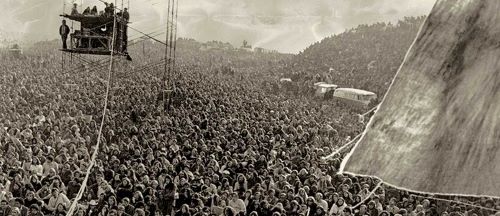
Fifty years ago, in December 1969, the groovy 60s came to an end, both literally and figuratively. After events like the Be-In in San Francisco in January 1967, Monterey Pop Festival in June of ’67, and Woodstock in August of ’69, the Altamont Speedway Free Festival signaled how the cultural and political anxieties that lurked in the idealism of the 60s would manifest the uncomfortable realties that came to define the 1970s.
Of the eight songs on Workingman’s Dead the origin story for “New Speedway Boogie” is the best known and one of the few explicitly topical songs the Grateful Dead ever recorded. Disinclined to over-explain his work, Robert Hunter, Jerry Garcia’s songwriting partner, never tiptoed around the fact that these lyrics were a response to the events that took place during the Altamont Speedway Free Festival on December 6, 1969: “I was just translating what everyone was saying after Altamont. At that point, I was just trying to be a reporter, almost, in trying to get explicitly what everyone was driving at. Why Altamont was so terrible, and in another way, why it was to be expected.”
Located about 50 miles east of Oakland, the Altamont Speedway was, by Ralph J. Gleason’s reckoning in a piece he penned for Esquire in 1970, “in the crotch of the hills at the southeast end of the Livermore Valley.” On the morning of December 6, it was cold. Around 300,000 people had driven out from the Bay Area on 680 or up from Los Angeles on 5, choking the highways and abandoning their cars on the side of the roads, hoofing it over the sere rain-hungry hills. They had come to see “Woodstock West,” an idea schemed up out of the concerts the Dead and other San Francisco bands had been organizing for years. But this wasn’t a free gig in Golden Gate Park’s Panhandle that had been decided upon that morning. Before the Free Festival was scheduled to begin it was already out of control. The whole reason for throwing together this day of music became public knowledge when, during a televised press conference, Mick Jagger said that the Rolling Stones would be playing a free show in Golden Gate Park to close out their North American tour.
The Dead’s manager, Rock Scully, had hatched the plan during a trip to the UK. He’d gone to London to solidify a free concert in Hyde Park with the Dead, Jefferson Airplane, and Crosby, Stills & Nash. When customs busted him for LSD he had to call on an old friend who introduced him to Sam Cutler, the tour manager for the Stones, who would end up working for the Dead after Altamont. The two of them came up with the idea for a free concert in San Francisco with bands like Santana and Jefferson Airplane on the bill, along with the Dead. The surprise finale would be the Stones, snuck into Golden Gate Park late enough in the day to prevent mayhem. But once Jagger spilled the beans about the biggest rock band in the world playing for free in a city already overrun with Summer of Love refugees, San Francisco refused to let the show go on.
READ ENTIRE ARTICLE AT LITERARY HUB
The Summer of Love Ended 50 Years Ago. It Reshaped American Conservatism.
The Jesus People, born on Haight Ashbury, had a profound influence on the Religious Right.
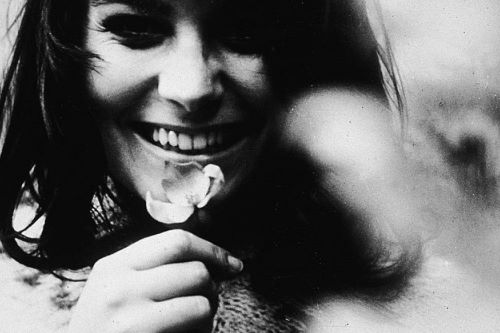
They came to San Francisco seeking something more — something significant, something transcendent. By the summer of 1967, a half-century ago this year, nearly 100,000 hippies and counterculture kids had gathered in the Haight-Ashbury neighborhood to drop acid, indulge in free love, and escape the confining strictures of their middle-class upbringings. They wanted to join the revolution.
Yet the utopia called the Summer of Love wouldn’t last, and, after the movement faded out, not all of them went back to professional career paths. Disillusioned by bad trips and a sense that their pursuit of hedonism had been empty, thousands of burned out hippies soon experienced something possibly even more revolutionary than tuning out and turning on: a born-again religious conversion.
Sex, drugs, and — Jesus? It’s not what the Summer of Love generally calls to mind. But of all the things that came out of San Francisco in 1967, perhaps none was more unexpected, or more consequential, than the Jesus Freaks or, as they were more commonly known, the Jesus People.
While they would give up their drugs and promiscuous sex, the Jesus People retained much of their countercultural ways, bringing their music, dress, and laid-back style into the churches they joined. Their influence would remake the Sunday worship experience for millions of Americans. As the historian Larry Eskridge has argued, today’s evangelical mega-churches with their rock bands blasting praise music and jeans-wearing pastors “are a direct result of the Jesus People movement.”
But aside from the praise anthems and the casual preaching styles that have come to characterize contemporary evangelicalism, the Jesus People also reshaped American politics. They helped to inspire the birth of the religious right. Many conservative evangelicals had long avoided politics, believing it would corrupt their spiritual lives, but the Jesus People contended that Christians couldn’t keep their spiritual and political lives separate. “I think everybody should be a full-time Christian,” the Jesus People rock singer Larry Norman once said.
Religious right leaders would use a similar line of argument to mobilize millions of evangelicals. Even more, conservative evangelicals drew directly from the Jesus People’s self-conception as marginal figures standing apart from a corrupt system. If you’ve ever wondered how the religious right came to dominate American politics while simultaneously presenting themselves as aggrieved outsiders, you can trace some of the answer to the Summer of Love.
How a Small-Town Navy Vet Created Rock’s Most Iconic Surrealist Posters
The story of one of rock’s most prolific poster artists.
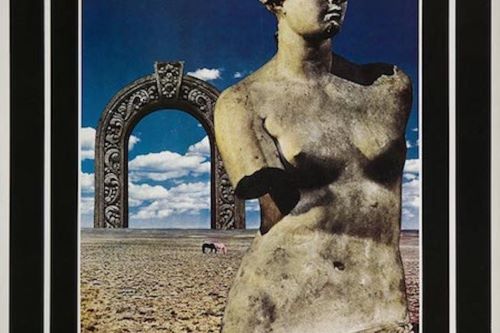
One May morning in 1969, David Singer walked into the Fillmore West in San Francisco in the hopes of meeting Bill Graham. The day before, Singer had shown some of his photo collages to the acclaimed rock-poster artist and “Zap Comix” contributor Victor Moscoso, who’d been recommended to Singer by a printer they both knew. Should he turn his collages into greeting cards, Singer had asked? Perhaps they’d sell better as head-shop posters? Moscoso said he didn’t know much about greeting cards, and noted that respected head-shop poster publishers like Berkeley Bonaparte were going out of business. But Moscoso liked Singer’s work, so he suggested that Singer pay a visit to Bill Graham, who was commissioning a poster a week for the rock concerts he was producing at the Fillmore West, Winterland, and a couple of other venues. “He’s the only game in town right now,” Moscoso had remarked. And so off Singer went, to see if the notoriously busy and blunt-spoken rock impresario might deal him a hand.
The collages Singer hoped to show Graham that morning featured photographs Singer had cut from the pages of old magazines to create, as he would later put it, “visual poems.” One of the visual poems he was carrying in his fancy black-leather portfolio featured an ancient Greek statue standing before two horses grazing far off in the distance. Looming behind the tiny animals was an immense stone archway. For Singer, the orientation of the statue so that it was looking away from the rest of the collage symbolized the past, the living horses symbolized the present, and the archway positioned on a horizon that opened to sky and clouds suggested the future. Other collages in his portfolio were more like visual puns—how else to describe an endless field of red tulips, above which floated two pairs of lipstick-red lips?
Poems or puns, Singer’s timing turned out to be fortuitous. That same month, Graham had ended his relationship with artist Lee Conklin in a dispute over 50 bucks; one did not argue with Bill Graham about money. Many of the 33 concert posters Conklin had created for Graham since January of 1968 had featured the artist’s original drawings of naked figures trapped in bad-acid-trip dreamscapes, his fleshy worlds and the lost souls who populated them often assembled from disembodied breasts, noses, ears, fingers, and feet. Conklin’s work was kind of creepy, difficult to decipher, and totally cool, perfect for late 1960s San Francisco.
For Graham, the loss of Conklin was a minor inconvenience in a business where existential threats were routine, whether it was an overly inquisitive fire inspector or a prima-donna rock star. Besides, Graham had other artists in his stable. Foremost among them was Randy Tuten, an up-and-coming artist, who melded a sophisticated flair for graphic design with a psychedelic sensibility. In Tuten’s hands, a posterized painting from 1912 of a sinking Titanic, surrounded by old-timey lettering, became an unlikely advertisement for Creedence Clearwater Revival, while a photograph of an avocado adorned with goofy googly eyes was all Tuten needed to hype Led Zeppelin.
READ ENTIRE ARTICLE AT COLLECTORS WEEKLY
How Chinese Food Fueled the Rise of California Punk
In the late 1970s, Chinatown restaurants started booking some unlikely dinner entertainment.
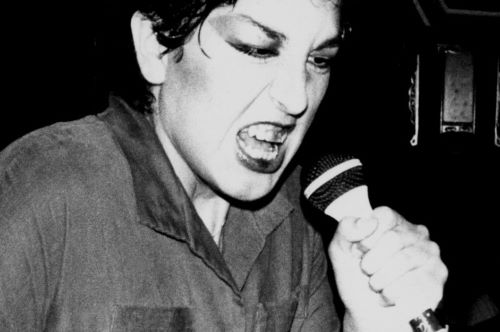
Bill Hong was a Cantonese immigrant dad in his late 40s, running a restaurant in Los Angeles’ Chinatown neighborhood with his sister Anna Hong and her husband Arthur, when two young promoters approached him with a business proposition: What did Hong think about renting out the restaurant’s upstairs banquet hall on the evenings when it wasn’t being used?
It was 1979, and LA was struggling. The entire country had plunged into a deep recession just a few years prior, and now Chinatown and the city’s downtown areas were falling into disrepair. More recent Chinese immigrants had started moving to suburban enclaves like the San Gabriel Valley, bypassing Chinatown and its businesses completely; the non-Chinese customers who used to flock to the neighborhood for exotic chow mein dinners were now avoiding downtown altogether.
When Bill Hong said yes to the promoters, he was trying to be practical. He knew the restaurant needed more customers; maybe letting a few young bands play could help bring them in. He never could’ve foreseen that his family’s establishment, the Hong Kong Low—located on a small street called Gin Ling Way—would become a focal point for a seminal music scene: West Coast punk.
Nor did he know how many times the restaurant’s toilet would get smashed in the process.
Hong’s restaurant—known as the Hong Kong Café to showgoers—was far from the only Asian restaurant to incubate the California punk scene. In the late 1970s and early ‘80s, from Sacramento to San Francisco, some of the state’s most important punk venues were actually Chinese and Filipino restaurants. At eateries like Sacramento’s China Wagon and Kin’s Coloma, or San Francisco’s Mabuhay Gardens, now-iconic bands such as X, the Germs, and Black Flag played some of their most memorable early gigs. The Hong Kong wasn’t even the first place in LA’s Chinatown to host gigs: the restaurant across the courtyard, Madame Wong’s, had already been doing the same for at least a year.
Unbelievably, the Hong Kong continued dinner service as usual during gigs, which took place almost every night. “Downstairs, there would be Chinese people eating dinner with their families. And upstairs, there would be this crazy punk stuff going on,” says Christy Shigekawa, Bill Hong’s great-niece. “You could see them going up the stairs, and people would be like, ‘Uh…’ Sometimes the ceiling would be shaking.”
The Forgotten Poet at the Center of San Francisco’s Longest Obscenity Trial
Amid Reagan’s late-sixties crackdown on the California counterculture, a jury was tasked with deciding whether Lenore Kandel’s psychedelic sex poems had “redeeming social importance.”
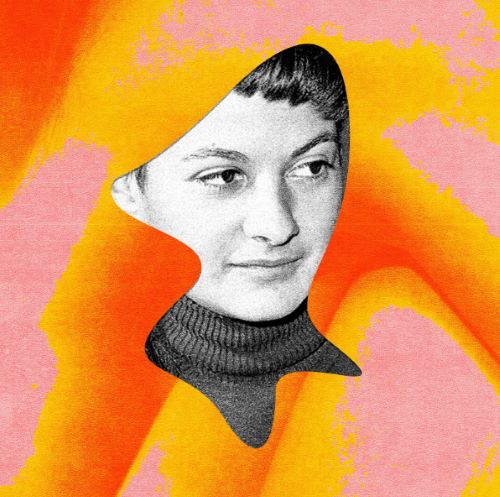
On November 15, 1966, five police officers entered the Psychedelic Shop, in San Francisco, and purchased a thin volume of poetry, “The Love Book,” for a dollar. This sequence of erotic poems celebrating a woman’s sexual pleasure was by the Beat poet Lenore Kandel. As soon as the money exchanged hands, the deputy arrested the clerk for selling obscene material. The officers then confiscated copies of the book, detained and frisked customers, and put out a warrant for the store owner, who was jailed the next day. Then they headed across town to City Lights Booksellers, which also sold “The Love Book.” A decade earlier, in 1957, the police had impounded Allen Ginsberg’s “Howl” at City Lights and arrested the bookseller for peddling pornography. Now history repeated itself as the cops seized Kandel’s poetry and took the clerk into custody. What followed was San Francisco’s last, and longest, obscenity trial over a literary work, and the only one featuring a female writer.
Even as these arrests were happening, people were puzzled by the decision to target “The Love Book.” Although Kandel used plenty of four-letter words—a cycle of poems was titled “To Fuck with Love”—there was more salacious material around San Francisco. But Kandel was the victim of bad timing. Much like today’s challenged books—such as “Gender Queer,” by Maia Kobabe, or “Lawn Boy,” by Jonathan Evison—her work contains elements that some conservative factions felt threatened mainstream morality. The week before “The Love Book” was impounded, Ronald Reagan was elected California governor. He campaigned on a platform to crack down on the burgeoning counterculture, vowing that he would “clean up the mess at Berkeley,” meaning student protests at the university, and warning of “sexual orgies so vile, I cannot describe them to you.” Kandel was a part of both the Beat-poetry scene and the hippie movement that would soon peak in 1967’s Summer of Love. Her poems express unabashed enjoyment of sex at a time when women weren’t supposed to acknowledge such feelings in public. In “The Love Book,” Kandel writes with openness and psychedelic-tinged joy, revelling in orgasmic pleasure. “All of me / can help but shriek / YES YES YES this is what I wanted this / beautiful.” Lines about arousal, such as “my body / transforms into one enormous mouth / between my legs,” suggest the shameless experiences of a sexually liberated woman. On top of that, her belief in sex as a spiritual act and a form of worship further menaced traditional values.
READ ENTIRE ARTICLE AT THE NEW YORKER
How CCR, “The Boy Scouts of Rock and Roll,” Took California and the Country by Storm
Creedence Clearwater Revival’s unique blend of traditional and progressive sensibilities.
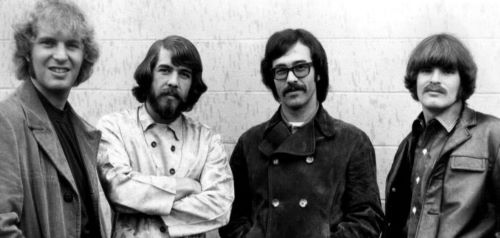
Pete Hamill’s “The Revolt of the White Lower Middle Class” was published in New York magazine, the April 14 issue. The essay was a long first-person tour of the laboring white man’s plight in postindustrial America. It was simultaneously protective, defensive, judgmental, and condescending toward its subject, New York’s underemployed “working-class whites.” Hamill described them as overworked, desensitized by television, and undereducated, with no complex feelings about the world. “Most of them have only a passing acquaintance with blacks, and very few have any black friends,” for example, “so they see blacks in terms of militants with Afros and shades, or crushed people on welfare.”
Hamill shared another secret about his typical joe: “When he gets drunk, he tells you about Saipan. And he sees any form of antiwar protest as a denial of his own young manhood, and a form of spitting on the graves of the people he served with who died in his war.”
“Their grievances are real and deep,” Hamill wrote, “their remedies could blow this city apart.”
Ultimately, Hamill looked to his own class of literary people to take note of the white working class. “Our novelists write about bullfighters, migrant workers, screenwriters, psychiatrists, failing novelists, homosexuals, advertising men, gangsters, actors, politicians, drifters, hippies, spies and millionaires; I have yet to see a work of the imagination deal with the life of a wirelather, a carpenter, a subway conductor, an ironworker or a derrick operator.”
READ ENTIRE ARTICLE AT LITERARY HUB
The Undoing of a Great American Band
Sly and the Family Stone suggested new possibilities in music and life—until it all fell apart.
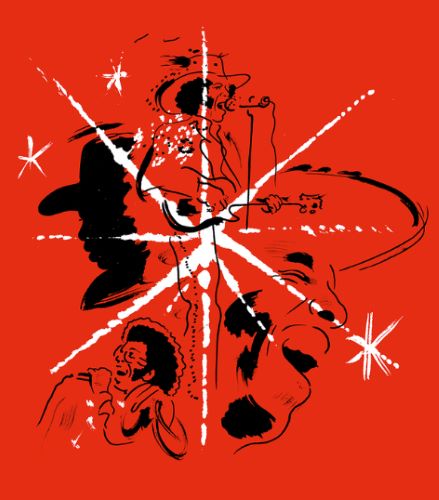
Is there a way to look at Sly Stone—a musical genius and, for a couple of years, an avatar of spiritual freedom—that isn’t dualistic, split-brained, one thing in opposition to another? That isn’t about light versus darkness, up versus down, Logos versus Chaos, good drugs versus bad drugs, having it all versus losing it all, and on and on? “Without contraries is no progression,” William Blake said, but still—I find myself groping for another plane of understanding. I want to see him as the angels do. We might need to evolve a little bit to get a handle on this man.
EXPLORE
THE UNDOING OF A GREAT AMERICAN BAND
Sly and the Family Stone suggested new possibilities in music and life—until it all fell apart.By James Parker

Is there a way to look at Sly Stone—a musical genius and, for a couple of years, an avatar of spiritual freedom—that isn’t dualistic, split-brained, one thing in opposition to another? That isn’t about light versus darkness, up versus down, Logos versus Chaos, good drugs versus bad drugs, having it all versus losing it all, and on and on? “Without contraries is no progression,” William Blake said, but still—I find myself groping for another plane of understanding. I want to see him as the angels do. We might need to evolve a little bit to get a handle on this man.
To the binary American eye, certainly, he soared and then he smashed. Sly Stone held the ’60s in the palm of his hand. He had the plumage and vibration of Jimi Hendrix and the melodic instinct of Paul McCartney. His music married ballooning hippie consciousness to the tautest and worldliest and most street-facing funk: Its end product, its neurochemical payload, was an amazing, paradoxically wised-up euphoria. A rapture petaled with knowingness, with slyness.
READ ENTIRE ARTICLE AT THE ATLANTIC
The History of 420, in Three Acts
There are many theories about the origin of 420, but five guys named Waldo started it all.
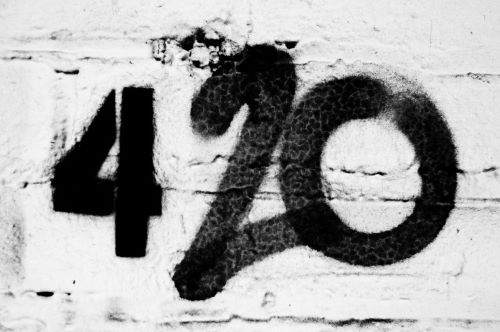
In 1971, Steve Waldo was given a treasure map to an abandoned patch of cannabis on Point Reyes that had been planted by a member of the Coast Guard who wanted some fellow stoners to have the patch—and everybody at San Rafael High knew the Waldos were the biggest stoners in town.
“Surely this is the ultimate safari,” thought Steve. “No more adventurous nor nobler quest could be devised by the mind of man.” The Waldos prophetically agreed to meet at 4:20 p.m. at the Louis Pasteur statue to get high, then drive out to Point Reyes to search for the secret weed patch.
From then on, whenever the Waldos passed each other in the halls, they spontaneously erupted in a salute with the words, “Four Twenty, Louie!” Little did they know how far this ritual would eventually travel, though “Louie” got lost along the way.
For the next 10 years, the Waldos went on many amazing safaris and had many magical adventures, though sadly they never found the patch. But each year they always sponsored a big pot party on April 20, where a ceremonial toke would take place at 4:20 p.m. Eventually, they got married, started families and put down their pot pipes. However, they kept up the safaris.
As soon as the Waldos retired from staging 420 ceremonies, however, the younger classmen of San Rafael High picked up on the magic of numerology and began using the code as a way to evade detection, and some of them started a ritual of congregating at the top of Mount Tamalpais in Marin County on April 20 in order to get high at exactly 4:20 p.m. as a way to honor the spirit of cannabis. This ritual began with only a few souls, but soon grew to dozens. And that’s when someone got the idea of making a flyer inviting stoners from all over the Bay Area to the ceremony. Nobody outside Marin knew that 420 signified pot. Even those gathered at the top of Mount Tam didn’t have any idea how it started—they thought 420 had something to do with the police code for “marijuana smoking in progress.”
READ ENTIRE ARTICLE AT FREEDOM LEAF PRESS
What the Guys Who Coined ‘420’ Think About Their Place in Marijuana History
And how the term came to be code for pot-smoking in the first place.

By now, you don’t have to be a smoker to know that April 20 is considered by many to be a sort of national holiday for cannabis culture. Some have suggested that the date comes from “420” being a code among police officers for “marijuana-smoking in progress,” while others say that there’s a connection to 4/20 being Nazi dictator Adolf Hitler’s birthday. But the most credible story about why 4/20 is a thing involves neither of those ideas.
Instead, it involves five high school students who, back in 1971, would get together at 4:20 p.m. to smoke marijuana by a statue of chemist Louis Pasteur at San Rafael High School in Marin County, Calif. Known as the “Waldos” — Steve Capper, Dave Reddix, Jeffrey Noel, Larry Schwartz, and Mark Gravich — they would say “420” to each other at some point during the school day as code to meet for a smoke.
Reddix’s brother helped him get a job as a roadie for Grateful Dead bassist Phil Lesh, and the term “420” caught on in that Deadhead circle. The legend goes that on Dec. 28, 1990, Deadheads in Oakland handed out flyers inviting people to smoke “420” on April 20 at 4:20 p.m — and one got in the hands of Steve Bloom, a former reporter for High Times magazine. The publication published the flyer in 1991 and continued to reference the number, and before long those digits became known globally for their association with marijuana. In 1998, the outlet recognized the “Waldos” as the “inventors” of 420.
The Waldos still live in northern California, in Marin County and Sonoma County, and are still good friends. TIME caught up with Reddix, now a documentary filmmaker and former CNN cameraman, and Capper, who runs a business that works with staffing agencies, to learn more about 4/20 history.
Sun Ra: ‘I’m Everything and Nothing’
Sun Ra, a seminal artist of afrofuturism, embraced a unique vision of blackness.
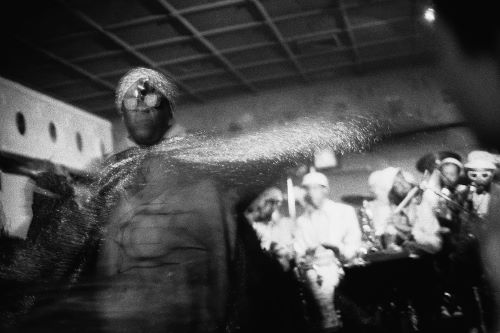
Two years later, Sonny headed to Chicago to reignite his musical career. He drank the Windy City down, its vibrant jazz and cabaret scenes, its Art Deco buildings and monuments, its convoluted history of Black Nationalism. Skipping from band to band, he finally formed his own. He called it the Arkestra. And on October 20, 1952, riffing on Egyptian mythology, Sonny renamed himself once more. He became Le Sony’r Ra, or Sun Ra for short. Herman Blount, he said, was a slave name.
Pictures of Sun Ra often suggest chaotic hybridity: priestly futuristic costumes and sets, ancient Egypt and the planet Saturn forming a palimpsest of past and future utopias. His sound synthesized big band, swing, hard bop, reggae, Afropop, electronic music, and Walt Disney musicals. His references—expressed in his lyrics, poetry, and pamphlets—showcased this eclecticism too: Kabbalah, gnosticism, freemasonry, pan-Africanism, Zen. When he taught a course at the University of California, Berkeley in 1971, his syllabus included The Egyptian Book of the Dead; the theosophical works of Madame Blavatsky, the nineteenth-century Russian medium; Henry Dumas, a brilliant poet gunned down by New York City Transit Police in 1968. He often cited George G.M. James’s Stolen Legacy (1954), which claimed that Greek philosophy had filched its ideas from Egyptian mythology.
In Sun Ra’s various writings and interviews, he always maintained that there was a metaphysical basis for what he called his “equations”: non sequitur chains of koans and runes, of numerology and etymology. He had a bit of the guru’s antiphony of the individual and the collective to him. Sun Ra was always gathering disciples, yet set himself apart from them. His biographer, John F. Szwed, quotes Sun Ra as saying, “I know what they’re talking about, but they don’t know what I’m talking about. I’m in the midst of what they’re doing but they’ve never been in the midst of what has been impressed upon my mind.” He was lone wolf and lupine leader, Anubis presiding over the vast nothing of the black world, the underworld, and outer space.
In 1974 Sun Ra cowrote, produced, and starred in a film that’s often considered the origin text of what we now call Afrofuturism. The premise of Space Is the Place returns us to his interplanetary vision: Sun Ra wants to “set up a colony for black people…. We’ll bring them here througheitherisotope teleportation, transmolecularization, or better still, teleport the whole planet here through music.”
READ ENTIRE ARTICLE AT THE NEW YORK REVIEW
Leon Litwack, 91, Dies; Changed How Scholars Portray Black History
One of Berkeley’s most popular professors, he brought passion and nuance to his award-winning study of the marginalized and the oppressed.
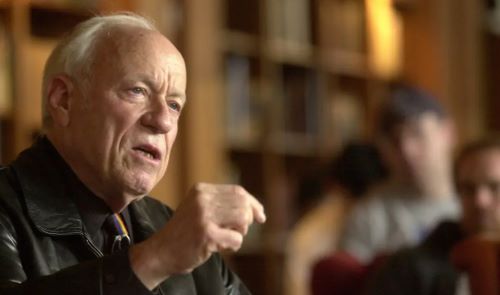
Leon Litwack, a leather-jacket-wearing, blues-loving historian whose pioneering books on slavery and its aftermath demonstrated how Black people thought about and shaped their own liberation, even as they were constrained by racism in American society, died on Aug. 5 at his home in Berkeley, Calif. He was 91.
His wife, Rhoda Litwack, said the cause was bladder cancer.
Professor Litwack, a son of left-wing immigrants from Russia, brought an ethos of patriotic dissent to both his teaching and his scholarship at the University of California, Berkeley, insisting that the historian’s job is to give voice to the marginalized and to make the well-off uncomfortable. He sought to teach students, he said in a 2001 interview, to “feel the past in ways that may be genuinely disturbing.”
Beginning in the early 1960s, a time when many historians still treated enslaved and freed Black people as passive actors in their own narratives, he cut a different path, immersing himself in the archives to discover Black voices and their stories and show how they thought about, and struggled against, oppression.
READ ENTIRE ARTICE AT THE NEW YORK TIMES
Fairytale
The Pointer Sisters, the Great Migration, and the soul of country.
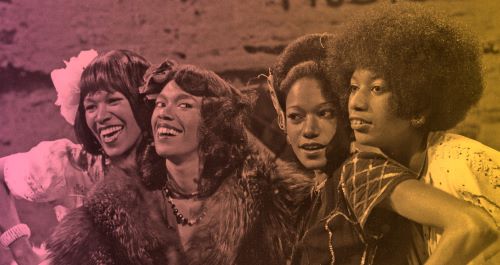
Anita Pointer wrote the first draft of the country song “Fairytale” at a motel in Woodstock while she and her sisters were on tour singing backup for Dave Mason. She was still reeling from the revelation that her new boyfriend, a San Francisco radio DJ, had been married all along—a story so common she’d call it cliché if she didn’t have to plot the next chapter herself. That night she stayed up late running her favorite James Taylor tape on repeat, and the lyrics she wrote channeled his plainspoken style: There’s no need to explain anymore—I tried my best to love you, now I’m walking out that door. Once the tour was over, Anita’s baby sister Bonnie provided the bright and buoyant melody, as if to sustain the momentum of departure.
“Fairytale” became one of several throwback tracks on the second Pointer Sisters album, That’s A Plenty. They also covered the bebop classic “Salt Peanuts” and composed the cheeky, citified “Shaky Flat Blues.” Even the album art looked like an old Aaron Douglas illustration: four women in silhouette, wearing caps and drop-waist dresses, hooked in a Harlem-style chorus line high-stepping offstage. The figures faced left, a subtle sign that this music would move against the grain.
In 1975, “Fairytale” won an unexpected Grammy for Best Country & Western Vocal Performance by a Duo or Group, and Elvis himself recorded a cover. The Grand Ole Opry invited the Pointer Sisters to Nashville, making them one of the first Black acts to headline the genre’s high church—always an ambivalent distinction. When they arrived, racist protestors held signs saying, “Keep country, country!” as if American music were private property and the Pointer Sisters were trespassing from elsewhere. Anita remembers hearing a man shout, “Hot damn, them girls is Black!” But after they performed “Fairytale,” the crowd got quiet, then loud: “Sing it again, honey!” Which they did, three times through. Sometimes, the most familiar stories are the ones that bear repeating—as if, in listening to a new rendition, we might pick up tones, textures, histories, and meanings that reveal hidden hatches in the trap.
Just as we understand love affairs best in retrospect, I hear the meaning of “Fairytale” most clearly in the outro. For a few bars, the pedal-steel guitar and hi-hats drop out, and Anita abandons her place as the song’s lovelorn protagonist to fall back on the steady refrain of Ruth, Bonnie, and June: move on—got to move on. There’s still a walking bass line and some gospel on the keys, but the spell of the song is broken, and those grown-up girls are left alone with the consolation of each other’s company and the stripped-down rhythm of real life. The great big fairytale is over, and the train is churning through the station. Where will it take them? What kind of future will they find once they stop waiting on the false promise of American romance?
In “Fairytale,” the lead singer’s got to move on from a faithless man, but the outro reverberates with the more collective journey of the Great Migration away from the South—and maybe, for the next generation, on up to a greater day, as Curtis Mayfield demands in his classic soul anthem. “Move On Up” was recorded just a few years before “Fairytale,” in 1970, and the brash horns and frenetic percussion dramatize this transition—how the children of Southern migrants born in Chicago (like he was) or Oakland (like the Pointer Sisters) would have to survive the crushing disappointments of the Civil Rights Movement, and learn to live in the burning cities that once signified liberation. “Move On Up” makes a break with the past—your folks might understand you, by and by—in the name of progress. “Fairytale” is a quieter kind of wake-up call: if so many problems stay stubborn across time and space, then maybe the old styles—blues, jazz, swing, country—still have work to do.
READ ENTIRE ARTICLE AT OXFORD AMERICAN
How Huey P. Newton’s Early Intellectual Life Led Him To Activism
The role of family in Huey P. Newton’s educational journey.
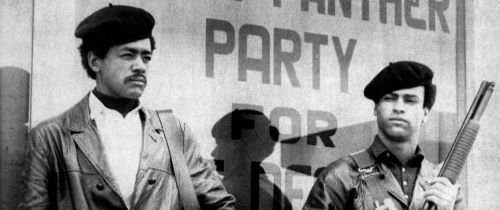
For Huey Newton and Bobby Seale, Telegraph Avenue was more than a four-and-a-half-mile road stretching north from their hometown of Oakland to the campus of the University of California at Berkeley. It was a link between two distinctly different worlds: between the rough ghetto streets where they grew up, and the steepled academic sanctuary so close by.
For much of the early 1960s, what existed of a Black student movement in the San Francisco Bay Area was organized by activists from Berkeley, and Newton and Seale, part-timers at a junior college in Oakland, followed the lead of those self-important, middle-class leaders. But that began to change for good on the evening of Thursday, March 17, 1966, when Newton and Seale and a friend they called Weasel took a walk up Telegraph Avenue to look for secondhand albums by bluesmen T-Bone Walker and Howlin’ Wolf at a record store near the university.
Walnut dark, with a protruding brow, heavy eyebrows, and a thick mustache, Seale, at age twenty-nine, looked the tough guy part of a metalworker who had served in the Air Force and been court-martialed for a confrontation with a colonel. But Seale also had a theatrical streak, with a sideline as a stand-up comedian and a knack for memorizing and reciting poetry.
As the threesome proceeded up Telegraph Avenue, his companions urged Seale to entertain them with one of his favorite poems, written by a fellow student at Oakland’s Merritt College, Marvin Jackmon, a pioneer of the Black Arts Movement who went by the pen name of Marvin X. Entitled “Burn, Baby, Burn,” Marvin’s composition told the story of 1965 Watts riots in the style of the Beat poets.
READ ENTIRE ARTICLE AT LITERARY HUB
Burnout: Modern Affliction or Human Condition?
As a diagnosis, it’s too vague to be helpful—but its rise tells us a lot about the way we work.

Lost in the misty history of burnout is a truth about the patients treated at free clinics in the early seventies: many of them were Vietnam War veterans, addicted to heroin. The Haight-Ashbury clinic managed to stay open partly because it treated so many veterans that it received funding from the federal government. Those veterans were burned out on heroin. But they also suffered from what, for decades, had been called “combat fatigue” or “battle fatigue.” In 1980, when Freudenberger first reached a popular audience with his claims about “burnout syndrome,” the battle fatigue of Vietnam veterans was recognized by the DSM-III as post-traumatic stress disorder. Meanwhile, some groups, particularly feminists and other advocates for battered women and sexually abused children, were extending this understanding to people who had never seen combat.
Burnout, like P.T.S.D., moved from military to civilian life, as if everyone were, suddenly, suffering from battle fatigue. Since the late nineteen-seventies, the empirical study of burnout has been led by Christina Maslach, a social psychologist at the University of California, Berkeley. In 1981, she developed the field’s principal diagnostic tool, the Maslach Burnout Inventory, and the following year published “Burnout: The Cost of Caring,” which brought her research to a popular readership. “Burnout is a syndrome of emotional exhaustion, depersonalization, and reduced personal accomplishment that can occur among individuals who do ‘people work’ of some kind,” Maslach wrote then. She emphasized burnout in the “helping professions”: teaching, nursing, and social work—professions dominated by women who are almost always very poorly paid (people who, extending the military metaphor, are lately classed as frontline workers, alongside police, firefighters, and E.M.T.s). Taking care of vulnerable people and witnessing their anguish exacts an enormous toll and produces its own suffering. Naming that pain was meant to be a step toward alleviating it. But it hasn’t worked out that way, because the conditions of doing care work—the emotional drain, the hours, the thanklessness—have not gotten better.
READ ENTIRE ARTICLE AT THE NEW YORKER
Chinatown
The Surprising Reason Why Chinatowns Worldwide Share the Same Aesthetic
It all started with the 1906 San Francisco earthquake.
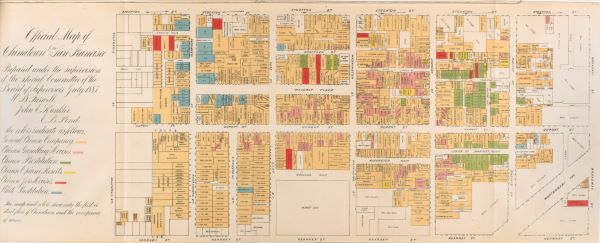
Anti-Chinese racism runs deep in American culture and law, beginning in the 19th century as competition intensified in California gold and land rushes. Chinese immigrants were pushed into teeming cities, then denigrated for surviving in overcrowded slums. To get a sense of the scope of the prejudice, we need only consider the 1882 law known as the Chinese Exclusion Act — the only legislation passed to explicitly restrict immigration by one ethnic or national group. The law actually goes back to 1875, when the Page Act banned Chinese women from immigrating. It was only repealed in 1943.
Although routinely evaded, the severe restrictions and outright bans on Chinese immigration under the Exclusion Act drove and were driven by racist ideas still visible today in tropes of dangerous, exoticized “dragon ladies” or sexually submissive concubines: roles given in early Hollywood films to the first Chinese-American movie star, Anna May Wong, who, after 1909 — despite being the most recognizable Chinese-American in the world — had to carry identification at all times to prove her legal status.
Wong was born in Los Angeles, a city that — like every other major metropolis — became home to its own Chinatown, and a famous one at that. But the most famous of the segregated urban areas originated in San Francisco, after the 1906 earthquake that nearly leveled the city and “came on the heels of decades of violence and racist laws targeting Chinese communities in the US,” notes Vox. “The earthquake devastated Chinatown. But in the destruction, San Francisco’s Chinese businessmen had an idea for a fresh start” that would define the look of Chinatowns worldwide.
READ ENTIRE ARTICLE AT OPEN CULTURE
When Chinese Americans Were Blamed for 19th-Century Epidemics, They Built Their Own Hospital
The Chinese Hospital in San Francisco is still one-of-a-kind.
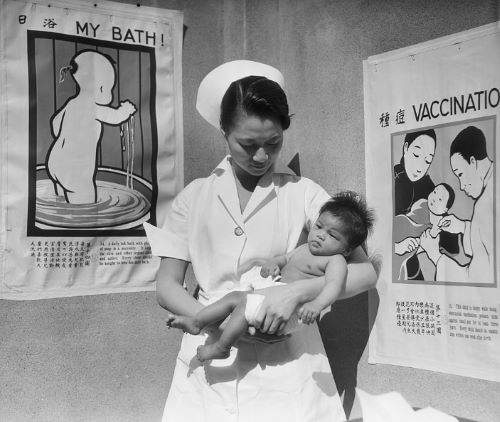
California’s first Chinese immigrants arrived at a tumultuous time. From the 1860s to the early 1900s, a raft of epidemics, from smallpox to cholera, ravaged the San Francisco Bay Area, and especially Chinatown. Lacking scientific research on disease transmission, local health officials often blamed outbreaks on living conditions in Chinatown and the vices of its inhabitants. In 1877, the surgeon Hugh Toland told a congressional committee that Chinese sex workers caused 90 percent of syphilis cases in the city.
This history makes the recent uptick in anti-Asian discrimination, associated with the COVID-19 pandemic, seem searingly familiar. In 1885, San Francisco’s health officer declared Chinatown a “social, moral, and political curse to the community.” The Board of Health proposed draconian measures to quarantine and destroy buildings where infections had spread, demolishing many businesses and homes in the process. Public officials not only portrayed Chinese Americans as breeders of disease, but also denied the group access to health care, refusing to finance critical services in Chinatown and raising the cost of treatment for Chinese patients at municipal hospitals. As a result, the Chinese accounted for less than 0.1 percent of hospital admissions in the late-19th century, according to medical records from city and county institutions.
In response, the Chinese diaspora organized. Well-connected merchants of the Chinese Six Companies—a federation of mutual aid associations—decided to self-fund their own hospital. In 1900, the year the bubonic plague hit San Francisco, Tung Wah Dispensary opened its doors to Chinatown residents, becoming the first Chinese-American medical facility in the continental U.S. A quarter-century later, it became the Chinese Hospital, which now has locations all over the Bay Area.
READ ENTIRE ARTICLE AT ATLAS OBSCURA
Bruce Lee’s “Warrior,” and the Politics of Kung Fu
The Max series makes a radical argument for what constitutes American history.
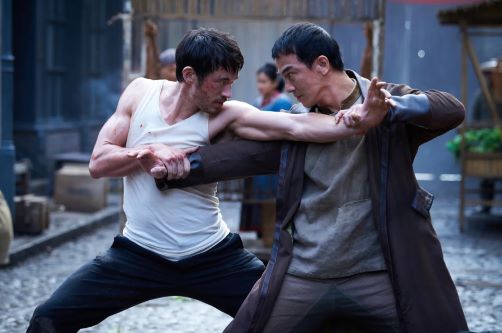
“Warrior” tells the story of two crime families—the Hop Wei, which Ah Sahm ultimately joins, and the Long Zii—who are embroiled in a conflict that’s known as the Tong Wars. Lin has said that he was eager to develop a relegated history while also making mainstream entertainment. “I’ve always felt like it’s such an American story, but never told,” he explained, in a 2019 interview. “Warrior” expands our ideas of what constitutes “American history” by partly focussing on another competition—between the Irish and Chinese communities in San Francisco. The Irish community is led by Dylan Leary (Dean Jagger), a de-facto labor organizer who goes to extreme lengths to maim Chinese workers in sought-after jobs, negotiating with American robber barons and elected officials. Meanwhile, the Long Zii make a deal with a nativist deputy mayor, in exchange for opium and increased policing of the Hop Wei. The deputy, who aspires to become the next mayor of San Francisco, encourages disorder in Chinatown so that he can run on a platform that involves ejecting all Chinese residents from the city. But he’s also interested in something more systematic: the creation of legislation to restrict immigration by targeting one specific ethnic group. Leary and the Long Zii both represent marginalized groups that have sold out for marginal power. It’s a clear charter to respective destruction, for the Long Zii especially, since their turf war will inevitably end with an immigration ban that will last more than sixty years, followed by another twenty-plus years of restrictions.
At times, “Warrior” can feel radical. It not only conjures figures who have rarely been centered on television before but also supplies these characters with rich inner lives. Still, there’s an occasional narrowness, which might be attributed to the fact that the show was conceived in the nineteen-sixties, by an actor who was predominantly interested in documenting the Chinese experience in America. There are barely any Black characters present, aside from a drug dealer and a vixen bartender, and their story lines are bland, despite occurring in the period immediately following Reconstruction. Even if the show’s focus is on Irish immigrants and Chinese people making a deal with whitey to tear one another down, it seems like there’s still an opportunity to shift the camera to nearby Stone Street, which was once the only Black enclave in San Francisco.
READ ENTIRE ARTICLE AT THE NEW YORKER
Inside San Francisco’s Plague-Ravaged Chinatown
A city on the edge.
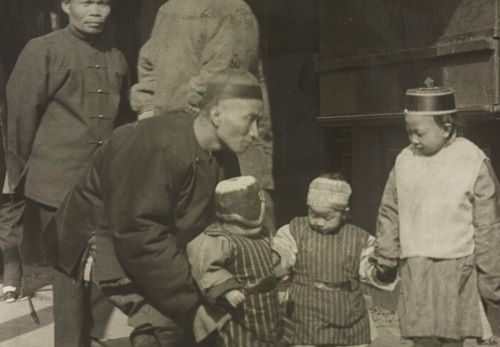
Shortly before midnight on March 6, 1900, three men gathered at a coffin shop in Chinatown to examine the body of a 41-year-old Chinese man who had died earlier that day. The police surgeon, a city health official, and a young bacteriologist palpated the corpse’s swollen lymph glands and found a small sore on his thigh. Piercing the skin, they drew blood and lymph fluids and placed drops of them under a microscope. With a stain that made the germs turn pink, they saw clusters of short, rod-shaped bacteria swimming under the lens. It looked like bubonic plague.
Confirming that suspicion would take days, but city officials leaped into action. That night, the Board of Health ordered a quarantine of Chinatown. Under the cover of darkness, some 35 police officers spread out around 12 square blocks. They strung ropes across key intersections and blocked foot traffic and wagons from coming in or out. Only police and health officials were permitted to cross the barriers; supplies to the quarter, at least at first, were passed under the ropes. Chinese who tried to leave the area were blocked by officers carrying nightsticks and pistols.
Most San Franciscans learned of the quarantine the next morning. Some read about it in the newspapers; others pieced together the story on their own after their servants, cooks, and porters failed to show up for work. The chef at the Palace Hotel struggled with the breakfast service, because a dozen or more of his Chinese employees couldn’t get past the barricades to reach the kitchen. The Chinese who supplied hotels and restaurants from their gardens outside the city were unable to leave Chinatown to harvest their long beans and mustard greens. A story in the San Francisco Chronicle condemned the quarantine as having been too hastily imposed: “The central telephone in Chinatown was kept busy for hours making connections for angry citizens who were trying to get trace of missing servants.”
READ ENTIRE ARTICLE AT LITERARY HUB
The Surprising History of the Fortune Cookie
Searching for the roots of an American classic.
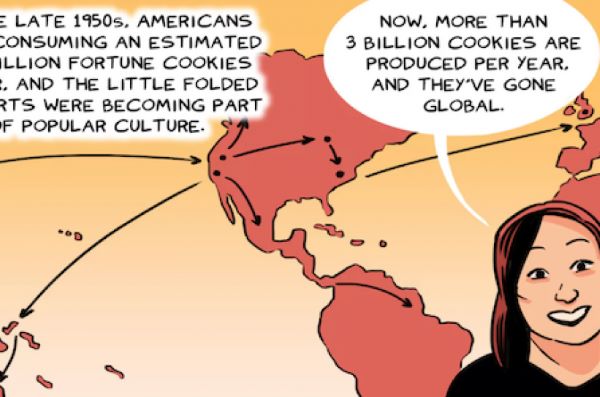
SEE ENTIRE INFOGRAPHIC AT THE NIB
The Hunt for General Tso
The origins of Chinese-American dishes, and the spots where these two cultures have combined to form a new cuisine.

Reporter Jennifer 8. Lee talks about her hunt for the origins of familiar Chinese-American dishes — exploring the hidden spots where these two cultures have (so tastily) combined to form a new cuisine.
Xenophobia in the Age of COVID-19
Scapegoating immigrant groups in times of disease outbreak has a long history.
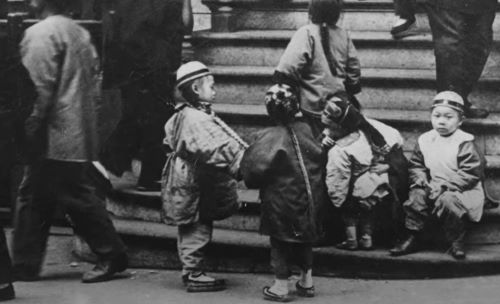
Scapegoating immigrant groups in times of disease outbreak has a long history.
Verbal and physical attacks on Asian-Americans are on the rise as the new coronavirus, which scientists believe originated in China, spreads across the globe. Scapegoating immigrant groups in times of disease outbreak has a long history. In a 1900 outbreak of bubonic plague, San Francisco officials quarantined only one area – Chinatown – blaming the immigrant population there for starting the outbreak.
The World Health Organization warns that stigma and discrimination can occur when people associate a disease with a population or nationality. In naming diseases, WHO avoids using names of animals, places, or people.
This video was created with support from a Brown Institute for Media Innovation grant recognizing a need for accurate information about the COVID-19 virus.
READ ENTIRE ARTICLE AT RETRO REPORT
Gay Rights
What Was Gay?
In a more accepting world, homosexual men can leave their campy, cruising past, but the price of equality shouldn’t be conformity.
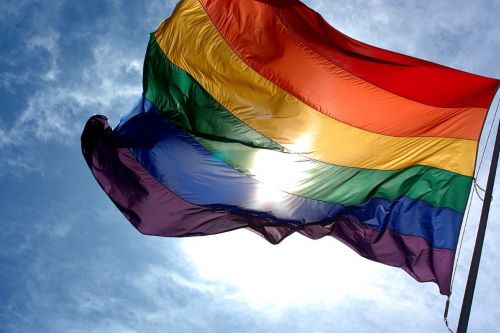
“You know,” observed a recent dinner guest, glancing around our living room between sips of his digestif, “there are a lot of strong women in this apartment.”
I follow his gaze toward the massive tangerine-on-yellow She-Ra painting that anchors one end of the room—a tough lady if there ever was one. Then, over to the poster for Pedro Almodóvar’s Todo Sobre Mi Madre—the madre here a primary-colored, Picasso-lite Cecilia Roth—on the opposite wall. The superhero and super-mom, their eyes locked, seem unimpressed with present company. Broadening the scan, I pass over photographed gypsies, lithographic courtesans, cartooned drag queens, and a bowler-hatted Grace Jones who looks irritated, probably because she still doesn’t have a frame. From the coffee table, Kylie Minogue, Yoko Ono, and a legendary ballroom voguer all stare up from their book covers with varying degrees of attitude.
“Well,” I shrug, “the motif wasn’t intentional … but you did know we’re gay, right?”
“The apartment treated as a stage set—dramatically lit, designed to be taken in all at once and from the entrance,” Edmund White wrote in his road-trip survey of American gay life in the late 1970s, “remains a gay apartment, whether the décor is high camp or high tech, cluttered comfort or austere emptiness.” Less than a decade later, the writer and director Neil Bartlett observed of English gay spaces: “Our rooms are not decorated to announce our occupation or our family status; they are not really ‘domestic’ interiors. They need reflect nothing but the tastes of their owner, the pleasure he takes in his life, his ability to choose and arrange his possessions.” Fast-forward three more decades and find my partner and me making a home together, filling it full of our possessions—two-dimensional divas—which we dramatically light when friends are expected.
Implicit in the notion that an apartment like mine can “be gay”—and that you, despite any politically correct training against saying so, could easily recognize it as such—is an understanding of gayness as something more than a basic sexual orientation. The concept of a “gay apartment,” like “gay literature” or “gay mannerisms,” suggests that gayness also comprises a set of markers or values or practices that manifest themselves in the spaces and objects and relationships that gay men create. (While cultural gayness, as I’ll try to define it here, is not the exclusive province of men, their history as its most visible advocates will necessarily bias this piece.) If you believe White and Bartlett as I do, gayness may be found not just in whom you sleep with, but also, perhaps, in the sort of sheets you insist on sleeping between.
What Became of the Oscar Streaker?
After Robert Opel dashed naked across the stage in 1974, he ran for President and settled into the gay leather scene.
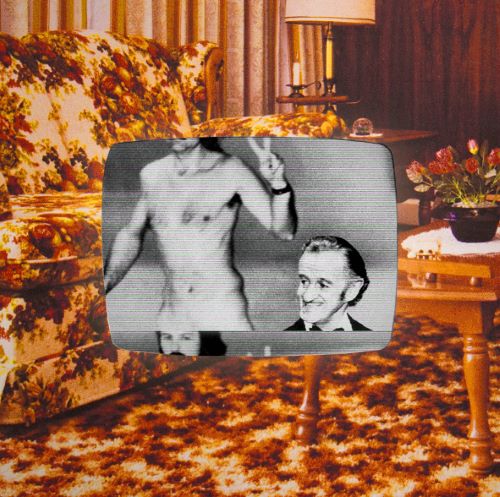
Had he not been fired for being who he was, he might have continued down a conservative path. Instead, Opel transformed into a hippie prankster, a misfit child of the sexual revolution. After the Stonewall riots, in 1969, being gay was no longer a mark of shame but a movement, one that gave Opel a place in the world. In the early seventies, he did a regular photo feature for the Advocate called “Around Town . . . by Robert Opel.” He’d snap a long-haired hitchhiker in snug bell-bottoms, or a guy getting a lion tattoo on his ass, or a hippie lounging naked under the Hollywood sign. “I feel closer to being able to accept myself for who I am—no pretense, no bullshit, a lot less fear,” he wrote to his sister.
By early 1974, as he plotted his Oscar streak, he was working as a curriculum consultant for the L.A. school district, helping to develop a new method of teaching English to foreign students. “There is a revolution going on in linguistics education,” he told the Van Nuys Valley News, three weeks before the Academy Awards. The day after his streak, the school district informed him by letter, “Your services will no longer be needed.”
He returned to the Advocate a conquering hero. “I felt quite exhilarated really. I recommend it,” he told a reporter for the paper. “It was a challenge. I don’t know why that turns me on, but it does.”
In July, he made a second streak. The L.A. City Council had been debating a ban on nudity in public areas, including a Venice Beach spot beloved by skinny-dippers. Four hundred people packed the council chamber. As a councilwoman spoke, Opel strode up the aisle, stripped off his jumpsuit, leaped over a rope, and stood next to the stunned police chief, Ed Davis. He made a peace sign with his fingers and asked, “Is this lewd?” He was booked for indecent exposure and disturbing a public meeting. The nudity ban passed, 12–1.
His trial, at which he dressed as Uncle Sam, kept his name in the papers. “Indecent exposure generally means there was something sexual about it,” his lawyer argued. “We’re quite sure in this case that Opel didn’t come there to make love to the city councilmen.” On the witness stand, Opel testified, “I wanted to give the council an example of what a live nude person looked like, and to show them that there were no reasons to conclude that simply being nude was being lewd.” The jury found him guilty only of disturbing the meeting (“OPEL NOT LEWD,” the Advocate declared on its front page), and he received a four-month sentence.
Opel rarely spoke of his time in jail. Undaunted, he embraced his new role as “unemployed propagandist.” That September, in the wake of Richard Nixon’s resignation, he announced his candidacy, with his newly formed Nude Lib Party, for President of the United States, on a platform of complete disclosure. “I’ve got nothing to hide,” he said at his first press conference, to which he wore only his mustache, “and I want to give everyone a chance to look over my qualifications.” His campaign bore the slogan “Not Just Another Crooked Dick.”
When his candidacy failed, he became the editor of the magazine Finger, which ran raunchy photos and stories sent in by real couples. By 1975, the streaking fad had petered out, but Opel published an editor’s manifesto laying out his philosophy of nudity:
The thrust of my message is: undress. As long as cover-up is part of anyone’s mental set, he or she will be diminished in his efforts to be totally self-actualized. Undress goes far beyond simply urging one to remove the clothes from one’s physical person. But that can be a start; a visual statement of innocence; an external sign of one’s intent to exorcize hypocrisy.
READ ENTIRE ARTICLE AT THE NEW YORKER
Harvey Milk’s Gay Freedom Day Speech
Five months before his assassination in 1978, Harvey Milk called on the president of the United States to defend the rights of gay and lesbian Americans.
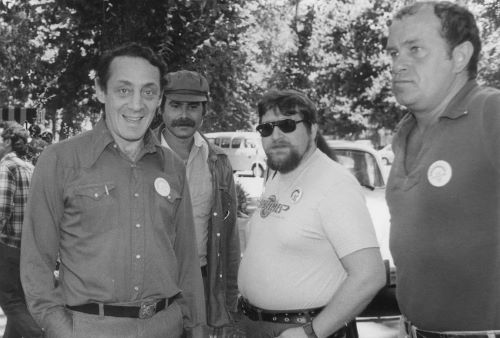
On June 25, 1978, the ninth anniversary of the Stonewall Riot in New York City, Harvey Milk gave an impassioned speech to his fellow San Franciscans celebrating Gay Freedom Day. At the time, LGBTQ+ individuals around the country were dealing with state and local initiatives looking to “protect children” by overturning equal rights ordinances. The two most visible figures behind these legislative maneuvers were John Briggs, a state Senator in California, who sought to remove openly lesbian and gay teachers with Proposition 6 (the phrase “public homosexual” repeats throughout the proposition); and Anita Bryant, whose “Save Our Children” organization successfully helped overturn equal rights ordinances in Miami, Florida; Eugene, Oregon; Wichita, Kansas; and St. Paul, Minnesota, while failing in Seattle, Washington.
In his speech, Supervisor Milk asked US President Jimmy Carter to speak out against Proposition 6, better known as the Briggs Initiative. Carter and former president Gerald Ford were both against the initiative, as was former California governor Ronald Reagan, who wrote about his opposition to it in the Los Angeles Herald-Examiner. The Briggs Initiative was defeated by voters on November 7, 1978.
Just three weeks later, Harvey Milk and San Francisco Mayor George Moscone were assassinated at San Francisco City Hall by recently resigned Supervisor Dan White. The first National March on Washington for Lesbian and Gay Rights was held on October 14, 1979, with a five point platform:
- Pass a comprehensive lesbian/gay rights bill in Congress
- Issue a presidential executive order banning discrimination based on sexual orientation in the federal government, the military, and federally contracted private employment
- Repeal all anti-lesbian/gay laws
- End discrimination in lesbian mother and gay father custody cases
- Protect lesbian and gay youth from any laws which are used to discriminate, oppress, and/or harass them in their homes, schools, jobs, and social environments.
READ ENTIRE ARTICLE AT JSTOR DAILY
The Most Dangerous Gay Man in America Fought Violence With Violence
Four decades ago, Raymond Broshears armed his disciples to keep LGBT people safe from violent homophobes.
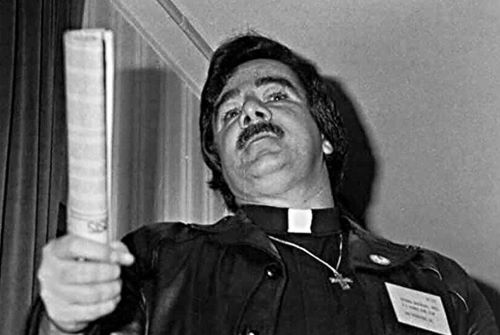
As the sun set over San Francisco on July 4, 1973, the Reverend Raymond Broshears locked up his community center and started walking home through the Tenderloin, the city’s infamous slum.
A gay preacher from the Midwest, Broshears was dressed in black clerical garb and a white priest’s collar. A heavy metal cross, the size of a door knocker, hung from his thick neck, and his gut bulged from beneath his shirt. Following close behind him, he noticed, was a group of teenagers—about a dozen of them, he’d later recall, between the ages of 12 and 18. They were looking for a fight. Earlier in the day, Broshears had called the police to complain that the teens had been throwing cherry bombs into traffic. Now, they wanted payback.
As he approached the corner of Turk and Jones, the teens surrounded him. One boy punched him in the back of the head. Another hit him in the groin. Broshears crumpled into a ball. They dragged him down the sidewalk, then onto the street, kicking and punching him, until a bus driver showed up and the kids ran away. The beating had left Broshears with a bloody nose and bruises all over his body. His right arm, he later wrote, was “treated for partial temporary paralysis.” Elisa Rleigh, a friend, recalls that Broshears “was beaten up really, really, really badly. Like within an inch of his life.”
Beatdowns like the one Broshears experienced were common, Rleigh says, especially in the Tenderloin. San Francisco was a “gay mecca” in the early 1970s, but gangs often targeted the growing number of young gay residents in the neighborhood. Broshears claimed he had a list of dead gay men—all unsolved murders. Gays in San Francisco, he believed, were under siege—both from the gangs and the crooked cops who were supposed to serve and protect all of the city’s residents.
Now, sitting in a hospital bed, his face and arms mangled, Broshears was enraged and wanted to strike back. The violence against his flock—poor gay men, drag queens and trans people—had to stop. He wanted, as he’d later tell a reporter, to strike terror into the hearts of “all those young punks who have been beating up my faggots.”
READ ENTIRE ARTICLE AT NEWSWEEK
Unearthing The Surprising Religious History Of American Gay Rights Activism
Years before Stonewall, many clergy members were standing on the front lines for gay rights.
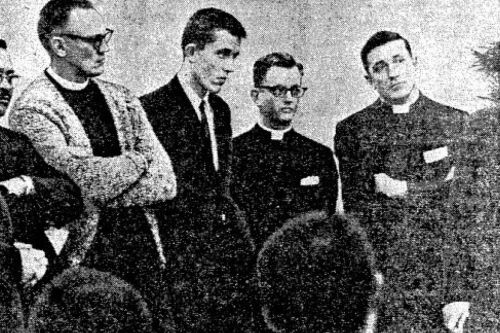
On New Year’s Day 1965, hundreds of gay San Franciscans arrived at 625 Polk Street in the city’s Tenderloin district for a much-anticipated “Mardi Gras Ball.”
The event organized by gay rights — or, to use the then-common term, homophile — activists was not unlike the thousands of public parties being held this June during Lesbian, Gay, Bisexual and Transgender Pride Month: There were drinks and music, hand-holding, flirtatious glances and kisses between friends old and new. But it was also a private affair — $5 tickets had to be bought ahead of time — in a city where gay people regularly faced threats and arrests for gathering together and showing affection.
Perhaps the most striking aspect of the San Francisco ball, however, was its purpose beyond merriment: It was held as a fundraiser for pro-gay clergy.
Today, although Americans for and against gay rights cite their religious beliefs, those who oppose same-sex marriage and other civil rights for LGBT individuals have been especially vocal in declaring that God is on their side. That’s not always been the expectation about the faithful. In the mid-1960s, LGBT activists often looked to men of the cloth as allies in their fight for justice and human rights, according to historians.
Just months before the ball, about two dozen Bay Area Methodist, Lutheran, Episcopal and United Church of Christ clergy and gay activists had formed the Council on Religion and the Homosexual to promote the “need for a better understanding of human sexuality” and its “broad variations and manifestations.”
READ ENTIRE ARTICLE AT HUFFINGTON POST
The Sissies, Hustlers, and Hair Fairies Whose Defiant Lives Paved the Way for Stonewall
In 1966, the queens had finally had enough with years of discriminatory treatment by the San Francisco police.
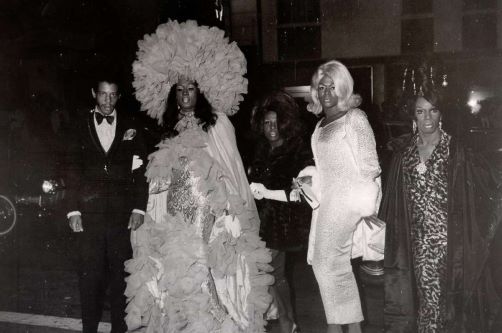
The queens had finally had enough: In August 1966—fifty years ago this month—transgender and gender-nonconforming customers at Gene Compton’s Cafeteria stood up to years of abusive, discriminatory treatment by the San Francisco police. The all-night restaurant in the city’s impoverished Tenderloin neighborhood was an unwilling haven for queer residents, and after its management called law enforcement to remove a noisy table of diners, patrons frustrated with the constant profiling and police harassment started throwing plates, cups, trays, and silverware at the officers. While police waited for backup, customers tore the cafeteria apart and the riot spread onto nearby Turk and Taylor Streets, damaging a police car and burning a newspaper stand to the ground.
Three years before the Stonewall riots in New York City, which most Americans consider the watershed moment for gay rights, transgender citizens of San Francisco took to the streets to demand better treatment and to hold their harassers accountable. As often happened when marginalized queer people fought back against oppression, their voices were silenced and their existence was criminalized. Although the conflict at Compton’s was mostly ignored by the media, including publications run by the nascent gay community, 1966 would prove a major turning point in the battle for transgender civil rights, a year when cultural shifts aligned to begin improving the trans community’s access to healthcare and its relationship with law enforcement.
In 2005, Susan Stryker shed light on this moment with her excellent documentary, “Screaming Queens: The Riot at Compton’s Cafeteria.” Soon after, Stryker completed a book entitled Transgender History, which placed the rebellion at Compton’s Cafeteria in context among other moments of resistance to state-sanctioned violence and milestones in the march towards transgender acceptance. Several gender-nonconforming residents who spent time in the Tenderloin and experienced abuse firsthand have since spoken out, including two women who spoke with us for this story.
Half a century after the riot at Compton’s, transgender issues have finally become part of our national political conversation, and yet trans history is still overlooked, or conveniently ignored. For many Americans, the current panic over public bathrooms is the first time they’ve really considered the experiences of trans people, even though the debate over gender presentation dates back at least to the mid-19th century.
READ ENTIRE ARTICLE AT COLLECTORS WEEKLY
Why Is Harvey Milk Still Dangerous, 46 Years After He Was Assassinated?
The Temecula Valley school board in Southern California wants to erase gay rights leader Harvey Milk from history, defaming him as a “pedophile” in the process.
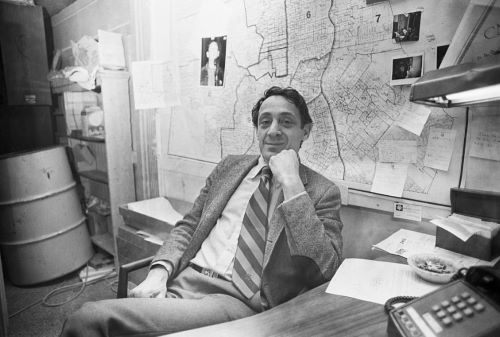
The Temecula Valley school board in Southern California’s Riverside County wants to erase slain gay rights leader Harvey Milk from history.
On May 16, the board voted three to two to ban the use of a social studies curriculum for the district’s eighteen elementary schools because it mentions Milk and discusses the existence of the LGBTQ community and gay rights movement. At the meeting, board member Danny Gonzalez falsely called Milk — the first openly gay person elected to public office in California — a “known pedophile.” Board president Joseph Komrosky said, “My question is, why even mention a pedophile?” as part of school materials. A third board member, Jennifer Wiersma, said, “We can do better.”
The Temecula vote anticipated similar conflicts in Southern California, including a protest last Tuesday outside a Glendale school district building and a protest the week prior at a Los Angeles elementary school. Both concerned public schools’ recognition of LGBTQ Pride Month.
The Temecula social studies curriculum was vetted by forty-seven teachers who taught the material in Temecula’s elementary schools as part of a pilot program last year. Roughly 1,300 students were involved in the pilot program. Few parents responded to a survey asking them for feedback about the curriculum. Nevertheless, Komrosky, Gonzalez, and Wiersma took it upon themselves to cancel the curriculum.
The material has already been approved by the California Department of Education to replace outdated textbooks. The board’s decision could leave 11,397 students without a textbook next year.
READ ENTIRE ARTICLE AT JACOBIN
How San Francisco (?!) Helped Give Birth to Modern American Fascism
Remember Dan White? He was the Kyle Rittenhouse of his day. No wonder Tucker Carlson loves him.
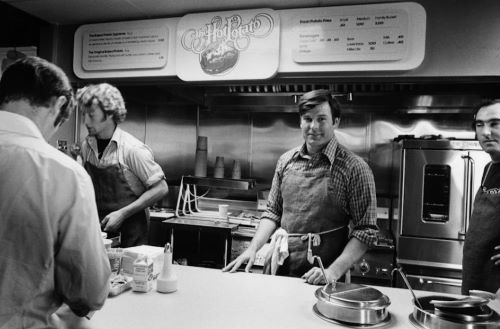
The official Defense Department definition of terrorism—“the calculated use of unlawful violence or threat of unlawful violence to inculcate fear … in the pursuit of goals that are generally political, religious, or ideological”—turns a stunning and largely verboten conclusion into an undeniable banality: The dominant Trump-cult wing of the American right is a terrorist movement. Only a minority of Republican voters behave violently, but Republican leaders in Congress, and the most influential right-wing media personalities, routinely refuse to condemn violence, acting as if far-right terrorism is insignificant.
Given that the U.S. military asserts that the mere threat of violence to achieve political ends constitutes terrorism, it is safe to say—with acts like the kidnapping plot against Michigan Governor Gretchen Whitmer, death threats against election workers and librarians, and of course the January 6, 2021, insurrection—that Americans are currently living in an age of terror.
A spate of recent books attempts to dissect the escalating violence and fascism of contemporary right-wing politics in the United States. Most of the authors, ranging from Vanderbilt University historian Nicole Hemmer to former Republican Party consultant Stuart Stevens, have asked some version of the question that troubles millions of voters: “How could this happen?”
One of American history’s most devastating and significant but little discussed assassinations offers an answer to the mystery.
Harvey Milk was a Jewish American Navy veteran from New York who moved to San Francisco in 1969 to acquire personal freedom and financial prosperity. Through a steady evolution of political priorities that doubles as a reluctant hero’s journey, Milk eventually became the “Rosa Parks of the gay rights movement,” to quote longtime San Francisco journalist Mike Weiss—leading the charge for civil liberties, business opportunities, and political power. After three losing campaigns for office, Milk became California’s first openly gay elected official in 1977, winning a seat on the San Francisco Board of Supervisors. He and George Moscone, at the time the most leftist mayor in the city’s history, promised to remake San Francisco according to the demands of the popular movements and cultural changes of the decade.
READ ENTIRE ARTICLE AT THE NEW REPUBLIC
Why We Can (Partially) Thank the Military for American Gay Identity
How anti-homosexual policies throughout military history helped shape gay culture today.

Navy personnel pose for a picture with drag queen Bianca Sullivan before marching in the San Diego gay pride parade July 16th, 2011, in San Diego, California. (Photo: Huffaker/Getty Images)
Six years after President Barack Obama rolled back the military’s “Don’t Ask, Don’t Tell” policy and welcomed openly gay and transgender soldiers into its ranks, some of its leaders are still remarkably ill-informed about their diverse soldiers’ lives. Last year, for instance, Secretary of the Army nominee Senator Mark Green said the American Psychological Association classified transgender identity as a disease in the most recent Diagnostic and Statistical Manual of Mental Disorders. (It doesn’t — DSM-5 lists “gender dysphoria,” and some activists are calling for that to be removed entirely.) In a 2016 book, Secretary of Defense James Mattis warned that progressive “social change” could undermine the effectiveness of America’s troops, a statement that severalmedia outlets interpreted as referring to Obama’s lift on bans on openly gay and transgender troops, which Mattis has neither denied nor confirmed. (A 2010 report by the Pentagon found that 92 percent of military members who had served with someone who is gay thought unit effectiveness was unaffected or improved by them.)
These comments might strike those who read Ross Benes’ new book, The Sex Effect: Laying Bare the Complicated Relationship Between Sex and our Society, not just as wrongheaded, but as ironic.Benes argues that the military’s exclusion of gay men throughout its history has caused those men to become more aware of how discrimination shaped their identities, leading to the development of gay communities in coastal towns. In other words: Unintentionally, discrimination by the armed forces helped shape gay male culture, and convinced these men to flock to enclaves where they accepted one another, organized, and mobilized.
The Sex Effect’s 10 chapters each centers on a different topic showing how sexuality has interacted (sometimes peaceably, other times with friction) with societal norms and expectations. Discussing unknown histories of monogamy, the relationship between porn and technology, politicians’ sexual affairs, religious pluralism, and unintended consequences of family planning policies, Benes is interested in the myriad ways sex affects our daily lives.
Last month, Pacific Standard talked to Benes about his fourth chapter, “Soldier Sex: How the U.S. Military Inadvertently Helped Form Our Concept of Gay Identity” and how discriminatory policy helped create some of the LGBT communities we know today in America’s old port cities.
READ ENTIRE ARTICLE AT PACIFIC STANDARD
Black Power
Black Panther Women: The Unsung Activists Who Fed and Fought for Their Community
Judy Juanita on her novel ‘Virgin Soul,’ which incorporates her experiences as a Black Panther living in San Francisco.
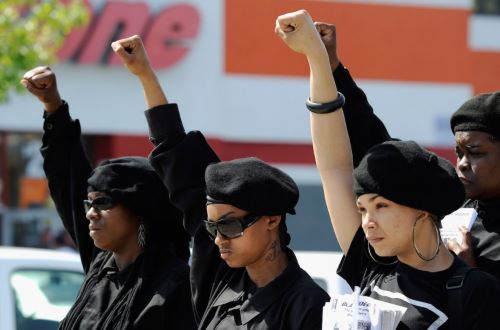
The 50th anniversary of the Black Panther Party for Self Defense was thrust into the mainstream early in 2016, when Beyoncé paid tribute to the revolutionary group during her performance of “Formation” at Super Bowl 50 in the San Francisco Bay Area. The pop superstar and her dancers were decked in leather costumes, with the dancers wearing characteristic black berets and the singer herself sporting crossed bandoliers. Not only did Beyoncé honor a defiant radical organization, she also flipped the gender script: While women accounted for two-thirds of the Party’s membership, the historic images we remember of Black Panthers in militaristic garb are of men.
Much of the reverence—and controversy—around the Black Panther Party centers on its early male leaders, Huey P. Newton, Bobby Seale, and Eldridge Cleaver, respectively 24, 29, and 31 when the Party launched in Oakland, California. Those three young men were both well-read intellectuals in the black nationalist movement and hard-edged revolutionaries, two of whom had recently served time in prison: Newton had done six months for assaulting a black acquaintance with a steak knife, and Cleaver served eight years on rape charges. The assassination of black nationalist trailblazer Malcolm X on February 21, 1965, in New York City compelled Newton and Seale to take a more active stance against white supremacy: On October 15, 1966, the two formed the Black Panther Party as an armed patrol against police brutality toward the African American community, which led to headline-grabbing shootouts in Oakland in 1967 and ’68.
The legacy of the Black Panther Party, however, goes far beyond its complicated, iconoclastic leaders, as illuminated at the Oakland Museum of California’s exhibition, “All Power to the People: Black Panthers at 50,” which runs through February 12, 2017. The organization, which put out an international newspaper “The Black Panther Community News Service” every week for a decade, was a game-changer, forever altering how African Americans saw themselves. In every issue, the newspaper published its Ten-Point Program, which starts with “We want freedom. We want power to determine the destiny of our Black Community.” Behind the scenes, thousands of Black Panther volunteers ran 60-some social programs that fed poor children breakfast, gave away bags of groceries to hungry families, transported sick and disabled people, provided free health care, offered legal aid and drug counseling, and more. The hard work of women was the lifeblood of these so-called “survival programs.”
READ ENTIRE ARTICLE AT COLLECTORS WEEKLY
The Misunderstood Visionary behind the Black Panther Party
Huey P. Newton has been mythologized and maligned since his murder 34 years ago. His family and friends offer an intimate look inside his life and mind.
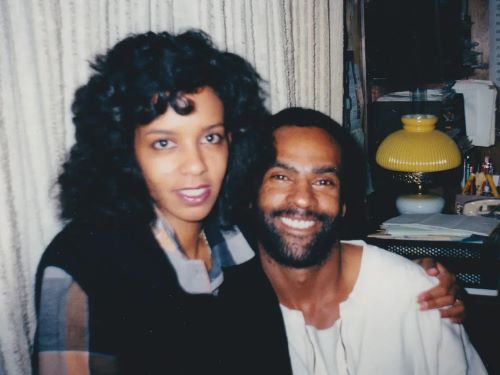
The first time Fredrika Newton saw her future husband was the day he got out of prison. When he came down the steps of the Alameda County Courthouse in California that afternoon of August 5, 1970, a sea of elated supporters surged around him. He made his way through the crowd and climbed up onto a car to make a speech, pulling off his shirt and standing bare-chested in the sun. “Jesus Christ,” Fredrika recalls. “He was gorgeous.”
Huey P. Newton, at 28 years old, was the leader of the Black Panther Party, one of the most influential social movements of the 1960s. When he’d been arrested in 1967, charged with killing a police officer, the group had only a few dozen members. His fellow Panthers eagerly took up his cause, insisting that Huey had been wrongly accused. The slogan “Free Huey” became a rallying cry, emblazoned on posters and buttons. Before long, Black Panther Party offices popped up all over the United States, and Huey became a revolutionary icon like Malcolm X and Che Guevara.
When Huey was released on appeal, some of Fredrika’s activist neighbors convinced her to come along to the courthouse. But she had no interest in joining the movement. She was 18, about to leave for college, and whenever she passed the Black Panther Party’s headquarters in Berkeley, she’d gotten into the habit of crossing to the other side of the street. “I thought they were going to try and recruit me,” she says. “I didn’t feel Black enough. I wasn’t political, and I was shy.”
It was Fredrika’s mother, Arlene Slaughter, who brought her closer to the Black Panther leader. Arlene was a Jewish real estate agent who’d married a Black musician in the early 1940s, when interracial marriage was against California law. The Slaughters had eloped to Mexico, and once they returned to the U.S., they’d struggled to find anyone who would rent or sell them a home. Arlene became a lifelong advocate for fair housing, often posing as the buyer to help people secure loans. The Black Panthers were clients of hers, and she invited Huey over for brunch a few months after his release.
READ ENTIRE ARTICLE AT SMITHSONIAN MAGAZINE
Reconsidering the Black Panthers through Photos
A collection of photos show what life was like within the Black Panthers.
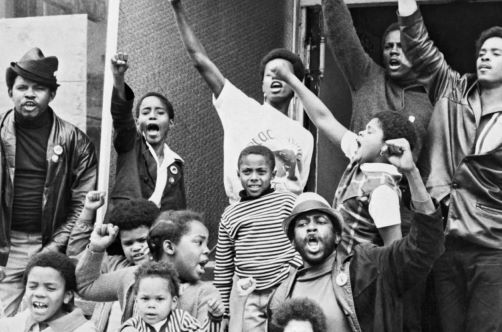
A black man helps an older African-American woman as she shops in an Oakland, Calif., supermarket. The image from 1972, by Stephen Shames, documents an initiative to protect the elderly in a crime-ridden neighborhood. It doesn’t just show community activism, it also challenges lurid media stereotypes about the organization responsible for the initiative: the Black Panther Party.
This is one of many photographs in an important new book by Mr. Shames and Bobby Seale, “Power to the People: The World of the Black Panthers” (Abrams), that help us to better understand one of the most innovative, if controversial, American movements for racial equality and justice. An accompanying exhibition of Mr. Shames’s Panther photographs opens this month at the Steven Kasher Gallery in New York.
Published on the 50th anniversary of the party’s founding, “Power to the People” constitutes an impressionistic visual and oral history of the Panthers. It combines in-depth commentary by Mr. Seale, a major figure within the Panthers; the photographs and observations of Mr. Shames, the group’s principal visual chronicler; excerpts of interviews Mr. Shames conducted with party leaders — including Kathleen Cleaver, Emory Douglas, Elbert (Big Man) Howard, Ericka Huggins, Billy X Jennings and Jamal Joseph — as well as the words of Huey P. Newton and Eldridge Cleaver.
Mr. Shames was a student at the University of California, Berkeley, when he became active in politics. He met Mr. Seale and Mr. Newton in San Francisco during the Spring Mobilization to End the War in Vietnam six months after they founded the Black Panther Party for Self Defense in October 1966.
READ ENTIRE ARTICLE AT THE NEW YORK TIMES
The Black Panthers Fed More Hungry Kids Than the State of California
It wasn’t all young men and guns: the Black Panther Party’s programs fed more hungry kids than the state of California.
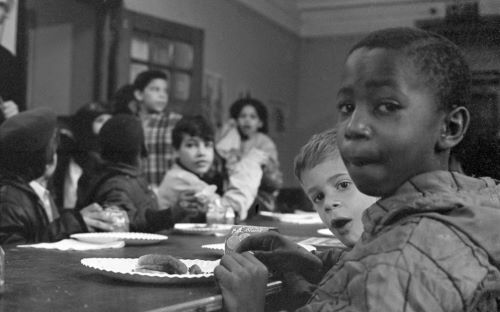
Starting in 1969, and for several years afterwards, in church basements and community centre kitchens in cities and towns around the United States, thousands of kids sat around a table every school day morning, eating hot breakfast served by the young adults of the Black Panther Party. At each seat there was a plate and utensil setting, a cup and a napkin. The children learned to use their fork and knife properly, eating eggs and grits and bacon and toast, washed down by juice or milk or hot chocolate – whatever local businesses had donated that week.
The Panthers – most of them in their late teens and early 20s, and about two-thirds of them women – had arrived at these community kitchens before dawn to prepare this hot meal for the children, serving them and then checking homework, and giving PE (political education) lessons.
‘Who invented the traffic light?’ a Panther would call out.
‘A Black man!’ the children responded.
They also learned that eating a filling breakfast was a right, and that a full belly helped them pay attention in school. The children – most but not all of whom were Black and Hispanic – were taught about Black and Hispanic inventors and artists and leaders, the stories that were (and still are) so often left out of mainstream histories. For many children, this was the first time they learned that a Black or other person of colour could be an engineer or a scientist or an artist.
The Panthers then taught the children to help clear their plates and pack their bags, and then walked them to school. In places where the Black Panther Party offered their Free Breakfast for Children Program, attendance rates and overall academic performance increased.
The Panthers’ breakfast programme addressed a dire need in communities around the country, but it and their other food justice programmes were always about more than feeding the hungry. They saw these ‘survival programmes’ – what the Panthers’ founders Bobby Seale and Huey P Newton called ‘survival pending revolution’ – as modelling their party’s socialist principles.
George Jackson in a Global Frame
The story of George Jackson and his radical politics that challenged the American Government in an age of political repression.
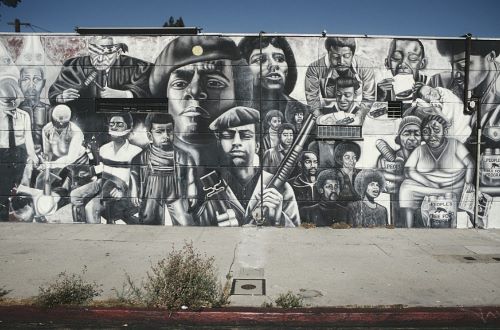
Fifty years ago, George Lester Jackson’s Blood in My Eye dropped like a bomb, but the author did not live to hear it. He had been killed by guards at the San Quentin State Prison six months before the book, his second and last, hit the shelves. Though hailed in the Seventies as a martyr in the struggle by Black Americans within and against the United States prison system, today Jackson haunts discussions of racial injustice and anti-racist social movements from the margins.
The unprecedented surge of protest following the murder of George Floyd in May 2020 precipitated a wave of public reckoning with the violent history of white supremacy in the United States. The legacies of activists, including Angela Davis, organizations such as the Black Panther Party, and protagonists of the Attica Prison uprising have begun to receive their due. George Jackson was part of this matrix and deserves a new hearing, too.
Jackson contributed to the movement in various ways over the course of a decade spent behind bars. He landed in Soledad, a notorious California state prison, before his 20th birthday. Charged with stealing $70 from a Los Angeles gas station, Jackson followed the suggestion of his counsel and pleaded guilty in the state court. For this act of contrition—a practice still encouraged by state-appointed defenders today— he received the draconian sentence of “one-year-to-life.” This term would prove tragically accurate on August 21, 1971.
While Jackson’s name may be familiar to readers of Black Perspectives, he was once a household name around the world. Walter Rodney marveled at Jackson’s resolve despite the vicious repression visited upon him in prison, while C.L.R. James called his letters from prison the greatest contribution to political thought since the death of V.I. Lenin. Jackson’s first book, Soledad Brother, reached the best-seller list in 1970 and was swiftly translated into Spanish, French, and German. Blood in My Eye appeared in five different languages within two years. The campaign to set him free counted Jane Fonda, Pete Seeger, and Dr. Spock among its supporters. In death, he was memorialized in a hit ballad by Bob Dylan. Tributes by Archie Shepp, Steel Pulse, and many others would follow.
READ ENTIRE ARTICLE AT BLACK PERSPECTIVES
My Teenage Years With the Black Panthers
A photographer is reunited with images he made as a young man in the turbulent 1960s.
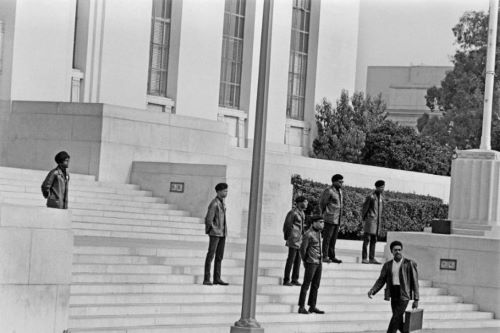
In 2017, my mother died in Berkeley, Calif. When our family was preparing to sell the house, a long-forgotten collection of negative strips was found, revealing photographs I had made as a teenager during the turbulent 1960s in the San Francisco Bay Area. With these aged strips of film my mother had tucked away for half a century, fragmented pieces of my memory have been returned to me like broken artifacts that now can be mended back together for revisiting.
The photographs in this collection start the way so many things do: with a gift.
While just 12 years old, in June 1967, as San Francisco’s “Summer of Love” was unfolding in the Haight-Ashbury district, I got caught climbing out a window of our Berkeley home one night to attend a Jimi Hendrix concert. I was sent to spend the summer with relatives in the Midwest. There, my paternal grandmother, Lillian, gave me a Kodak Instamatic camera and some film; it was meant to keep me busy and out of trouble as we traveled from city to city to visit cousins I’d never met.
Not long after I arrived in St. Paul, Minn., Black communities throughout the Midwest erupted in rebellion. What became known as the Long Hot Summer of 1967 had begun. It was soon after, in Chicago, that I first pointed my lens at an unfamiliar world around me, one where Black Americans were facing injustice and intense police repression. By the time I returned to Berkeley that fall, my worldview had been completely altered.
READ ENTIRE ARTICLE AT THE NEW YORK TIMES
Mothers 4 Housing and the Legacy of Black Anti-Growth Politics
Starting in the 1970s, groups like MOVE and Seeds of Wisdom have fought for the decolonization of urban space.
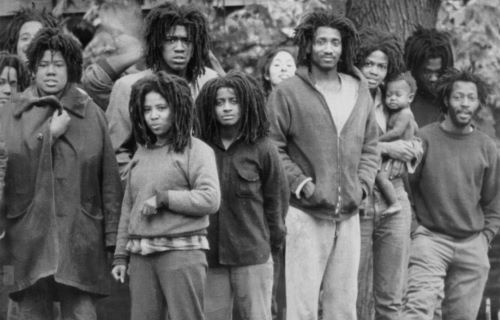
Yesterday at 6 a.m., deputies of the Oakland Police Department violently evicted an organized group of Black mothers, Moms 4 Housing, who had been squatting in a home in West Oakland owned by real estate speculators. Beginning in November, the women commandeered the house along with their children to protest the ongoing displacement of working-class Black communities by developers. Led by Dominique Walker, these women stood up not only for their progeny but also “for everyone in the Oakland community” who they claim deserve a “safe and dignified place to live.”
By refusing to leave, Moms 4 Housing staked a radical claim on the city. Despite the fact that empty housing units outnumber the homeless in Oakland, developers and politicians continue to forward the erroneous claim that speculative development will make for better, more livable cities. In reality, as these women’s ongoing protest brings to the fore, the city is protecting the rights of real estate speculators to profit at the incalculable cost wrought through the distress and trauma caused by intergenerational expropriation from the already property-less. These women’s political strategy is drawing out the contradictions: Oakland, like many other cities across the US, is willing to displace real communities for prospective future residents who have, as of yet, never materialized.
The unjust removal of Moms 4 Housing and their arrest demonstrate the ways that the paradigm of speculative growth privileges profit over the lives of displaced residents from “gentrifying” communities. This shared experience of forced removal across many US cities is of course not by happenstance. From Oakland to Philadelphia, Real Estate Investment Trusts (REITS) and other large-scale real estate managers, organized speculatively, are driving the total redevelopment of urban cores at the expense of the historical communities who sustained American cities while federal and state officials, as well as investors, disinvested from them between the 1970s and the 1990s. REITS, like those transforming Oakland and other cities, were codified legally through a rider bill on the Cigar Excise Tax Extension signed by Dwight Eisenhower in September 1960. Although not utilized at a large scale until the 1980s, since 2008 they have been a major site of investment, growing in returns and capitalization disproportionate to other markets in the aftermath of the Great Recession. According to the 1960 legislation, they are defined as an “unincorporated trust or an unincorporated association … (1) which is managed by one or more trustees; (2) the beneficial ownership of which is evidenced by transferable shares, or by transferable certificates of beneficial interest; (3) which (but for the provisions of this part) would be taxable as a domestic corporation; (4) which does not hold any property primarily for sale to customers in the ordinary course of its trade or business; (5) the beneficial ownership of which is held by 100 or more persons … .”
READ ENTIRE ARTICLE AT BLACK PERSPECTIVES
Red Power
Occupy Alcatraz: Native American Activism in the Modern Era
Fifty years after Native Americans occupied Alcatraz Island, tribes across the country continue to celebrate the protest and the heritage it fought to protect.
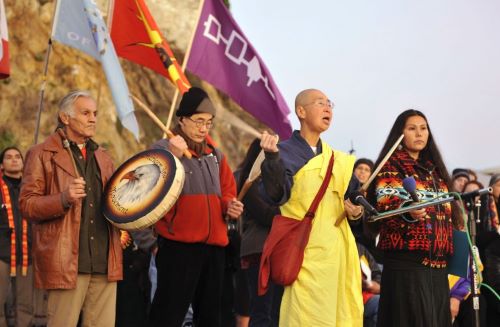
Fifty years ago, dozens of Native American activists occupied Alcatraz Island, an act of defiance against a government they said had long trampled on their rights.
Since the 1950s, the United States had eliminated dozens of American Indian tribes, but changed its policy of termination and assimilation during the Alcatraz occupation, which lasted 19 months. It led to a new wave of activism among Native Americans, one that would go on to include the occupation of Wounded Knee in 1973 as well as the protests against the Dakota Access Pipeline in 2016.
“It turned that whole tide of assimilation,” said LaNada War Jack, a member of the Shoshone-Bannock Tribes. Ms. War Jack was a student at the University of California, Berkeley, and a leader of the occupation. “People were being proud of who they were as Native people.”
To honor their ancestors and the anniversary, Indigenous people from the United States and Canada recently gathered in San Francisco to paddle around the island in what they call a “canoe journey.”
Native Americans sometimes form “canoe families,” a tradition they say helps fortify communal bonds. It is also an opportunity to proudly practice their Native culture on the water.
Rituals like paddling are considered to be acts of resistance, a declaration of heritage that Native Americans say was almost lost during the government’s efforts to assimilate them. It is also considered to be an opportunity to address social ills and to provide healing.
READ ENTIRE ARTICLE AT THE NEW YORK TIMES
This Land is Our Land: The Native American Occupation of Alcatraz
From November 1969 to June 1971, 89 Red Power activists seized the abandoned prison island of Alcatraz, and their own destinies.
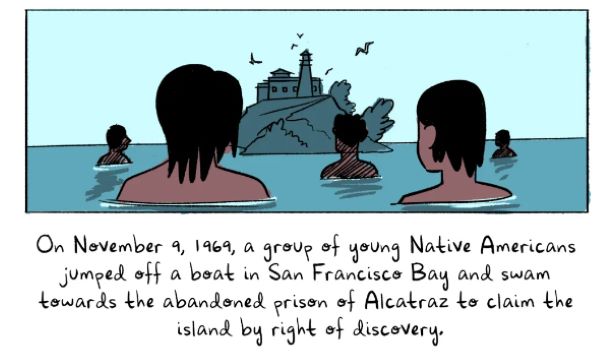
SEE ENTIRE INFOGRAPHIC AT THE NIB
Why Alcatraz Matters to Native Americans
Fifty years ago, the occupation of the island put Indians’ rights on the national agenda
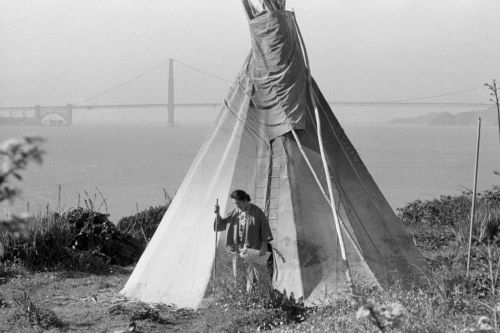
In the same way Montgomery, Ala., is widely viewed as the birthplace of the civil rights movement, Alcatraz Island should be recognized as the launchpad for the current era of Native American rights and activism.
Fifty years ago, on Nov. 20, 1969, a group of Indigenous activists known as the Indians of All Tribes arrived at this former federal prison in the San Francisco Bay. They would occupy it for a year and a half. Protesting the government’s mistreatment of Native people — including a policy known as termination that took tribes’ land and attempted to eliminate their sovereign status — the activists moved into buildings that had housed prison wardens and guards, claimed Alcatraz for all Native American People and scrolled a message on the water tower: “Peace and Freedom. Welcome. Home of the Free Indian Land.”
Richard Oakes, a Mohawk student, ironworker and leader of the group, said of the movement: “Alcatraz is not an island. It’s an idea.” The idea the occupation was meant to convey was this: Just as the Statue of Liberty greeted those arriving in New York, symbolizing this nation’s immigrant roots, those who came through the Golden Gate would encounter Alcatraz, reclaimed as a symbol of Indigenous rights.
READ ENTIRE ARTICLE AT THE NEW YORK TIMES
The Tragic Story of the Man Who Led the Occupation of Alcatraz
A new book traces the role of Richard Oakes in the turbulent but transformative civil rights era of the 1960s and ’70s.
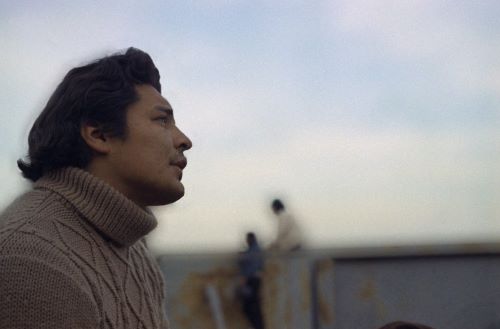
The 1969 occupation of Alcatraz Island in San Francisco Bay is one of the most notable acts of political resistance in American Indian history. In Kent Blansett’s latest book, “A Journey to Freedom: Richard Oakes, Alcatraz, and the Red Power Movement,” he captures the action as it happened: “Dressed in blue jeans, a sweater, and a cherished pair of cowboy boots, Richard Oakes made his way to the side of the boat. Looking over at the waves and the island, he turned to the crowd and motioned, ‘Come on. Let’s go. Let’s get it on!’ Within a few seconds, his shirt was off; his large frame disappeared into the chilled November waters, his boots still on as he swam for the land.”
In the turbulent but transformative civil rights era, the Red Power movement was the American Indian version of what became multiple ethnic nationalist movements that sprang up in the 1960s and ’70s. Inspired by the Black Power movement, which fostered ethnic pride and Black social empowerment, the Red Power Movement led to sea changes in federal Indian policy, resulting in the affirmation of sovereignty and self-determination for tribal nations after centuries of physical and cultural genocide at the hands of Euro-Americans.
One of the most important movers and shakers of the Red Power era was Richard Oakes, who led the occupation of Alcatraz Island. Despite the fact that Oakes passed away in 1972, “A Journey to Freedom” is the first ever biography of his life.
Much has been written about the Red Power movement often revolving around the American Indian Movement and some of its higher profile personalities such as Russell Means, Dennis Banks and others. AIM is often associated with a more militant approach to political activism, such as the 71-day armed siege of Wounded Knee in 1973. But while AIM and Red Power emanated largely from urban (as opposed to reservation) Indian youth, AIM was only one aspect of a larger Red Power movement. Much of the era’s activism, in other words, had nothing to do with AIM. And Oakes was not formally affiliated with AIM either.
Blansett’s biography was 18 years in the making from when he first became interested in Richard Oakes’ life as an undergrad at the University of New Mexico. His meticulous research pays due respect to Oakes’ massive contribution to the Red Power movement but avoids the hubris of hagiography by understanding Oakes as a flawed individual who could be polarizing and difficult.
READ ENTIRE ARTICLE AT THE LOS ANGELES TIMES
The Art of Stealing Human Rights
Native peoples face similar struggles with the federal governments in the U.S. and in Canada.
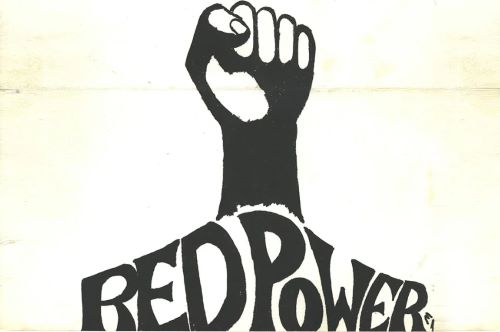
In this episode of Radio Free Alcatraz, John Trudell opens by sharing articles from the Native Alliance for Red Power newsletter from Vancouver, British Columbia, to show similarities between Native People in the United States and Canada. The article is entitled, “The art of stealing human rights,” taken from a speech given by Gerry Gambill given at a conference on human rights at a Tobique reserve in New Brunswick in August 1968. Trudell then shares NARP’s eight-point program for the betterment of Canadian Indians. Trudell concludes this episode expressing United States Indians’ support of Canadian Indians and their struggle, and promotes the next Tuesday’s program with Canadians Jonny Yesno and Shirley Daniels.
WATCH VIDEO AT AMERICAN ARCHIVE OF PUBLIC BROADCASTING
A Top UC Berkeley Professor Taught With Remains That May Include Dozens of Native Americans
Despite decades of Indigenous activism and resistance, UC Berkeley has failed to return the remains of thousands of Native Americans to tribes.
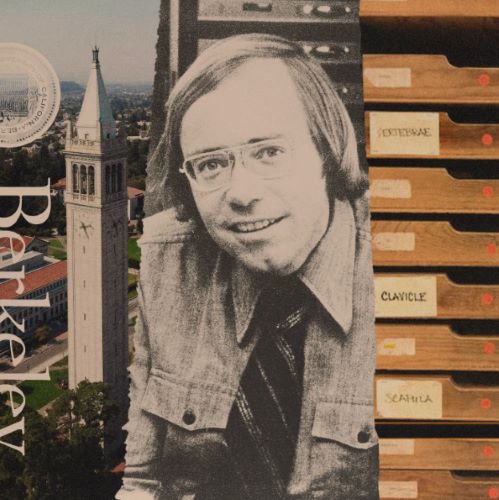
For decades, famed professor Tim White used a vast collection of human remains — bones sorted by body part and stored in wooden bins — to teach his anthropology students at the University of California, Berkeley.
White, a world-renowned expert on human evolution, said the collection was passed down through generations of anthropology professors before he started teaching with it in the late 1970s. It came with no records, he said. Most were not labeled at all or said only “lab.”
But that simple description masked a dark history, UC Berkeley administrators recently acknowledged. UC Berkeley conducted an analysis of the collection after White reported its contents in response to a university systemwide order in 2020 to search for human remains. Administrators disclosed to state officials in May that the analysis found the collection includes the remains of at least 95 people excavated from gravesites — many of them likely Native Americans from California, according to previously unreported documents obtained by ProPublica and NBC News.
The university’s disclosure was particularly painful because it involved a professor who many Indigenous people already viewed as a primary antagonist, according to interviews with tribal members.
UC Berkeley has long angered tribal nations with its handling of thousands of ancestral remains amassed during the university’s centurylong campaign of excavating Indigenous burial grounds.
READ ENTIRE ARTICLE AT PROPUBLICA
America’s Biggest Museums Fail to Return Native American Human Remains
The remains of more than 100,000 Native Americans are held by prestigious U.S. institutions, despite a 1990 law meant to return them to tribal nations.
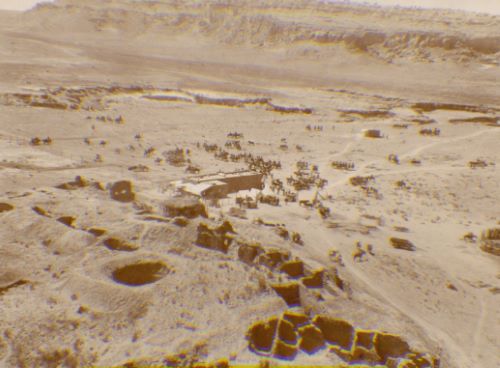
As the United States pushed Native Americans from their lands to make way for westward expansion throughout the 1800s, museums and the federal government encouraged the looting of Indigenous remains, funerary objects and cultural items. Many of the institutions continue to hold these today — and in some cases resist their return despite the 1990 passage of the Native American Graves Protection and Repatriation Act.
“We never ceded or relinquished our dead. They were stolen,” James Riding In, then an Arizona State University professor who is Pawnee, said of the unreturned remains.
ProPublica this year is investigating the failure of NAGPRA to bring about the expeditious return of human remains by federally funded universities and museums. Our reporting, in partnership with NBC News, has found that a small group of institutions and government bodies has played an outsized role in the law’s failure.
Ten institutions hold about half of the Native American remains that have not been returned to tribes. These include old and prestigious museums with collections taken from ancestral lands not long after the U.S. government forcibly removed Native Americans from them, as well as state-run institutions that amassed their collections from earthen burial mounds that had protected the dead for hundreds of years. Two are arms of the U.S. government: the Interior Department, which administers the law, and the Tennessee Valley Authority, the nation’s largest federally owned utility.
An Interior Department spokesperson said it complies with its legal obligations and that its bureaus (such as the Bureau of Indian Affairs and Bureau of Land Management) are not required to begin the repatriation of “culturally unidentifiable human remains” unless a tribe or Native Hawaiian organization makes a formal request.
Tennessee Valley Authority Archaeologist and Tribal Liaison Marianne Shuler said the agency is committed to “partnering with federally recognized tribes as we work through the NAGPRA process.”
The law required institutions to publicly report their holdings and to consult with federally recognized tribes to determine which tribes human remains and objects should be repatriated to. Institutions were meant to consider cultural connections, including oral traditions as well as geographical, biological and archaeological links.
READ ENTIRE ARTICLE AT PROPUBLICA
The History Behind the Movement to Replace Columbus Day
Though the first Indigenous Peoples’ Day was celebrated in the early 1990s, the idea took shape many years earlier.
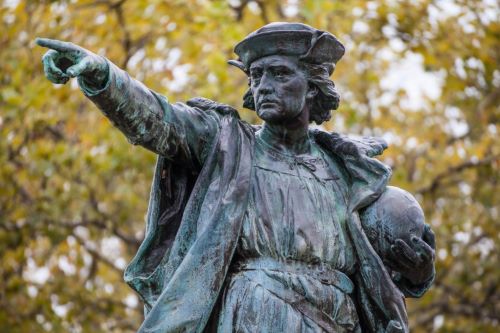
While the Federal Government will close for Columbus Day, which was made official by President Franklin Roosevelt in 1937, some U. S. cities will mark the day in a different way, choosing rather to focus on the original inhabitants of the land to which Christopher Columbus sailed.
Indigenous Peoples’ Day was first adopted by the Berkeley, Calif., City Council on Oct. 22, 1991, and observed the following year with activities and cultural events throughout the city and Bay area in lieu of the Columbus Quincentennial, marking the 500th anniversary of his arrival in the Americas. Its purpose, according to the IPD 1992 event flyer, was, “to express appreciation for our survival, acknowledgement of our contribution to today’s world community, and to commemorate our fallen patriots.” This year marks the 25th annual commemoration in that city, and many other municipalities will follow suit, as polarization around this history deepens in light of discussion of whether public memorials to Columbus ought to come down.
This controversy represents a marked departure from the attitude FDR displayed when he pronounced Columbus Day a celebration of the “promise which Columbus’s discovery gave to the world.” A document that sheds light on how the day was first reconsidered was recently published by the Indigenous Peoples Day Committee to commemorate its diamond anniversary. Indigenous Peoples Day: A Handbook for Activists and Documentary History provides details of the early years of this growing movement.
Though the first Indigenous Peoples’ Day was celebrated in the early 1990s, the idea took shape many years earlier. According to the book’s curator John Curl, the first seeds of the idea to commemorate the histories and cultures of indigenous peoples throughout the Americas in lieu of Columbus Day were planted in 1977, in Geneva, at the first International NGO Conference on Discrimination Against Indigenous Populations in the Americas. The conference included “the first, the widest and most united representation of indigenous nations” in modern history, Curl writes. By the conclusion of the conference, a list of recommendations were drafted, outlining a course of action to support indigenous peoples right to self-determination. And there in Article 1 of the Geneva Resolution was the foremost contention of the conference: a rebuttal to the doctrine of discovery. The conference attendees stated their intention “to observe October 12, the day of so-called ‘discovery’ of America, as an International Day of Solidarity with the Indigenous Peoples of the Americas.”
Feminism
San Francisco’s Queen of Abortions Gets Her Moment of Recognition
Two new biographies look at the life of Inez Burns, an uncompromising and extravagant turn-of–the-century woman.
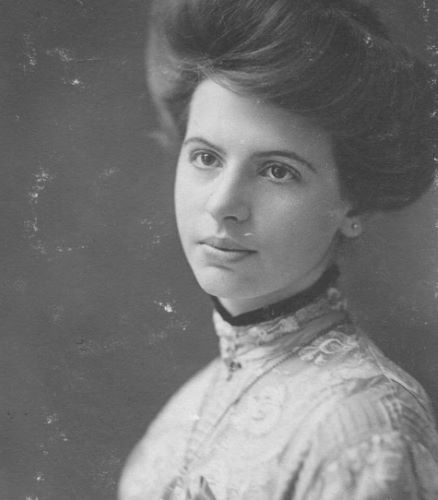
was there, in the relative tranquility of her little cottage in the Women’s Department at San Quentin at Tehachapi and later at the federal prison at Alderson, in the twilight of her sixties, that notorious abortionist Inez Burns had her feminist awakening. More important than making money (and she loved making money), her work helped women to take charge of their bodies in a world controlled almost entirely by men — men who wanted to have their cake, eat it, and then moralize about the wickedness of baking in between visits to their mistresses.
She saw the church and its second class treatment of women as complicit in women’s suffering; all those years of watching Catholic women enter her clinic, trailing six children and desperate to prevent a seventh, left a sour taste in Burns’ mouth, even more so than their legislative efforts to put her out of business. In her eyes, the church was adding generations of misery around the world for the pleasure of men, and making slaves of half of the population by giving men unchecked control over the reproductive systems of their wives, girlfriends, and daughters. What had for so long been purely business had become a crusade for her, and when she got out of prison, she went right back to work.
Burns never met a man she couldn’t charm until she crossed paths with pathologically ambitious attorney Edmund G. “Pat” Brown, who aimed to launch his political career out of the ashes of her empire. He couldn’t have picked a tougher nut to crack — San Francisco’s “Queen of Abortions” was as tough as the steel needles she used to perform her services on thousands upon thousands of women. Burns’s improbable, fantastically scandalous trajectory took her from humble beginnings in a San Francisco slum to a Pittsburgh pickle packing plant, a fateful manicurist job at the ritzy Palace Hotel, and then onto her lifelong career as the West Coast grande dame who — assisted by her team of nurses in crisp white uniforms — provided safe, hygienic abortions on demand to WWI war widows, rape survivors, scorned lovers, Hollywood stars, and the Gilded Age elite alike. She made unholy amounts of money, bribed the cops with abandon, changed husbands like hats, sashayed through theater premieres in Paris couture, had a run in with one of Al Capone’s Mafia thugs, almost certainly dispatched one of her own husbands with arsenic — and she did it all with so much style, cunning, and hard-nosed grit that, for decades, she was untouchable.
Despite her larger-than-life influence, Inez Burns remains an obscure figure in American history, even within the canon of feminist scholarship. The thought of digging up Burns’ secrets and connecting the scattered dots of her extraordinary life makes for an intimidating prospect, considering the secretive nature of her business. (She often employed code words like “glantham” for cash, “Emily” for phantom pregnancies, and “ni-dash” for “don’t you dare open your mouth!” for an extra layer of security beyond her hidden staircase, trapdoors, and private cash reserves). However, the unsinkable Mrs. Burns’ tale of woe and wickedness captivated not one, but two authors in recent memory. 2017 saw the release of Lisa Riggin’s San Francisco’s Queen of Vice: The Strange Career of Abortionist Inez Brown Burns, and this month sees the release of Stephen G. Bloom’s The Audacity of Inez Burns: Dreams, Desire, Treachery, & Ruin in the City of Gold. It’s surely no accident that both books were released within spitting distance of the 45th anniversary of Roe vs. Wade, the 1973 Supreme Court ruling that effectively legalized abortion in the United States.
READ ENTIRE ARTICLE AT THE OUTLINE
The Women and Girls of Telegraph Ave
The women of Telegraph Avenue whose stories remain untold.
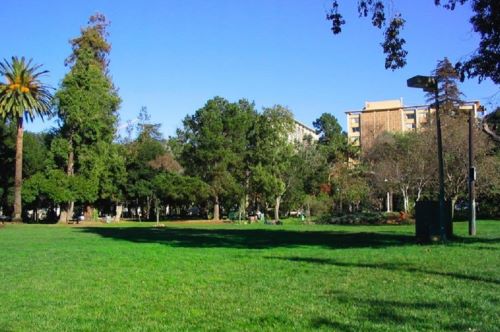
Telegraph Avenue meant many things to the women and girls who lived around it in the late-’60s and ’70s. To a teenage runaway from a working-class family in West Virginia, it was a shot at finding home. To a young girl protected by two stable parents living in Berkeley, it served as a spirited playground. To a troubled daughter of the Free Speech Movement, it offered a sense of belonging, albeit to a community made hard-edged by drugs and desperation.
Though the movement for Women’s Liberation was a larger backdrop to the women and girls of Telegraph Avenue, they generally did not participate in this culture of self-conscious ‘liberation’. Instead, while sampling some freedoms, they found themselves prey to forms of abuse and exploitation, and subject to the ambient sexism of the era. The noted writer Denis Johnson—who lived and scavenged around Telegraph Avenue in 1973—recalled that “Women were always greeted as follows: ‘Hey, what’s happening, got an old man?’ If they had no old man, you then said, ‘Wanna ball?,’ or ‘Wanna get high?’”
Women made the Avenue their home for a variety of reasons, and these strongly shaped their experience there.
READ ENTIRE ARTICLE AT THE BERKELEY REVOLUTION
The Jewel City: Suffrage at the 1915 San Francisco Panama-Pacific International Exposition
Suffragists coalesced in San Francisco to push for nationwide women’ suffrage and send a petition to Congress for the vote.
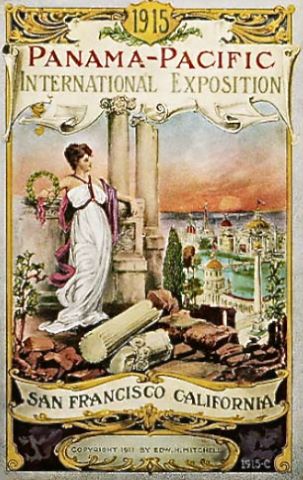
On the evening of Thursday, September 16th, 1915, under a “bright-starred, deep-blue California sky,” more than 10,000 visitors to the San Francisco Panama-Pacific International Exposition (PPIE) gathered in Golden Gate Park to send three suffragists off on an epic cross-country road trip. The suffrage envoys on center stage that evening were Sara Bard Field, by 1915 already a veteran of several western state suffrage campaigns in California, Oregon, and Nevada, and Maria Kindberg and Ingeborg Kindstedt, two Swedish-American suffragists from Rhode Island who owned the brand-new Overland car and knew how to both drive and maintain an automobile. Another prominent national suffrage organizer, Mabel Vernon, traveled by train ahead of the car and connected with local suffrage chapters to set up events, parades, and meetings with mayors and other dignitaries in every major city the envoys visited and, most importantly, to make sure their activities received extensive press coverage. Between September and December 1915 they drove through 21 states from San Francisco to Washington, D.C. with the end goal of hand-delivering to President Woodrow Wilson a petition of signatures gathered in support of a simple message: We demand an amendment to the Constitution of the United States, enfranchising women.
At the celebratory send-off at the fair’s Court of Abundance, a procession of young women dressed in the traditional costumes of Norway, Finland, and other nations where women already exercised the right to vote, spotlighted how the United States lagged behind in the international progress of suffrage. By 1915, women had full voting rights in Finland, Norway, Denmark, Latvia, Australia, and New Zealand, and American women could vote in eleven states, all in the West: Wyoming (1890), Colorado (1893), Utah and Idaho (both in 1896), Washington (1910), California (1911), Arizona, Oregon, and Kansas (all in 1912), and Montana and Nevada (both in 1914). But the denial of voting rights to any U.S. citizens was an embarrassment to a democratic nation trying to display its strength and innovation on the world stage, both at the fair and soon to be abroad in world war. Stretched across the Congressional Union booth at the Expo, a banner reminded visitors: “The world has progressed in most ways, but not yet in its recognition of women.”
The three women, empowered by their powerful purpose, then drove away from the Expo, a choir singing and the crowd waving goodbye:
Orange lanterns swayed in the breeze; purple, white and gold draperies fluttered, the blare of the band burst forth, and the great surging crowd followed to the gates…Cheers burst forth as the gates opened and the big car swung through, ending the most dramatic and significant suffrage convention that has probably ever been held in the history of the world.
READ ENTIRE ARTICLE AT AMERICANSTUDIES
They Called Her “the Che Guevara of Abortion Reformers”
A decade before Roe, Pat Maginnis’ radical activism—and righteous rage—changed the abortion debate forever.
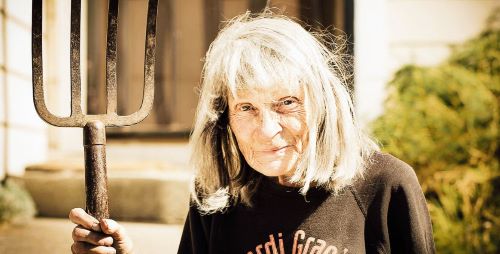
There was nothing remarkable about the small woman carrying a box of leaflets—certainly nothing to justify the clutch of reporters waiting for her across from San Francisco’s Federal Building on a July morning in 1966. Still, there they were. She arrived at exactly 9 a.m., greeted them, and began distributing fliers to anyone who passed. There were two of them: One was a yellow slip of paper titled “Classes in Abortion,” listing topics like female anatomy, foreign abortion specialists, and police questioning. The other—which she gave only to the assembled journalists and the five women who signed up for her class that Wednesday evening—described two techniques for DIY abortions. “I am attempting to show women an alternative to knitting needles, coat hangers, and household cleaning agents,” she told the reporters, adding that she had notified San Francisco police of her whereabouts and plans.
The woman was Patricia Maginnis, a laboratory technician and founder of the Society for Humane Abortion, an organization that she ran out of the front room of her small apartment in San Francisco. She’d started the SHA in 1962 (back then, it was called the Citizens Committee for Humane Abortion Laws). Arguably the first organization of its kind in America, its mandate was radical: The SHA sought to repeal abortion laws, endorse elective abortions, and offer women any resources it could in the meantime. These resources would come to include “the List,” an up-to-date directory of safe abortion specialists outside the country, classes on DIY abortions, and symposia where sympathetic doctors could confer with each other about the safest and best abortion techniques. SHA would eventually formalize its legal strategy with a branch called the Association to Repeal Abortion Laws (ARAL, which would form the basis for NARAL), specifically devoted to challenging legislation.
But on this particular day, and on this particular mission, Maginnis claimed she was acting alone, outside of her organization. The leaflets were her way of knowingly violating both a city ordinance and Section 601 of the California Business and Professions Code, which declared it unlawful to distribute information about abortion. She was also flouting Penal Code 276, which made it a crime to “solicit[] any woman to submit to any operation, or to the use of any means whatever, to procure a miscarriage.” The violation was the point: Maginnis had politely informed the police of her every move in advance. The aim was to goad the legal apparatus into an ugly confrontation that it preferred to keep as merely a threat; she wanted to make the system own the consequences of its laws. “I could get arrested for soliciting women to undergo a felony,” Maginnis told the alt-weekly Berkeley Barb, “but I feel it is necessary at this point to have a test case.” To get a law thrown out, you first need to go to court. And to get to court, you must be arrested.
“It Was Us Against Those Guys”: The Women Who Transformed Rolling Stone in the Mid-70s
How one 28-year-old feminist bluffed her way into running a copy department and made rock journalism a legitimate endeavor.
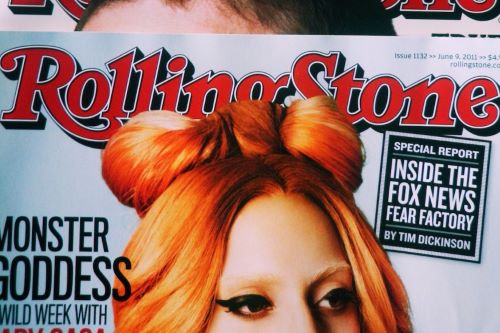
“was just us against the world, and us against those guys.”
In early 1974, Rolling Stone was the epicenter of American youth culture. Not quite seven years into its run, the magazine’s focus had widened beyond the stoned musings of rock stars, and was offering journalistic deep dives into everything from Patty Hearst’s kidnapping to Karen Silkwood’s murder. This period was Rolling Stone’s much-celebrated golden age, a period that helped define New Journalism, breech-birth gonzo journalism, and, quite crucially, formalize rock media’s language, context, and canon.
For the most part, it was entirely men leading this charge. Robin Green was the first woman to write at the magazine, in 1971, but her tenure was brief. In the early 70s, the only women on the editorial floor were secretaries, ambitious young women with master’s degrees and years of experience primarily charged with answering phones. In January 1974, a 28-year-old feminist named Marianne Partridge began to change that, quietly changing the shape of Rolling Stone from inside, and eventually putting six women on the Rolling Stone masthead. Their stories have historically been obscured by the long shadows of the men they worked for and wrangled—Hunter S. Thompson, Joe Eszterhas, Cameron Crowe—but the history these women recall is the story of how Rolling Stone became a true journalistic endeavor, and the story of women learning to speak for themselves decades before topics like sexual harassment and equal pay became mainstream.
“Some of it was about drugs, and some of it was about sex,” recalls Sarah Lazin, who went from editorial assistant to director of Rolling Stone Press over the course of a decade. “But it was really about doing challenging work, and being on the cutting edge of journalism and history.”
READ ENTIRE ARTICLE AT VANITY FAIR
Shouldn’t You Be in California?
The western frontiers of national wellness culture.
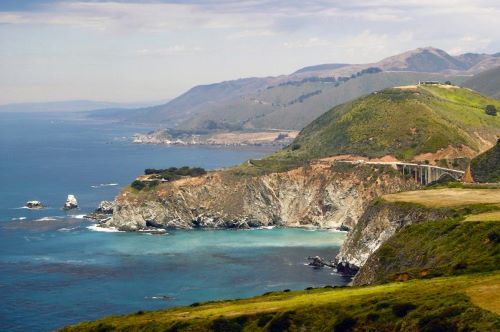
Wellness. In 2018, it’s at once omnipresent and misunderstood—a buzzword from campus health centers to high-end real estate to pet food to preschool marketing. In a culture otherwise riven by stark divides of ideology and sensibility, wellness enjoys weirdly wide appeal. Who doesn’t aspire to “more than the absence of sickness,” as it’s commonly described, even if particular wellness totems, from organic kale to healing crystals, can seem annoyingly bourgeois or suspiciously woo-woo? Notably, the otherwise polar opposite online worlds of the upscale “curated” lifestyle (e.g., Gwyneth Paltrow’s Goop) or right-wing conspiracy theory (e.g., Alex Jones’s Infowars) peddle surprisingly similar wellness products.
The few holdouts that most strenuously resist wellness are disproportionately concentrated among social critics and my fellow academics. In growing chorus, they smartly if at times snarkily point out limits of a vision that emphasizes individual wellbeing over collective action and they snub science. They also illuminate inequality, noting that processed food is cheaper than the greenmarket, making time to hit the gym is harder when you work an unpredictable shift job, and a sage-scented home is indulgent if not outright luxurious.
However valid these critiques may appear to be, they have mostly forestalled an exploration of the specific spaces in which wellness culture originated. Postwar California, ever the American frontier, was hugely important. There emerged a wellness culture defined by the at-times contradictory liberation, celebration, and beautification of the body: At countercultural retreats in places like Big Sur’s Esalen, the feminist self-care clinics increasingly dotting university campuses and ethnic neighborhoods, and Southern California’s multiplying gyms. From countercultural yogis to Bay Area love-your-body feminists and San Diego Jazzercisers, wellness has become so ubiquitous by uniting an unlikely range of players in the embrace of once-marginal mind-body holism and self-care as the basis of the good life. The wellness culture they forged has spread far beyond California the place but remains bound up with California the idea. Reflecting broader social and economic inequalities, wellness culture is not necessarily an engine of such malaise, contra many of its critics, but a potentially powerful counterweight to them. History uncovers these counter-narratives easily obscured in 2017.
READ ENTIRE ARTICLE AT BOOM CALIFORNIA
Monuments, Memorials, and Memory
The Holier-Than-Thou Crusade in San Francisco
The city’s move to rename schools will provide invaluable ammunition to Fox News.
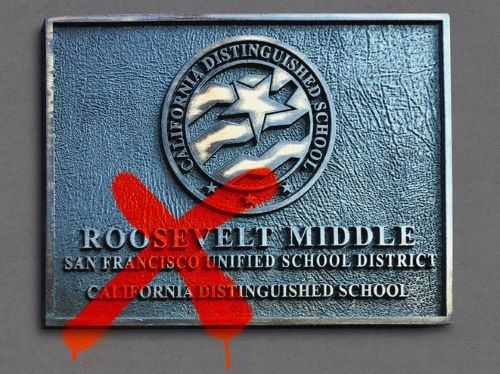
San Francisco has issued its latest grand moral decree, and bad ex-presidents would be quaking in their coffins—if they could stop laughing.
On January 26, the San Francisco school board announced that dozens of public schools must be renamed. The figures that do not meet the board’s standards include Abraham Lincoln, George Washington, Thomas Jefferson, Theodore Roosevelt, John Muir, Robert Louis Stevenson, Paul Revere, and Dianne Feinstein. A panel had determined that the 44 schools—more than one-third of the city’s total—were named after figures guilty of being, variously, colonizers; slave owners; exploiters of workers; oppressors of women, children, or queer and transgender people; people connected to human rights or environmental abuses; and espousers of racist beliefs.
READ ENTIRE ARTICLE AT THE ATLANTIC
This Monument to White Supremacy Hides in Plain Sight
The invisibility of Drake’s Cross in a San Francisco park may make it the most fitting monument to white supremacy in the country.
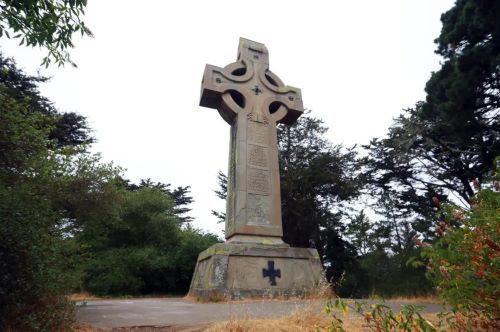
Monuments are symbols, and in times of trouble they prompt symbolic action. They went up as political statements, and they come down as political statements. But it is far easier to topple a monument or change a name than to eradicate racism or counter its long legacy.
In the East, Confederate monuments are the target, but in the West, protesters attack explorers, their sponsors, missionaries, soldiers and settlers. In the past week the California Legislature with uncommon alacrity banished statues of Queen Isabella and Christopher Columbus. Ulysses Grant and Junipero Serra have come down in San Francisco.
But some monuments escape notice. Activists in Marin County, California, have demanded the renaming of places commemorating Francis Drake, an English explorer and naval hero as well as a slave trader and pirate. But so far they have not yet targeted Drake’s Cross (also known as the Prayerbook Cross).
It stands nearly 60 feet tall, sits in San Francisco’s Golden Gate Park and honors Drake. His slave trading has understandably gotten him in trouble, but what Drake is doing in Golden Gate Park is the more interesting question.
READ ENTIRE ARTICLE AT THE NEW YORK TIMES
We’re Getting These Murals All Wrong
The murals have been denounced as demeaning, and defended as an exposé of America’s racist past. Both sides miss the point.
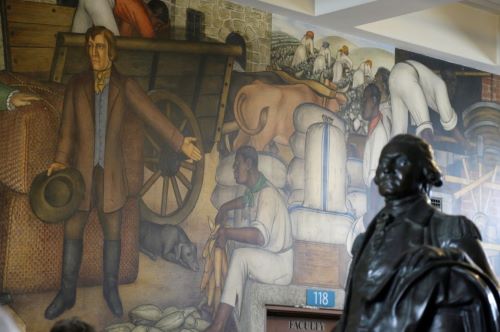
So who are we, really? The answer rests on our interpretation of history and on how we determine the circle of “we.” When confronting the violence of contemporary white supremacists, the “we” is unambiguous, with the history of white supremacy firmly outside the circle. But in the liberal land of San Francisco, where a left-wing artist created a public work that links America’s white supremacist and democratic traditions, things are a bit more complicated.
On June 25, the San Francisco School Board voted to destroy Victor Arnautoff’s Depression-era mural series Life of Washington at George Washington High School because it was deemed racist and demeaning. Some students and educators—as well as school board officials, indigenous groups, and various black and Latinx leaders—have singled out two of the murals, which show enslaved Africans and a disturbing image of a dead Indian. The work’s critics argue not only that it depicts history from the colonizers’ perspective but also that such violent images are triggering. The school board’s decision provoked a national campaign in defense of Arnautoff’s work, with proponents citing First Amendment issues, the importance of historical memory, the failure to grasp the radical intent behind the mural series, and the absurdity of spending $600,000 that could have gone to fund arts education to destroy a work of art.
Related ArticleAfter dozens of editorials, blog posts, petitions, and weeks of rancorous debate, the school board recently struck a compromise that would preserve and digitize the murals but also shroud them behind removable covers. This eminently reasonable solution, however, should not mark the end of what is potentially a fruitful debate over how we interpret the past, who has the authority to do so, and how liberal multiculturalism has shifted our response to historical violence and exploitation. Unfortunately, few on either side of this debate have taken stock of earlier contestations over the murals’ meaning, which bear little resemblance to the current controversy. Looking back at the long fight over Life of Washington exposes a gaping deficit in historical thinking—one that has infected contemporary political discourse and impoverished our capacity to think beyond spectacle.
Culture wars make for strange bedfellows. Conservative New York Times columnist Bari Weiss joined with progressives like Aijaz Ahmad, Wendy Brown, Judith Butler, Roxanne Dunbar-Ortiz, and Adolph Reed in defending Arnautoff’s work. The right sees the attack on Life of Washington as the latest skirmish in the left’s war on America and its symbols and traditions.
READ ENTIRE ARTICLE AT THE NATION
Whiteout
In favor of wrestling with the most difficult aspects of our history.
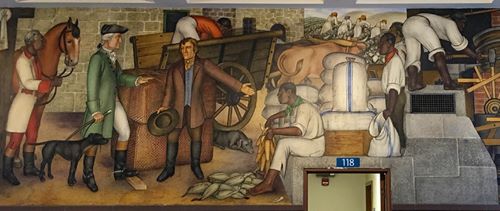
This past spring and summer, political correctness—perhaps inevitably—took a full turn and became a campaign to erase the worst things that dead white men have done in our history. This latest twist in our culture wars was set off not by Republicans or Proud Boys but by the San Francisco school board, social-justice warriors all, who managed to convince themselves that the past was so terrible we dare not even look at it.
The cause of the brouhaha was Victor Arnautoff’s 1936 Works Progress Administration (W.P.A.) murals at San Francisco’s George Washington High School. Arnautoff was just the sort of artist you’d expect a San Francisco school board to love, an immigrant White Russian turned Red. A cavalryman in the tsar’s army, he made a remarkable hegira to California and a new life via Siberia, China, and Mexico, where he worked with the great Communist artist Diego Rivera on some of Rivera’s most magnificent murals.
A confirmed Communist himself, Arnautoff painted murals all over the Bay Area in the 1930s: in post offices and on the wall of a medical clinic, in the chapel of the Presidio army base, in the library of the California School of Fine Arts, and in San Francisco’s Coit Tower. Everywhere he worked, Arnautoff included scenes of struggle, of the fights of working people to form unions, win power, and build a decent life for themselves.
READ ENTIRE ARTICLE AT HARPER’S MAGAZINE
San Francisco Will Spend $600,000 to Erase History
The school board has voted to destroy public murals by a New Deal-era Communist.
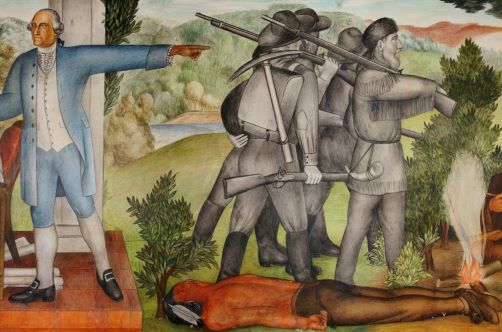
More than $8,000. That was the amount John Ashcroft’s Justice Department spent on blue curtains to cover up the busty Spirit of Justice statue and her bare-chested male equivalent, the Majesty of Law, in the department’s Great Hall in 2002. The Victorian move against the Art Deco sculptures spurred a thousand lampoons. “A blue burqa for justice,” my colleague Maureen Dowd memorably called it. In The Harvard Crimson, a young Pete Buttigieg wrote, “It seems odd that an infant is supposed to feed on them, and a grown man is expected at some point to behold them, but for a period in between we feel the need to see to it that no child ever sees a breast.”
I wonder, then, what Mr. Buttigieg, now on the presidential campaign trail, would make of the San Francisco school board’s unanimous decision on Tuesday night to spend at least $600,000 of taxpayer money not just to shroud a historic work of art but to destroy it.
By now stories of progressive Puritanism (or perhaps the better word is Philistinism) are so commonplace — snowflakes seek safe space! — that it can feel tedious to track the details of the latest outrage. But this case is so absurd that it’s worth reviewing the specifics.
Victor Arnautoff, the Russian immigrant who made the paintings in question, was perhaps the most important muralist in the Bay Area during the Depression. Thanks to President Franklin Roosevelt’s Works Progress Administration, he had the opportunity to make some enduring public artworks. Among them is “City Life” in Coit Tower, in which the artist painted himself standing in front of a newspaper rack conspicuously missing the mainstream San Francisco Chronicle and packed with publications like The Daily Worker.
READ ENTIRE ARTICLE AT THE NEW YORK TIMES
Jonestown’s Victims Have a Lesson to Teach Us, So I Listened
In uncovering the blackness of Peoples Temple, I began to better understand my community and the need to belong.
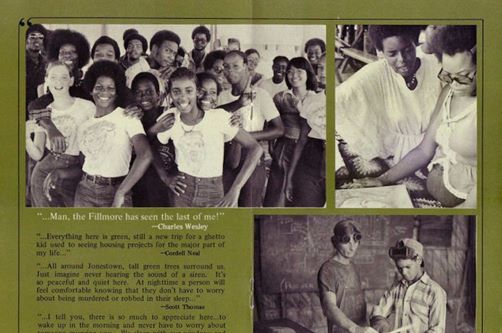
I was home in San Francisco earlier this year when my mom told me that our family had a connection to Peoples Temple.
We had just finished brunch and were crossing Divisadero, one of the main thoroughfares of the Western Addition neighborhood, also known sometimes as the Fillmore, in which we had both been born and raised. I think I must have prompted her on the subject, asked her if she’d realized the 40th anniversary of Jonestown was coming up in November and if she had known anyone who died there. That’s when she turned to me in the cross walk and said quite matter-of-factly: “Of course.”
Then she nodded her head north and told me where the church’s headquarters had been, a short walk from us. I stood next to her, a little shocked, a little eager, a little worried this was all I’d get from her. My mom’s prone to yawn off historical moments, figuring if you’re lucky enough to live through something, there’s no sense in talking about it.
READ ENTIRE ARTICLE AT MOTHER JONES
Collected and curated by Bunk History
